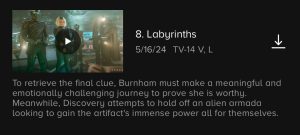
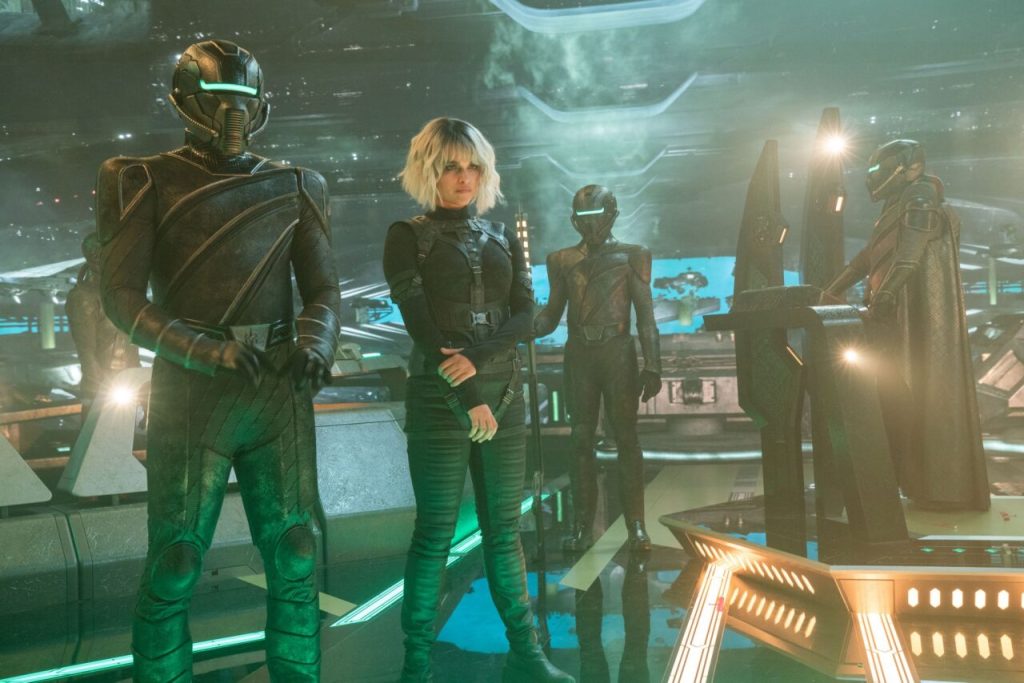

Mary: But it turned out their only protocol was, “Oh, we have your culture’s artifacts.”


Mary: Wasn’t that half the episodes in Season 3?




Mary: But it turned out their only protocol was, “Oh, we have your culture’s artifacts.”


Mary: Wasn’t that half the episodes in Season 3?




Welcome back! I hope you all enjoyed Tuesday night’s celebration of Celtic witchcraft at Night One of Eurovision. (#CrownTheWitch) We’ve got another 16 countries vying for the final ten spots tonight, along with three more previews from the pre-qualified countries (Italy, France, and Spain).
Let’s get into it!
A young woman in a sparkly one-piece does a fun club jam, although the way she repeatedly says “Oh my gawd” in the song is extremely irritating. Good choreography, especially a part where her baggy-pantsed backup boys dance blindfolded.
2. Albania: “Titan,” Besa
I like this power ballad. Her metallic headdress is cool, the lighting is very effective, and the lyrics are good. They have these giant hands on the video wall, though, and I’m not into those.
3. Greece: “Zari,” Mariana Satti
Ok, I do not like this framing device of the TikTok video, and her voice is too high and squeaky at the start. Ha! All a fake-out about how she’s going to do it her way with a funky Mediterranean beat. Eh, this Greek rap still isn’t doing it for me.
4. Switzerland: “The Code,” Nemo
Ok, now this is my jam. I love everything about this: Nemo’s puffy coat made of red and orange feathers, the uptempo rap break, the dramatic lighting, the driving hook, the round teeter-totter thing he’s balancing on. That chorus is going to be lodged in my head all night. Easily my favorite so far.
5. Czechia: “Pedestal,” Aiko
Is something wrong with her mic? She sounds terrible in the live performance. Ah well, there’s always some country who sends an entry who can’t actually sing. Her clone backup dancers are neat looking, though.
Pre-Qualified: France: “Mon Amour,” Slimane
France brings a big romantic ballad. It’s too bad Slimane’s voice is a bit raspy at the start because the tune is nice. He’s warmed up by the end enough to hit those sustained notes, though.
6. Austria: “We Will Rave,” Kaleen
“We will rave,” huh? I wonder what this song is going to be about? Laser lights, techno beat, S&M silver one-piece costume… yep. Title is accurate. Her hair is making me think of a more severe and germanic Ariana Grande.
7. Denmark: “Sand,” Saba
This performance starts with the singer dramatically pouring sand on the stage. Which is pretty literal staging with lyrics about “sand slipping through my hands.” Still, it’s effective and the song is very good.
8. Armenia: “Jako,” Ladaniva
It’s always fun when countries incorporate their traditional music into the song rather than do a generic Eurobop club song. It certainly makes them stand out from the crowd. I liked it! It was fun.
9. Latvia: “Hollow,” Dons
How do you have a giant wheel as your set piece and not run around in it? How can you have a guy in a blue rubber suit sing such a snooze of a song? This is a bit of a dirge and not one of my favorites.
Pre-Qualified: Spain: “Zorra,” Nebulossa
One of the pre-qualified entries. This is an ok club tune, more notable for the light show and the bearded backup boys in corsets than the musicality.
10. San Marino: “11:11,” Megara
This is a nice jolt of energy! It looks like a weird take on Alice in Wonderland, with the singer looking like Harley Quinn changed her color scheme to pink and black. She is backed up by dancing skeletons and killer bunnies and some very cool animation. The band looks like they went to Gene Simmons’s yard sale for costumes. All around classic Eurovision stuff. Love it!
11. Georgia: “Firefighter,” Nutsa Buzaladze
Catchy dance tune with a lot of fire. Sometimes you don’t need to overthink things. Just dance and enjoy it.
12. Belgium: “Before the Party’s Over,” Mustii
The singer stole Dan Stevens’s costume from the Eurovision Song Contest movie. And his ballad is only ok, and not terribly memorable.
13. Estonia: “(nendest) narkootikumidest ei tea me (küll) midagi,” 5MIINUST x Puuluup
Now these guys have some energy! I like the look of the one singer wearing an overcoat with one sleeve missing. They’re working the crowd, and the crowd is into it.
Pre-Qualified: Italy: “La noia,” Angelina Mango
Ok, can’t deny that I love Ms. Mango’s sparkly red corset and the dancers in body suits covered with thorn patterns. And the song is a bop.
14. Israel: “Hurricane,” Eden Golan
Time for a dramatic power ballad. And it’s fine. The singer has a great voice, but the song is extremely generic. (This seems like a good time to note that Eurovision explicitly forbids any kind of political statement song. Keep it light and fun!)
15. Norway: “Ulveham,” Gåte
Another rocking number. The lighting and costumes really make this number work, plus the band seems to be having a great time.
16. Netherlands: “Europapa,” Joost Klein
Time for some classic Eurovision nonsense! Joost is wearing shoulder pads that David Byrne would’ve called over the top. And the performance opens with his giant face on the video screen on the floor. Oh, and there’s a giant bluebird playing keyboard. I have literally no idea what is going on, but I’m enjoying it. And if that isn’t the mission statement for Eurovision, I don’t know what is.
Favorites: Switzerland! What a great song! Also loved the energy San Marino’s deranged Alice in Wonderland song brought.
Least Favorite: Czechia was pretty bad, and Latvia’s snooze fest didn’t impress me. Neither did the rapping Greek.
The Winners: What the hell? The lame entries from Greece and Latvia made it in but San Marino didn’t? Boo, Europe, boo! RECOUNT! (For real, I’m mad about this.)
Joining these two unworthy finalists are Armenia, Austria, Estonia, Georgia, Israel, Norway, Netherlands, and Switzerland (yay).
Will any of these beat my witchy monarch, Bambie Thug, on Saturday? We’ll find out in 48 hours!



Least favorite: It was a pretty strong semi, with no real clunkers. Having said that, Poland and Iceland failed to impress me.
Results: It looks like the rest of the world agrees with me. All of my favorites advanced, a long with Cyprus, Serbia, Luxembourg, Finland, and Slovenia. This was a pretty strong group!
Congratulations to the winners! I’ll see you back here on Thursday! Till then…
Welcome back to the galactic scavenger hunt that is Star Trek: Discovery, season 5! Last week, the clue they found was a vial of water. But! Multiple scans revealed it to be… a vial of water. Consulting with David Cronenberg (and I still cannot get used to seeing my all-time favorite body horror director popping up in this show), they figure out the names of the scientists. Michael thinks the water might symbolize something, and cross referencing with the scientists’ home worlds, they find a desert world near one of them. The world is only habitable in one area, thanks to a cleverly camouflaged weather tower that makes it rain.
But there are of course complications. The weather tower is breaking down after 800 years, so they need to repair it lest it fail and the population dies. Oh, and this also a pre-warp society, meaning they have to sneak around while observing the Prime Directive of non-interference. So it’s time to put on some costumes and try not to tell them all the people that their gods are a lie.

Victor: So I thought this was a classic throwback to the days when Kirk and Picard were always wrestling with the Prime Directive. This usually meant putting on cloaks and Ren Faire garb so they could go look for dilithium or something. So it was promising when the latest clue leads them to the dust world only kept safe by the weather towers our alien scientist secretly installed.


Victor: Yeah, too many.
Mary: Weirdly, I didn’t mind.
Victor: And I still am not sure what they’re doing with Doc Culber and his journey of personal discovery.
Mary: Oh yeah that feels random. I hope it’s leading somewhere.
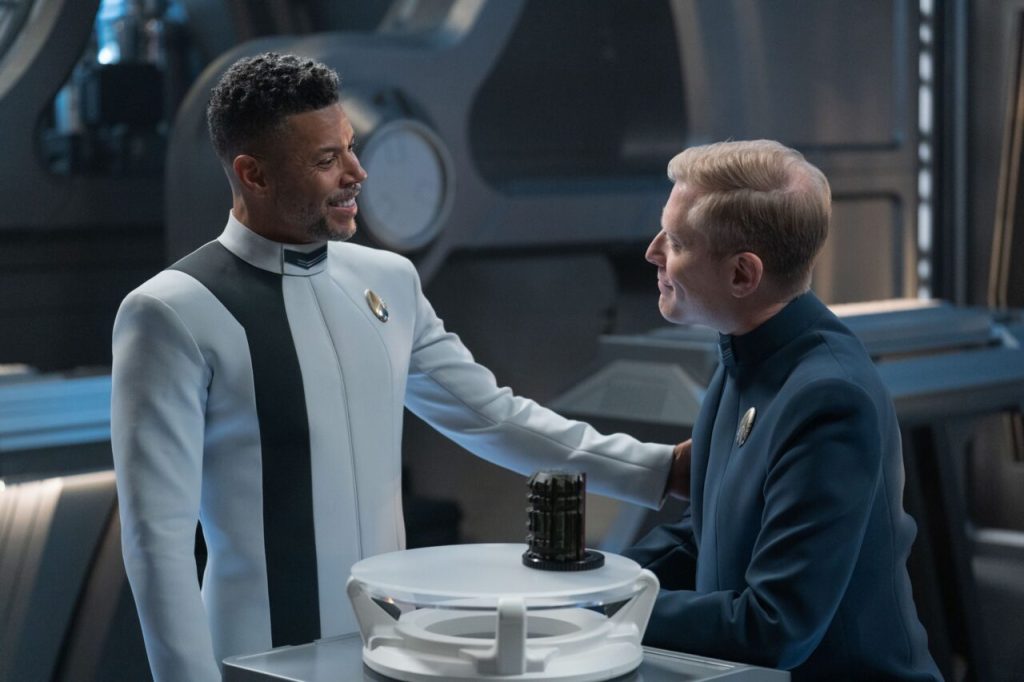
Victor: “Oh, I’m all spiritual now!” Cool, I guess. Eat your mofungo
Mary: Like, they’re planting the seeds for him to do something interesting later. Then again, this is Discovery, and they suck at follow up.
Victor: It just feels so tacked on. If they end up with “Only Culber can run the god machine because spiritual awakening,” I will throw things. But that would totally be peak Discovery.
Mary: Oh noooooooo. You’re so right they totally would. I would still take that over Moll Wants Alien Baby.
Victor: Culber uses the machine to give Moll a baby. And then Michael has a teary monologue about “family.”
Mary: Please stop. It hurts cuz it’s true.
Victor: Man, this show really needs the Cerritos to jump in and burst their bubbles. Now I want Mariner to come in and razz Michael.
Mary: We haven’t talked about Rayner and Adira! That was my fave part of the episode! The curmudgeon and the novice.
Victor: Yeah, it’s nice that he’s taking them under his wing. But don’t soften him up too much. I like salty Rayner.
So, final thoughts? I’m not as high on this one as the past couple. I’d give it 3 stars.
Mary: I’d say 4 again, so want to average it to 3.5?
Victor: I dunno. Maybe we should race to the weather tower to decide a winner…
Rating: 3.5 out of 5
Welcome back, my Disco Fans! (Disco Ducks? Is that something?) It’s time to once again get back to the chase for the Progenitor’s God Engine.
Last week, a Time Bug disabled Discovery long enough for our villains, Moll and L’ak, to get ahead of them and seemingly disappear into space. After Stamets scans the area for all forms of radiation, he discovers a wormhole that seems to be the hiding place of the next clue. Captain Burnham and Book dive on through in an effort to keep Moll and L’ak away from the next clue.
We’ll be discussing the entire episode so if you wish to stay spoiler-free, don’t read this until you’ve watched.
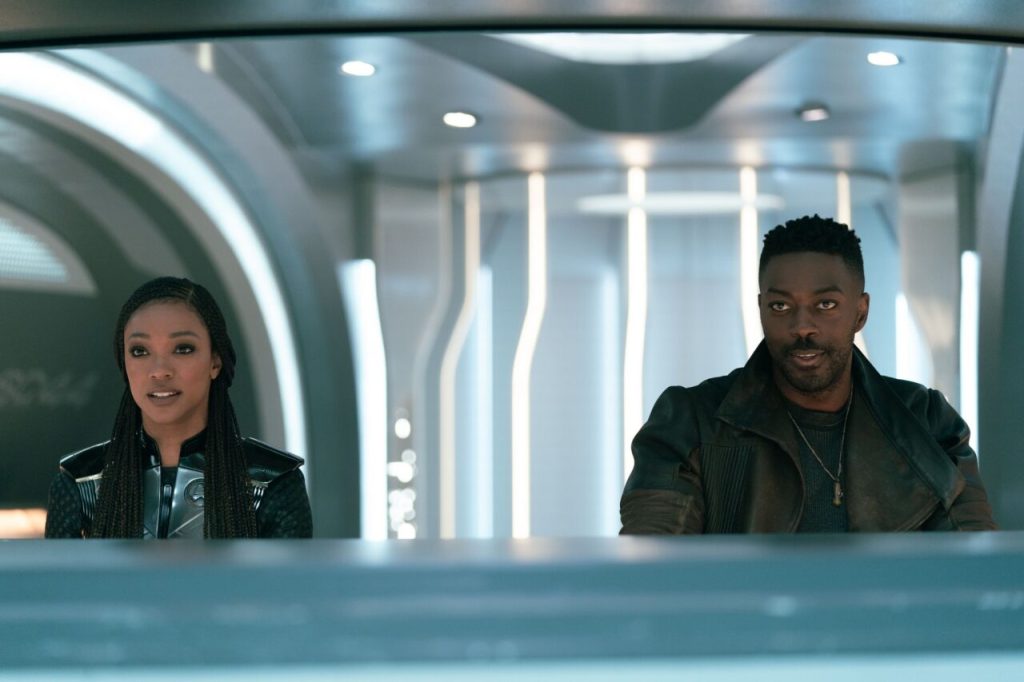
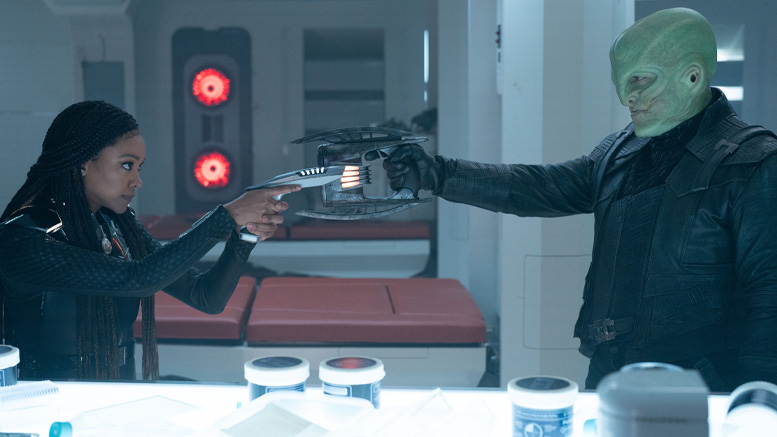
Victor: That’s why you have away teams!!!!!! “But we need Book!” Well Rayner can take Book with him!
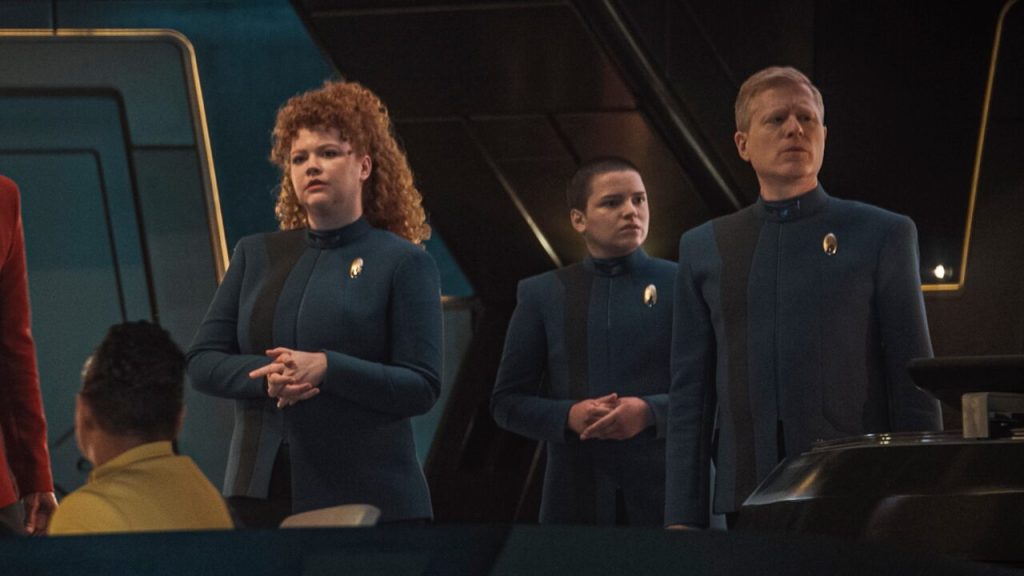
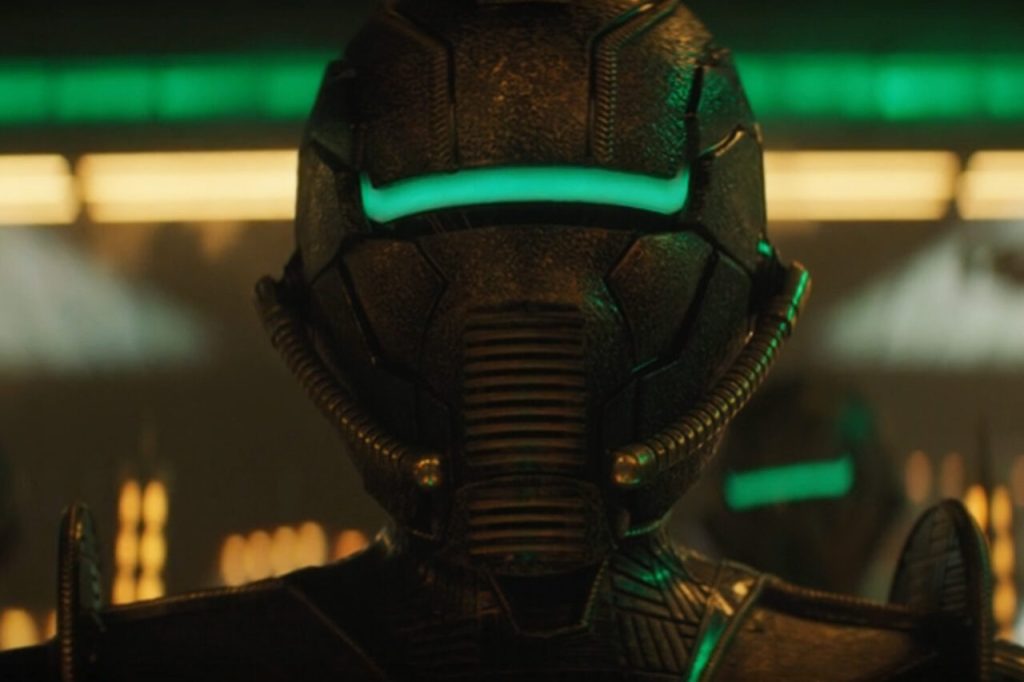
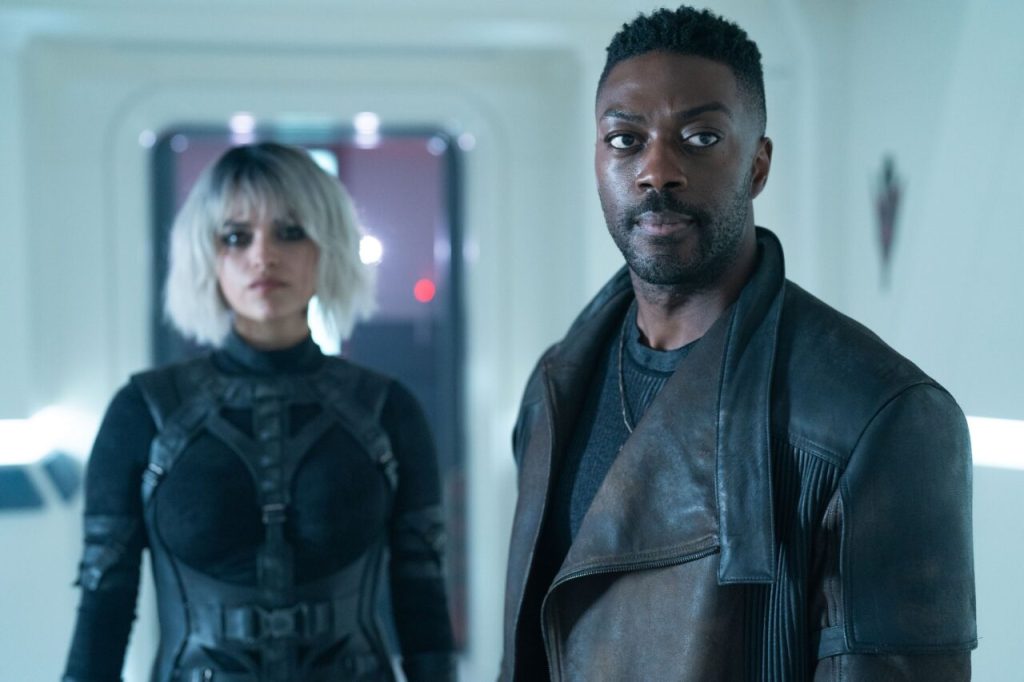
Mary: Yay. Saved by the curve!
“Hip hop isn’t just beats and rhymes…it’s a movement that fought to redefine the times.” And The Graphic History of Hip Hop by interdisciplinary scholar Dr. Walter Greason and Afrofuturist artist Tim Fielder brings that movement to life through text and images, examining a music revolution that unfolded over five decades and continues to unfold today.
The two creators originally met in 2015 at a defense consulting workshop. “We were looking at issue of nuclear weapons,” said Dr. Greason. “And [Tim Fielder] did just spectacular art on reimagining what kind of world we can live in. And, of course, he’s the OG Afrofuturist. So, to see his skill on display was just amazing. So I kept him in mind for whenever I had the next chance to pull an artist in on a project.”
That opportunity arrived in December 2022. “The New York City school system—I’d been working with them for three to four years—they asked me, was I going to be able to put together something on a graphic novel about hip hop history for the 50th anniversary?” explained Dr. Greason. “And I was like, ‘yes.’ And I know exactly the artist I want to work with, reached out to Tim that month, he signed up immediately, and then we start the process of how to draft a script, how to put the content together. I’m so thankful. He loved the vision that I had and improved it immeasurably with the art that he developed.”
The edition for the school district, which incorporated edits required for the students and teachers, was released in November 2023, and an expanded edition is currently available as well.
“It has just been an unending hundred-mile-an-hour rollercoaster ride,” said Dr. Greason. When asked how the graphic novel was received, he replied, “Amazing. Overwhelmingly. Just… people love every page. They get swallowed up in each panel. Yeah, and folks keep demanding more. They can’t get enough, and so I would say, particularly, we’re fortunate that hip hop has such deep resonance around the world, and so we’re tapping into that… All these folks are starving for content about hip hop that’s serious and respectful, that doesn’t treat it like a joke or a sideshow.”
Of course, creating a book around such a beloved subject meant a lot of feedback.
“Everybody has an opinion,” said Fielder. “My cousin bought two books the other day, got them in the mail, ‘Hey Tim, so I have to say to you, man, the artwork is boss! But story, the way it was presented…’ And everybody has an opinion on what hip hop is. And it’s never-ending. And this will range from cousins all the way to executives at Fortune 500 companies. Everybody has an opinion.”
Fielder’s own experience with hip hop has been a lifelong one. “So I am a guy who emanates from the Black rock music scene… That was the thing I was into… Fishbone, alternative music, I’d be listening to Jimmy Heath, you know, jazz, that type of thing… but I was always around hip hop… I’d oftentimes have to do editorial illustrations for the publications I was working with that would range from the Village Voice and things like that. But I also did mainstream comics through Marvel Comics. So hip hop was always there. And I did an unpublished 63-page fully painted graphic novel called Dr. Dre, Man with a Cold, Cold Heart. Never published, right? So I’ve been around the form my entire life.”
Dr. Greason grew up with hip hop and considers it a defining feature of his life. “I was born a week after Kool Herc’s first party, grew up in New Jersey, bouncing between farm communities, suburbs, and cities like Camden and Newark. And so my whole life, by the time I was five, with my first exposure to Sugarhill Gang, and then from there… five years later, 10 years old, is ‘Roxanne, Roxanne.’ It’s that first wave of original artists breaking through and getting their initial record contracts. And really identifying with shows like Video Music Box, Fab 5 Freddy, going to parties to interview people… That culture shaped me as a preteen and a teen.”
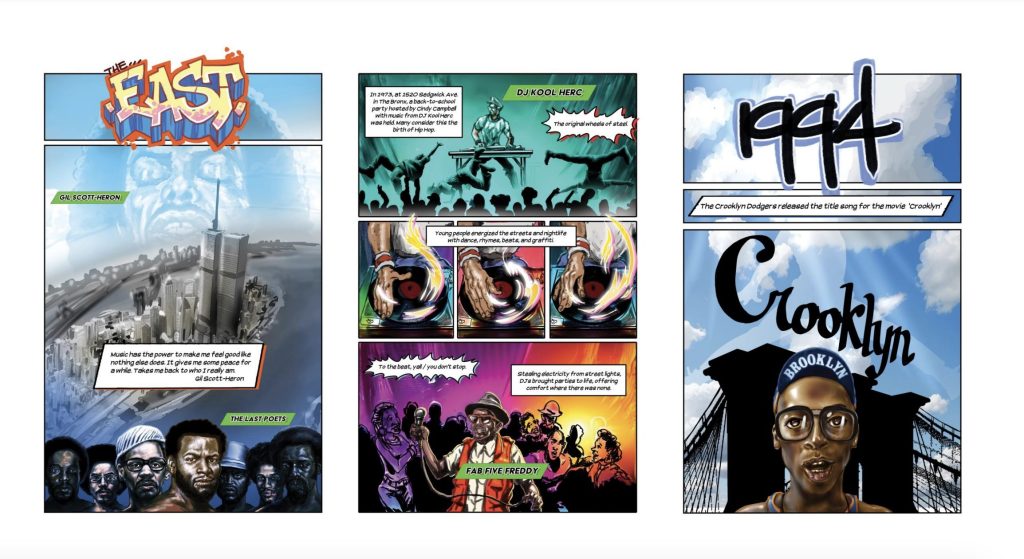
The Graphic History of Hip Hop aims to bring that culture to life is through the use of lyrics and vivid imagery, including images of a break dancer in the corner of each page, which animate when one flips through them.
“That piece is really the foundation,” said Dr. Greason. “If you don’t have an experience with the music, and you come across the James Brown lyric, you’re not going to have the same sense of what’s happening on that page. Like, you kind of have to hear the sound to go with both the history and the visual. And then beyond that, Tim is absolutely a genius about giving places for the audience to show up in the text… [when] you’re seeing the big crowds dancing at the dance party, when you’re seeing people in different kinds of classrooms, just learning about the topics, these places where we’re seeing… There’s just all these layers of features that allow everyone to bring their own voice, their own perspective to the experience of looking through this text. And so that’s what I feel like is really unique, even in this really popular field now of graphic history, is that it’s layers of interpretive challenges that you can come back to again and again and always learn something new.”
Going beyond music, The Graphic History of Hip Hop also examines the movement’s impacts on history, both past and present.
“By the time I was in college, like, ’90, ’91,” said Dr. Greason, “I remember sitting around all white classmates, watching… Public Enemy has a video, and it debuts on MTV, and those jokers are just shocked that they’ve got to deal with the fact that Black people are not going to accept second-class treatment. They’re going to go about pursuing and enforcing civil rights laws and anti-discrimination clauses. They’re going to defend programs like affirmative action. This whole battle that we’ve now seen culminate with the Trump Administration and the backlash that came out of January 6, this has been going on in Black communities for, at minimum, if you’re conservative, you say two centuries. My colleague Nikole Hannah-Jones, 1619 Project, draws it back over four centuries. And so this work of evolving and bringing a social critique that actually honors and enforces a perspective about the African American experience, and really African diaspora, because we deal with anti-Apartheid, we deal with Pan-Africanism, these are all hugely influential pieces of our global society that hip hop is at the center of. So, for me, this is just who I am.”
The Graphic History of Hip Hop brings these connections to life through a timeline feature that Dr. Greason generated.
“It’s pretty ingenious,” said Fielder. “Initially, it was like, ‘Yo, man, just, like, come up with 10 timeline dates if you could. Just to have it.’ This dude comes back with 45 years’ worth of timeline features! But it’s not all hip hop. Some of it is talking about the death of Martin Luther King. The death of Robert Kennedy. Culminating in the election of Richard Nixon, right? But then when does hip hop start? 1973… Who has to resign from office that same year? Richard Nixon… Hip hop integrates through history because hip hop is essentially human history. Part of history. It is history. And it’s a living document that we’re writing as we go along.”
By integrating music history with political and social history, The Graphic History of Hip Hop puts the movement in the context of the wider world.
“A lot of people are used to the stories about Kool Herc and the street parties, but before we ever get to that, we’re telling the story of civil rights and Black power,” said Dr. Greason. “We’re talking about the actual political and social history that leads up to 1973, and then continually, we’re covering the way the society is changing through the 1980s, through the 1990s, why hip hop grows as a phenomenon and becomes more of an industry by the time you get to between 1994 and 1997. And then we confront, really, something that no one’s ever talked about… this industrial shift that provokes Nas to say ‘hip hop is dead’ in 2006. That the heart of the culture was no longer functioning in the same way at the end of the 20th century and into the early 21st century.”
Fielder and Dr. Greason aim to explore more of that living history—and hip hop’s place in overall history—in the second two volumes of a planned three-volume series. The school edition of the second volume will be done by the end of 2024, with expanded editions out next year.
The Graphic History of Hip Hop, volume one, tells the story through the “hip hop is dead” moment in 2006. Dr. Greason explained, “That lays the foundation for our second and third volumes, where we confront: How does the culture become an industry? And how does the content change? And so even today, we see Nas and DJ Premier drop a new single called ‘Define My Name.’ That’s at the heart of the debate about what hip hop should be going forward. And what is the role for hip hop empowering teenagers and young people the way it was when I was coming up, versus the voice of the people who are my age now? Who are 40, 50, 60 years old? Hip hop is a terrain that has brought the world together in ways that exist outside of our mainstream political and economic institutions. And that’s what we hope to capture, in lots of different layers, in this graphic history.”
While the second volume is still undergoing edits, its planned structure is a reverse timeline that looks back from 2023 to 2006, and a bit into the 1990s as well. “We look at the growth of the industry,” said Dr. Greason, “and we also see the suppression of different independent artists, people who are still in the streets, struggling. And how there’s a disconnect between folks that are producing the art and trying to keep the culture alive, but at the same time can never reach the global audience. They’re not getting the mass marketing through radio and streaming that have become more common. And so there’s a tension that runs throughout Volume Two about commercialization, and how does that affect the way that different cultures evolve in a global marketplace.”
The third volume will expand the scope even further: going back 5,000 years to look at world music history overall, the origins of music as human expression, “and then situating hip hop in that story, and using hip hop as a frame to tell overall music history, while also respecting hip hop,” said Dr. Greason. The volume “is this much more ambitious, long view of what’s happened, and why music is so important to all of us.”
For Fielder—who started in comics in the 1980s, moved into video games and animation around 2000, and returned to comics about 12 years after that—the experience of watching the industry around graphic novels evolve has been an interesting one. “The most prominent aspect of graphic novels is the growth industry in the trade book industry,” he explained. “And then [within] graphic novels itself, you have middle grade and YA, and then you have now graphic history.”
Seeing an opportunity, Fielder and Dr. Greason formed The Graphic History Company, along with Christina Hungspruke, a Managing Partner who also handles Marketing and Communications.
“I was shocked the URL was available… No one created a company called the Graphic History Company?” said Fielder with a laugh. “It’s been a wonderful collaboration because I come from a world of independent comics where you’re doing everything by yourself… I would say this has been one of the most educational experiences for me as an independent operator, Afrofuturist, but also just… Look, I put out two books before: one mainstream, one self-published through my company. And I’ve had all kinds of experiences. I have never experienced anything like The Graphic History of Hip Hop.”
Working on The Graphic History of Hip Hop came with unique challenges for the artist, who describes the graphic novel as “easily the biggest project of my career.”
“This is not a story that can be told simply,” said Fielder. “This is a story that has to have a complex layout, complex images, because it’s dealing with people who are still alive, some not with us, from all different walks of life.” It required “an immense amount of portraiture,” and Fielder estimates that he drew at least 200 rappers for the expanded edition.
“[It was driving] the folks at the DOE crazy at one point, that you keep adding and adding and adding more and more detail because the subject demands it,” Fielder said. “The subject demands it, and this guy [Dr. Greason] is one of the preeminent scholars of the form. I wasn’t about to let him go out there without that visual being there. That’s the magic and power of graphic history, and I know there are those out there that try to suggest that, ‘Well, you know, we just write books. We don’t do graphic histories.’ Graphic histories are just as relevant as prose scholarship journals, I submit. I know I’ll be lit on fire for that, but I don’t care! I think graphic histories are just as important and they have the opportunity to have a dramatically greater impact. Because it is a fusion of the written and the visual narrative.”
Finding acceptance for the graphic novel among scholars and academics has been a challenge at times.
Dr. Greason recounted, “Just at this last conference I was at in New Orleans, [scholars and academics] came up to me and were like, ‘Well, we can’t be expected to understand or interpret visual content alongside what’s written.’ Like, ‘that’s all we’re trained to do.’ I was like, ‘No, there are hundreds of scholars out here who can do both the writing and the visual art component to evaluate this work and determine its worth.”
“Hip hop is a crazed onion,” said Fielder. “It’s like layers and layers of crazed onions… And to do it the way we’re doing it, our focus is not necessarily just biographical hip hop—which is important, don’t get me wrong—it’s the geopolitical aspect of things to show how hip hop, as a form, integrates into the deeper American and world culture. How it affects politics.”
While the focus is currently on the three volumes of The Graphic History of Hip Hop, Dr. Greason spoke of further plans for the Graphic History Company.
“One of the fundamental critiques is that history is too often removed from popular criticism, and people call it ‘his story’… it’s not something they see themselves in or a part of,” he said. “And that’s the thing that we’ve really placed at the center of this graphic history, is that it’s a way for everyone to see themselves and be part of it, and we’re open for their voices to continue to grow… The whole point of having the Graphic History Company is we want all of the voices to come forward and share the stories that we don’t typically hear.”
The Graphic History of Hip Hop is now available to order online at https://graphichistoryofhiphop.com/
Dr. Walter Greason and Tim Fielder will be at Schomburg’s 12th Annual Black Comic Book Fest on April 26th and 27th.
Welcome back, fans of Disco! This week, Discovery’s quest to find the Progenitors’ tech hits a speed bump… well actually, more of a time bump. It turns out that the tracker that Moll planted on Adira last week was actually a literal Time Bug, a black market device designed to trap Discovery in a time bubble, where the ship goes back and forth through time from when it was being built to the end of its existence. This is to keep Discovery from the next clue so our villains can jump ahead.
Because Rayner and Burnham were trying to teleport the exact moment the Bug started the time jumping effects, they are outside of the time stream enough to be aware that they are being flung through time. Now, the two officers must put aside their differences to work together to fix things and keep Moll and La’k from getting too far ahead.
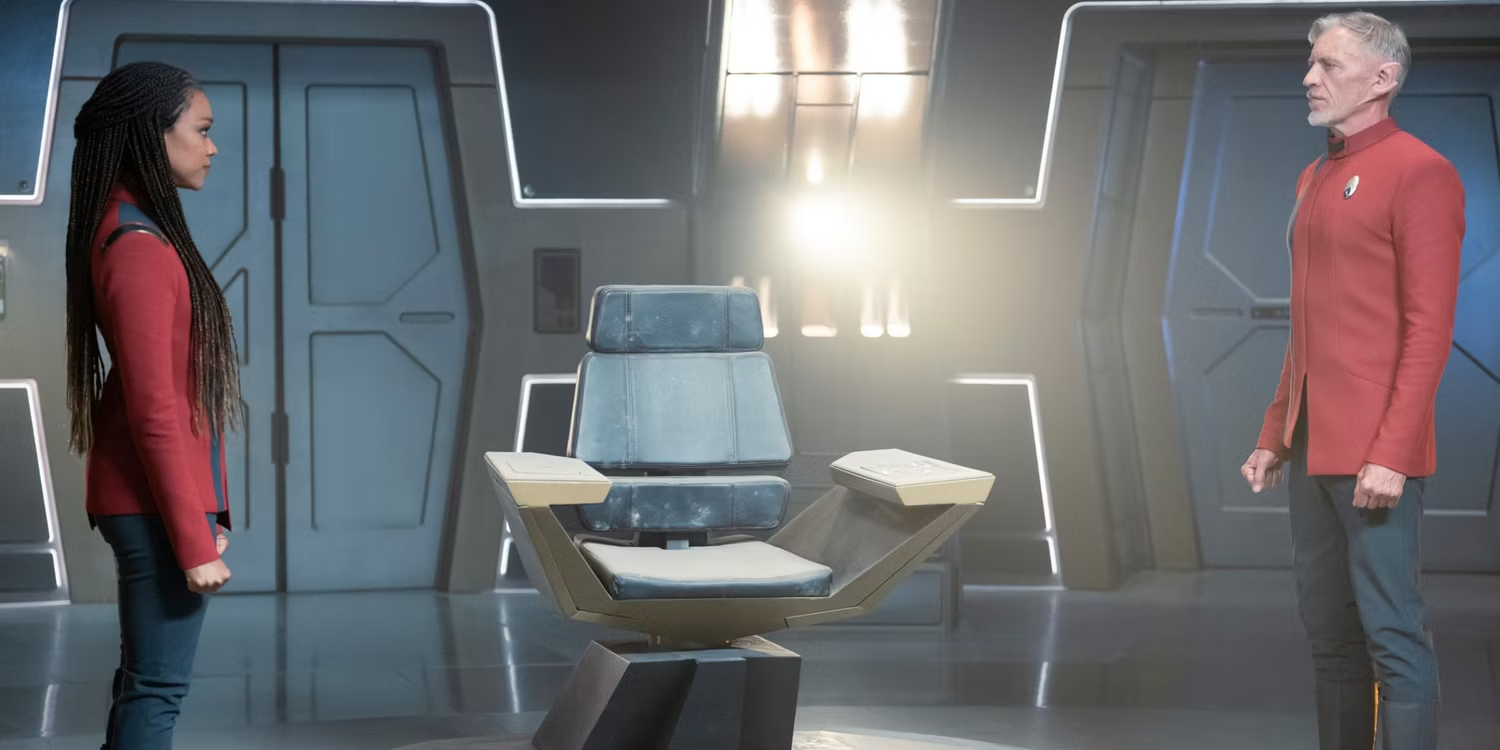
Victor: “We are so special because we work together and respect our diverse viewpoints.” Rayner has a point about chain of command, and how he’s not here to make friends.
You’re in a quasi-military organization! You don’t get to put every decision to a vote!
Mary: Exactly. We also haven’t seen any true disagreements, where Michael has to make a judgment call that makes someone very unhappy.
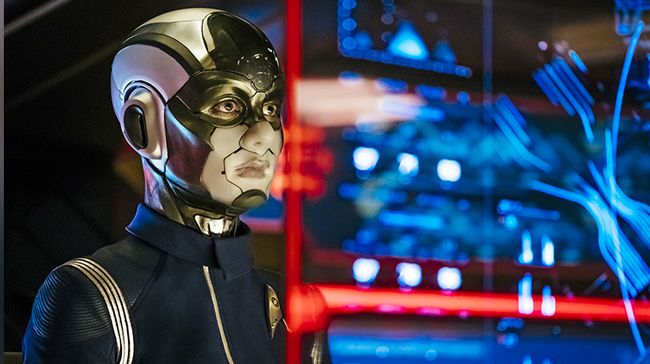
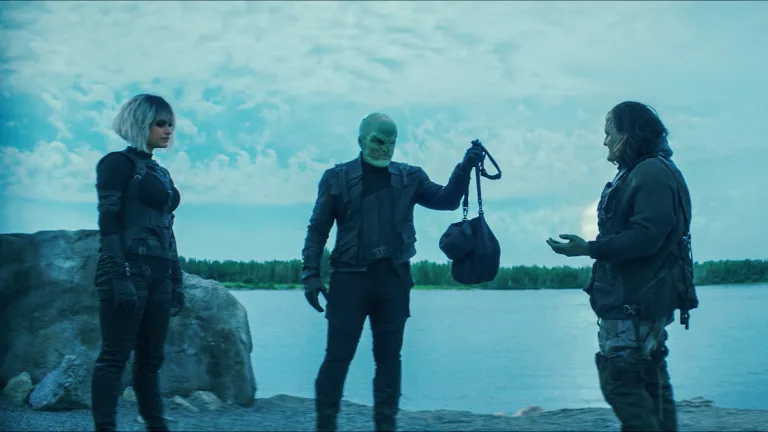
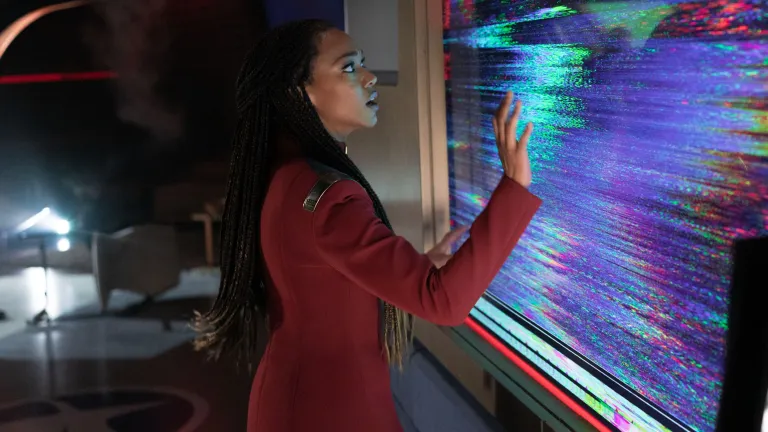
Rating: 4 out of 5
Creature Features really live and die by their creatures. That seems obvious, but it’s kind of amazing how many movies really don’t grasp that concept. For every Alien or Godzilla, there are a whole bunch of Velocipastors and Sharknados. For every Jaws, there’s a dozen Jaws 3D.
So by having some of the freakiest and most unsettling monsters I’ve seen in a movie in a while, Arcadian has already won the battle. I am not kidding. These are some nightmarish creations—a mix of spiders and wolves and cockroaches with extendable limbs and claws. Which is great, because that helps paper over the pretty standard issue post-apocalypse survival plot.
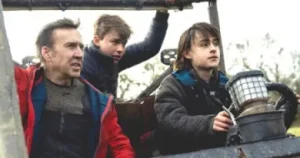
Nicolas Cage stars as Paul. On the day the world was ending, he found two babies while scavenging and he brought them up on his rundown little farm. Fifteen years later, the boys are growing up. Thomas (Maxwell Jenkins) is eager to see life beyond the narrow confines of the farm, especially their neighbors, the Roses, who have a pretty teen daughter named Charlotte (Sadie Soverall). Joseph (Jaeden Martell) is more introverted and prefers to spend his time fixing up the items they scavenge, like a broken down golf cart, and trying to study the creatures attacking them. But they both have to be back inside at sundown, because that is when “they” come out.

“They” are the aforementioned monsters. Night after night, they scratch at the boarded up windows and dig their long claws under the door frames, trying to get in. They seem to have limbs that continually unfold and extend, with claws that can grow and grow. Traveling in packs by clumping into a ball and rolling around, when they get close, they start clapping their jaws in a rapid fire way that seems to mesmerize their prey.
No one is really sure where these critters came from. There are a couple of theories mentioned, but those are in the context of a game the teens play—”badly describe the apocalypse in ten seconds”—and they seem to tell something about a bug getting mutated by pollution and then those bugs attacking humans. It really doesn’t matter. This isn’t the kind of movie where plucky youngsters find The Cure or something. It’s all about surviving.
The director, Benjamin Brewer, is either very savvy or very lucky and I can’t quite decide which. There is a lot of handheld shaky-cam, which is an irritant at first, but then it really helps to obscure the monsters and make them even more frightening, with their black fur waving as they skitter about. He really likes to foreshadow events. Thomas leaps over a crevasse every time he runs to the Roses’ farm, and the way the camera lingers on the rocks on the edges you know exactly what’s going to happen, and sure enough, Thomas falls in. But that foreshowing pays off in spades later on with lingering shots of a window lock that doesn’t quite latch, and that definitely does not go the way you’d think.
This is Brewer’s first feature as a director. He previously worked on the visual effects for Everything Everywhere All At Once, which helps to explain why he got such great monster effects on a tight budget.
The actors all acquit themselves well. Cage is in restrained mode here, playing the concerned parent. He’s great as usual, but the film could’ve honestly used a jolt of the Vampire’s Kiss Rage Cage at times. The two teens—Jenkins and Martell—are both good, doing a lot to establish their bond as brothers who love each other despite their bickering and wanting very different things. Still, there’s a lot of fairly predictable apoca-plot to get through. (Someone gets hurt. Some people aren’t as nice as they seem…)
Still, the monster moments are terrific. I’m going to be thinking about their clacking jaws and endlessly unfolding limbs for quite a while.
Rating: 3.5 out of 5
After a strong start to the final season, episode 503, “Jinaal,” has our crew on the trail of the Progenitors’ mysterious tech. Let’s dive right in, with my co-reviewer, Mary Fan.
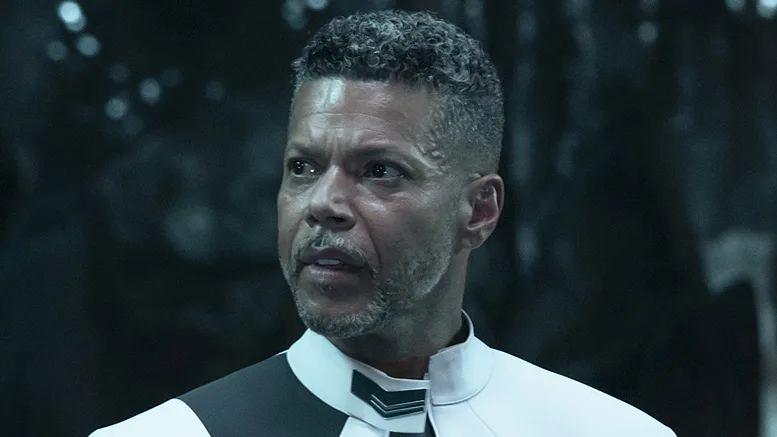
MARY: So we’re continuing the treasure hunt this week, with Discovery heading to Trill to find the next clue to the progenitors’ super-tech. With the whole season being set up as a treasure hunt, you can expect a riddle right off the bat, and that’s exactly what we get. And with this being Trill, naturally we see an old host’s personality emerge, which was a delightful acting exercise for Wilson Cruz. I gotta say, I was underwhelmed by the overall plot of this episode. I found it really predictable. But it was worth it to see Wilson Cruz embody a laid-back Trill host.
VICTOR: Wilson Cruz was having a lot of fun this week. “Oh, this body works out!” But yeah, I agree, although I was more annoyed than underwhelmed. There are about four B-plots this week, and none of them are very engaging. And the A-plot of finding the clue was no great shakes either.
MARY: I gotta disagree on one thing. I found Rayner’s subplot delightful. It was nothing unexpected, but I just enjoy watching a curmudgeon be a curmudgeon while Tilly looked on in horror.
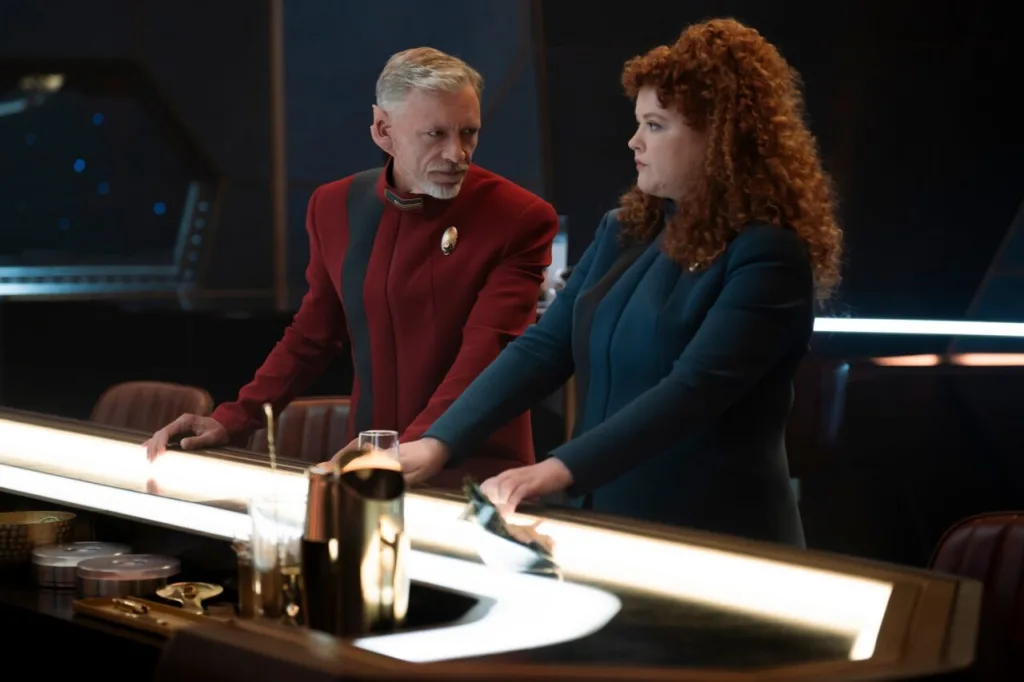
VICTOR: I like that he’s a cup of black coffee amongst the unicorn Frappuccinos that make up the Discovery crew.
MARY: That’s what I love about him, haha.
VICTOR: But also, it’s a bad exercise. I get that Burnham wants him to get to know the crew, but that crew has literally lived together for 900 YEARS.There’s no way he can make up for that in an afternoon! (Although Tig Notaro’s engineer seems like a fan.)
MARY: I did like the insights he gave Tilly at the end, though. I had a feeling his grumpy 20-word exercise meant he was reading more than it appeared.
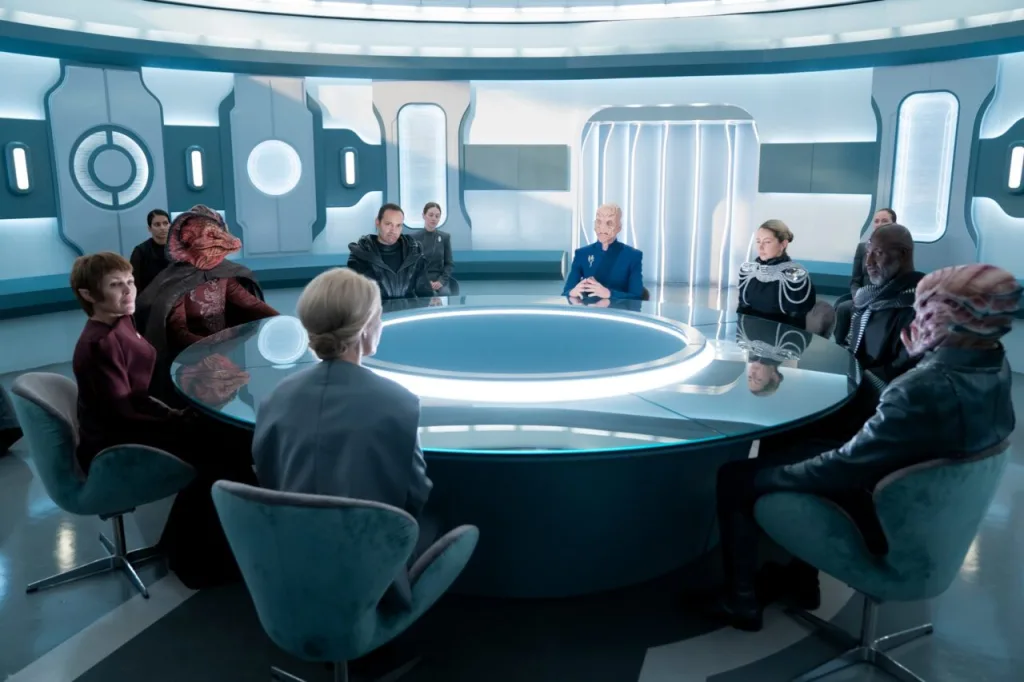
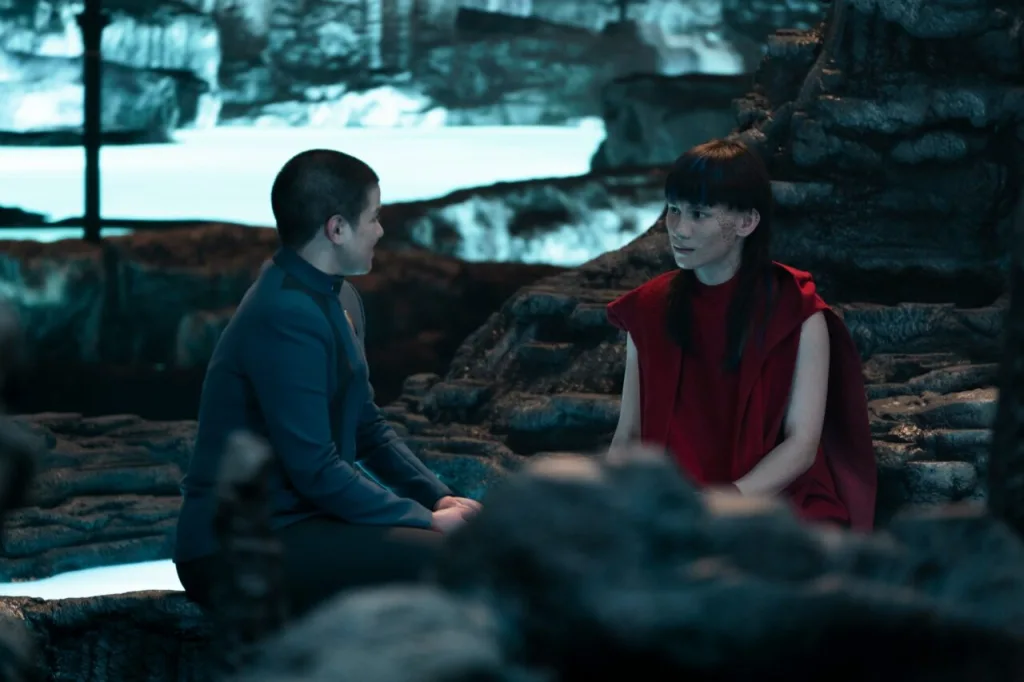
VICTOR: Your favorite! We need to have a Tilly and Rayner spin-off. The Odd Couple of the stars.
VICTOR: I’m sticking with “Book teams up with Moll at some point” prediction.
Welcome, Trekkers, to fifth and final season of Star Trek: Discovery. This is the show that launched Paramount+ and was the first new live-action Trek show in over a decade when it premiered in 2017. It’s been quite a ride, as the show has taken us from the start of the Klingon War and gone over 900 years into the future and introduced us to memorable new characters and brand new aliens and Anson Mount’s glorious hair.
And now we have come to the beginning of the end.
To recap and review the final season, I have joined up with Mary Fan. In the past, we ranked the Paramount+ Star Treks, and we put Discovery right in the middle. Will the new season surpass expectations? Join us as we discuss the first two episodes of the new season. (Fair warning: we will be discussing specific plot points of “Red Directive” and “Under the Twin Moons,” so if you have yet to watch the first two episodes and want to stay spoiler-free, read no further.)
The season starts off with Captain Michael Burnham being given a top secret Red Directive mission to go and retrieve some precious cargo from a long-lost Romulan science vessel. The cargo turns out to be a diary that contains clues to finding a ancient artifact of unimaginable power. However, two mysterious mercenaries / treasure hunters beat them to the punch, setting off a chase across the galaxy.
VICTOR: Overall I liked the first two episodes quite a lot! I thought they were very exciting, although the “twists” weren’t too hard to guess. While I was watching, I thought “Hmm… this ancient power thing reminds me of that episode of Next Generation where the ancient alien race hid a map in everyone’s DNA…” And wouldn’t you know it, that’s exactly what our season’s Macguffin is all about. Now, I love heist movies and chases and treasure hunts, so I am going to be quite happy to watch the crew of Discovery race around the galaxy to find clues.
I am not entirely on board with our villains, though. Moll looks like she stole Darryl Hannah’s makeup from Blade Runner. And L’ak looks super generic.
What did you think? Did you guess the plot chase?
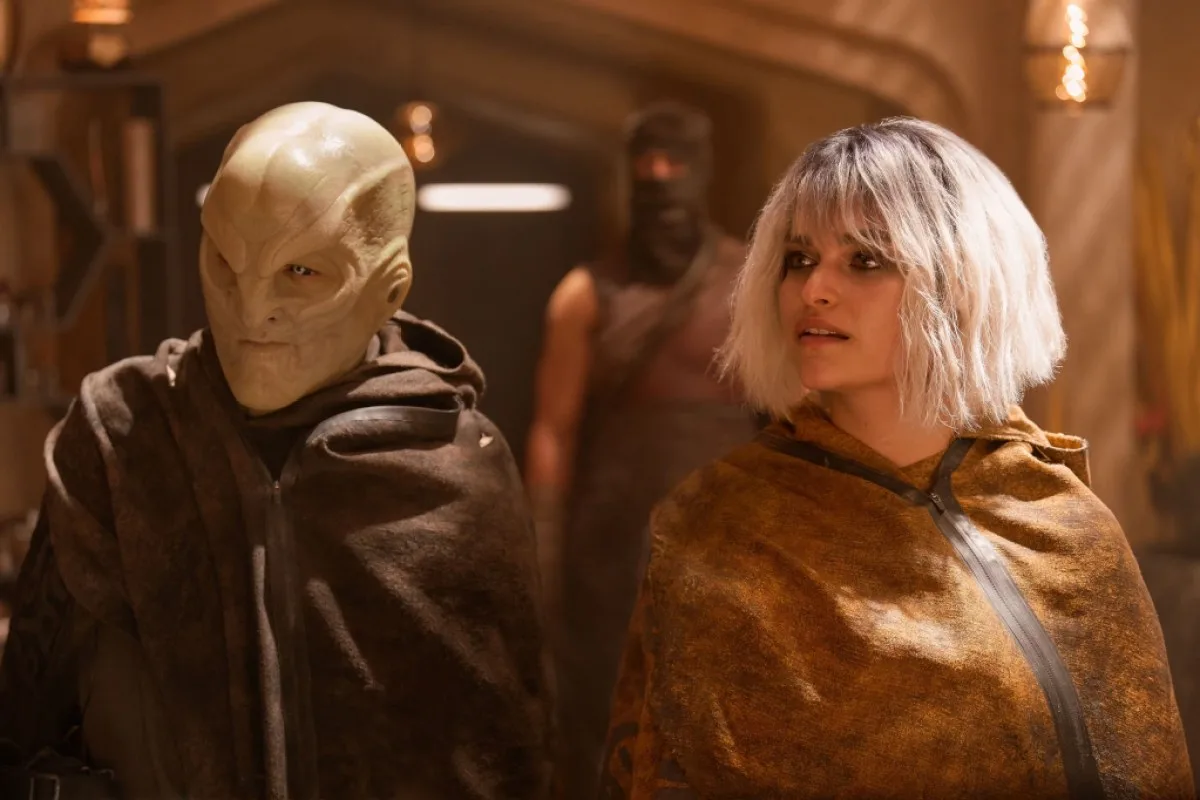
MARY: I’ll admit I’m not as well-versed in Trek lore as some, so I wasn’t sure what the Romulan scientist was hiding, only figured that it would harken back to an old episode that I’d forgotten about. But when they revealed what it was, I did go, “Oh, right! The episode created to explain why aliens are all humans with funny foreheads and ears!”
VICTOR: Yes, the aliens only modded the ear chromosomes.
MARY: The treasure hunt aspect is fun, though I don’t know if I’m too keen on it sustaining an entire season? Indiana Jones meets National Treasure, but make it Star Trek!
VICTOR: To be honest, I’d be into that. Especially with the little Raiders of the Lost Ark nod at the end of Episode 2. They almost said, “They’re digging in the wrong spot!”
MARY: Hah! I’d be more into it if the villains were compelling. My first thought at Moll was, “Oh, they grabbed Shin Hati from Ahsoka!” And yeah L’ak is pretty generic.
VICTOR: Shin Hati? See, here’s where our generational differences come into play.
MARY: The drones coming out of the statue eyes was pretty cool though!
VICTOR: Agreed on the drone eyes! You know, STD has always had solid action scenes. The Klingon War in Season 1, the final battle against the evil AI in Season 2. It’s just that the last 2 seasons had SO MUCH weepily dealing with trauma.
MARY: We’re calling it STD? May I propose Disco instead?
VICTOR: Yeah, I just read that out loud…
MARY: Anyway, agree with your point about action — the visuals are always really good! And I really liked the introduction of Captain Raynor. I like that he chafes against Michael, who’s been put on a bit of a pedestal these past two seasons.
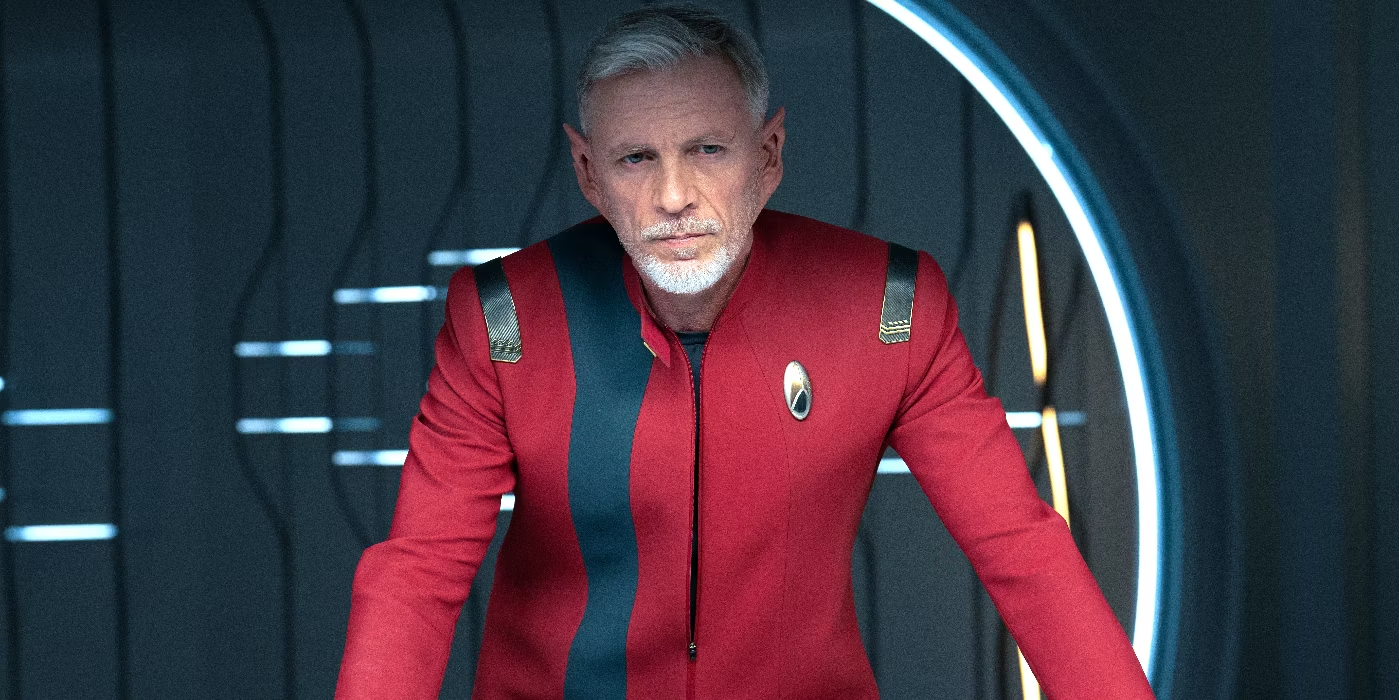
VICTOR: Yes! Liked him as well. Although I could 1000% see that he was going to wind up as Michael’s first officer. Action Saru could not have lampshaded it any harder. “Pick someone who will stand their ground.”
MARY: Agreed. I had to google what species Raynor was, though.
VICTOR: Canadian, I believe.
MARY: I did worry for a sec that they might make Book the first officer, since he’s another one they put on a pedestal. Oh, you just violated a million Federation rules and really should be jailed forever, but you’re Michael’s main squeeze and a major character, so we’re letting you out and making you very important!
VICTOR: Yeah…. I’d hope there are regulations about making your lover your subordinate. I mean, I have to watch a video about that at work every year!
MARY: Yeah it bothered me in Star Trek: Picard that they made Raffi first officer to Captain Seven. I know they weren’t dating by then but still, they’re exes. Meanwhile, us Voyager fans never got the Janeway/Chakotay romance we so wanted because they knew it’d be inappropriate.
VICTOR: What did you think about the other predictable twist, that Moll is Book’s sister, of a sort?
MARY: I rolled my eyes at the Moll reveal. It feels like Moll and L’ak were written specifically to give Book a reason to be on Disco. I hope they go somewhere with this because so far, it’s very underwhelming. They don’t even have any motivation for going after the ancient Romulan thing!
VICTOR: Yeah, it’s very nebulous. “It’s a god machine!” Well what do you need that for?
MARY: Right?? It’d be one thing if they were religious fanatics or something, but right now they’re very generic mercenaries.
VICTOR: Are you two going to create a new planet or something? Don’t they have genesis devices in the future?
Oh… you know what? I bet they want to have babies, but their DNA won’t combine. So they’ll use the ancient alien DNA splicer.
I just thought of that, and I hate it.
MARY: Oh noooo… That had better not be it. I will be so mad. Let’s never have the female character’s motivation be “she wants a baby so badly she’s doing villainous things” (cough Yennifer cough).
VICTOR: Madder than when an angry Kelpian destroyed Starfleet because he missed his mom?
MARY: I was about to say — there are few twists as terrible as Moll wanting an alien baby would be, and “Kelpian tantrum nearly destroying the galaxy” is one of them.
VICTOR: That’s kind of my issue with Disco. I like the characters. I like their interactions. But too often, the season-long plots just fall flat. Like The Burn. Or the Dark Matter Anomaly.
MARY: Exactly. I want to like it much more than I actually do…
VICTOR: It would be a lot better if they had more one-off episodes.
MARY: I think that’s why I’m guarded about this season. We’ve been Burned before (please clap).
VICTOR: 100%. I like these episodes, but it’s hard to get behind them if you’re worried about them sticking the landing. I keep seeing that poor ski jumper from the opening of Wide World of Sports.
On a happier note, What did you think about Saru and his Vulcan fiancée?
MARY: I thought that was cute. I like Saru, and it’s nice to see him find Ms. Right. Sometimes, you just want to see characters you like happy!
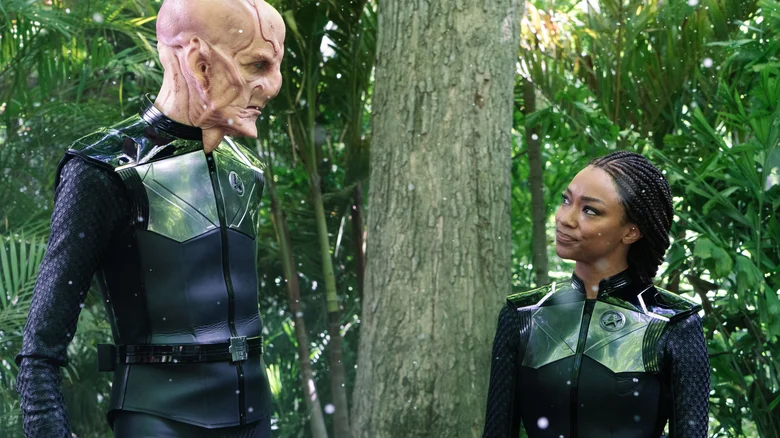
VICTOR: It is! It’s nice to see that it only took Vulcans a thousand years to be less racist. Can you imagine if Sarek had brought a lady Kelpian home to Vulcan?
MARY: I will say, for all my kvetching about Disco’s season arcs, I really like that they ended up in the far future. It gives them much more freedom to expand the universe (and tech!).
VICTOR: Yes! I do like when they actually do some Trekking.
MARY: All right, want to wrap it up with some predictions?
I think Moll is going to get a redemption arc. She’s too pretty to kill off or jail. L’ak might have to be sacrificed for that to happen. He’s an ugly alien, so it’s okay. (That was sarcasm.)
VICTOR: I predict that at some point Book will betray Michael and join up with his sister. And he will be forgiven two episodes later.
MARY: Sounds about right. I have a feeling Raynor isn’t going to survive this season, which I’m pre-bummed about.
VICTOR: Oh, I bet he’ll sacrifice himself because his time had passed. Heroically, of course, while yelling “FOR STARFLEET!”
MARY: Argh. Like I said, pre-bummed. Well if he has to go, it’d better be epic!
Join us next week when we recap Episode Three. Till then!
Rating: 4/5 stars
In the first volume of One Operation Joker brought to us by a collaboration between DC and the Kodansha publishing company, I was thrust into an Earth where Batman’s greatest enemy, the virulently vivacious Joker becomes a beleaguered guardian to Gotham’s favorite les enfant terrible, a bouncy, bubbly boy named Bruce after both fall into a vat of Ace chemicals. Forget about “one bad day”, shit’s more bananas than Gorilla Grod’s breakfast.
As a Batman fan, I can say with assurance that I’ve not read all Batman stories under the moonlight concerning him. Most have Bruce with the same backstory, so the outliers of his origins truly grab me both the collar (as only Batman could). This is especially true when it’s one about being raised by someone who rebukes the very notion of structure.
Thankfully, I was happy to report that the cleverness of author Satoshi Miyagawa coupled with the striking art of Keisuke Gotou made what could have been a weird, one-off purchase something that I wanted to invest more time in, so here we are at Volume 2. Is the story still firing all on pistons or was Volume 1 just a toy car that was new, shiny, and fun for the brief life of a child’s interest?
It’s been a year of Jokerless reign in Gotham City. Hell, even its denizens are more pleasant and less fearful, but this progression of a new Eden in one of the most crime-addled cities in all of comic book history only begins to add to the acid, not in Joker’s heart, but in the pit of his stomach. How the dude does not end up with an ulcer by the end of Chapter 14 is beyond me.
He nearly itches at the chance to murder Harley when she nearly blows a Parent Conference. His appetite for destruction and to get back into the old swing of things is only usurped by his “helicoptering” over Master Wayne. I know only one person can call Bruce that, but Joker is truly a slave to him at this point. From Mister J packing Bruce’s bag for the nursery as if he were going to war to even leaving the edifice with the empty stroller, the Joker’s madness is only tempered by his shockingly nurturing acts.
The first volume of this English manga-style book struck me as “curious” in its inception and “inventive” in its execution through dueling philosophy in the daily rat race of life. Flourishes of this are very much present in this book, but I’ll add “endearing” into the mix. For all of the Joker’s theatrics, which includes a “return party” to Gotham, complete with a giant cake full of explosives with Gordo and others tied on, there’s always a foil in Bruce, especially when he runs a fever, ultimately blowing out the candles on Joker’s death cake.
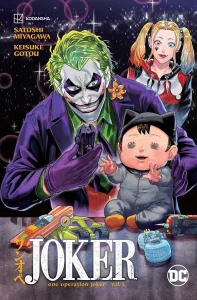
Sleeplessness, I am positive is a symptom of raising a child as well and Joker is certainly feeling it. That and impatience. He’s receiving considerable pushback, but it’s more of what Bruce must grow up to be that keeps the muddled, sleep-deprived, co-dependent mind of Gotham’s erstwhile threat going like the Energizer Rabbit. He wants this tyke to be a grown terror, not realizing that a toddler that can now stand is like working with live explosives, more lethal and exciting than chaingun of Batmen. To me, giving someone with no set agenda an agenda and forcing them to commit is just comedic gold.
I find it completely adorable that the Joker does harbor the irrational fear of the chemical wearing off that speaks to a truer, more based one. Outside of outright admitting he cares for the kid without motive, Joker’s happy to complain about the kid being desirous. Instead of letting the art of a child melt his heart, the Joker wants it as a yardstick for the Bat’s progress. He’s extricating the sentiment by deploying logic, but caring is ostensibly in every single thing the Joker has done for Bruce since the incident.
Don’t get me wrong. The Joker has been and will always be a coiled animal, but Bruce still seems to be winning for now. This is especially evident when the Joker takes him to the toy store, which is brilliant in its observance. At his most reductive, Batman is just the personification of arrested development. He’s always been that hurt, fragile little boy with a penchant for gadgetry, so not even a natural sleeping agent in Joker’s Flower can overpower this explosive tantrum in the toy aisle. Batman: 1, Joker: 0.

We’re also introduced to Alfred Pennyworth, who still adorably after a year of Master Bruce’s absence, still brings him breakfast. Thankfully, I don’t have to suffer much with his suffering of not knowing where Bruce is after he makes a stop off at Wayne Nursery School because he is just at all-time with nothing better to do. Sure, he runs into the Joker, not knowing it’s him, but it’s all good, right?
As a cherry on top of this metaphorical exploding cake, the jealousy in Joker is beginning to cloud the crime side of his brain when Alfred endears himself to Gotham’s most feared protector. A mensch to the letter, he does something that can be construed as either being two steps ahead or just stepping on toes which is where the end of this volume deftly swoops in.
There’s no time for the Joker to even consider “intruders” such as Alfred when crime is the only thing that will put food in Bruce’s belly. The beauty of a good story is good conflict and I love that author Satoshi Miyagawa never lets up on the Joker in the final pages of this volume by giving him a genuine choice. Batman: 2, Joker: -1, and never have I wanted to root for Poppa J more.
The menacing nature of Joker never strays or lets up in this continuation. I feel it’s about to get even more dangerous because when school lunches aren’t free, feeding your kid is more important than feeding yourself. The fact that he has his crew, Harls, the nursery, and even Alfred on his side (though he doesn’t know it yet) I feel will show that it will indeed “take a village” to raise the Dark Knight, not just the one man operation, which is the point. The city raised Bruce, which blows this whole series wide open for possibilities for Bruce to be raised even better than before… even if it’s with a couple of sticks of dynamite.
5/5 Stars
How far would you go for success? What are you willing to sacrifice? Who are you willing to hurt?
That’s the question posed by Late Night With the Devil, a new horror film from Australian brothers Cameron and Colin Cairnes. It is framed as the long-lost master tape of the legendary live Halloween 1977 broadcast of Night Owls, a late-night talk show hosted by Jack Delroy.
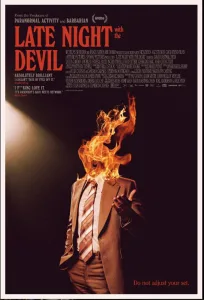
Jack’s (David Dastmalchian) show is the hipper competitor to the perennial ratings giant, The Tonight Show with Johnny Carson. After bursting onto the scene six years ago, he still hasn’t been able to topple Carson. Add into that some personal tragedy, like the death of his beloved wife due to a mysterious cancer, and his show is on the verge of cancellation. Desperate for ratings, he has a live Halloween special which will feature a medium, a supernatural skeptic, and the sole survivor of a satanic cult who now claims to be possessed by a demon, along with her psychologist handler. Jack wants the ratings so bad, that he’s willing to have the young girl channel the devil himself live on the air.
The movie is a potent blend of a lot of 70’s pop culture and historical artifacts. They draw liberally from the satanic panics of the age and all the urban legends about what the titans of industry do at the Bohemian Grove, as well as all of the aesthetics of the time. The film looks great, which is an odd thing to say about a movie that has a brown-and-orange design scheme. It’s a faithful recreation of a TV studio from the late 70’s. It’s also shot in a glorious 4:3 ratio to keep it in the framing of the time. (Yes, children, televisions used to be big, boxy, and square.) It looks and feels like watching clips from old episodes of Johnny Carson or Merv Griffin right down to the cast lineups, and the movie lets you spend a bit of time absorbing it all.

While it might take a while for the horror to ramp up, I didn’t really mind. I am a big fan of late-night talk shows, and it was a treat to watch this spin on them. The film is packed with nods to the mainstays of late night TV. There’s a popular psychic named Christou (Fayassal Bazzi) who claims to be able to talk to the dead and is a stand in for the Uri Gellars of the time. There is a magician turned skeptic named Carmichael Haig (Ian Bliss), who is clearly meant to be James Randi, debunker of all things psychic. Also, a treat is Rhys Auteri as Gus McConnell, Jack’s hapless sidekick and channeling more from Jeffery Tambour on the Larry Sanders Show than Ed McMahon.
But the true revelation here is Dastmalchian. Readers will likely recognize him as Polka Dot Man from James Gunn’s The Suicide Squad and Scott Lang’s criminal buddy, Kurt, from the Ant-Man movies among many of his many credits. Here, he finally gets a big, meaty leading role and he makes the most of it. If the viewers don’t believe that he is both a charming and affable host and also someone willing to have a little girl get possessed by a devil so he can finally beat Johnny effin’ Carson in the Nielsen ratings, this movie falls apart. But he is fantastic. He carries it off to perfection, mixing in corny jokes with empathy and sensationalism, along with backstage anxieties. He’s so good at it that if you told me Dastmalchian would be hosting a new late-night show for real, I’d watch.

The tension is well handled. It ramps up slowly until it very much does not. And while you might be able to guess at certain parts of the ending, it didn’t make the reveal any less upsetting to me. The movie both embraces the tropes of possession horrors and subverts them as well.
Late Night With the Devil is in theatres now, and soon to come to Shudder TV. And it honestly might be even better to see it at home, where it can air on the medium as it was intended. The year in horror is off to a strong start. Stay tuned…
Readers of this site know that I am a massive fan of Godzilla and all things kaiju. The brilliant Godzilla Minus One was my favorite film of last year. I thought the Apple+ series Monarch was fantastic, adding layers of humanity to the recent WB/Legendary films. And I have enjoyed all of those recent movies, starting with Godzilla (2014) and going through Godzilla vs. Kong, to varying degrees. (Coming right after the pandemic, I cannot tell you just how much I whooped and cheered watching Kong and Godzilla whale on each other.)
So I was of course excited to see the latest entry, now showing Kong and Godzilla teaming up to fight…something. The trailer wasn’t exactly clear what was going on, but giant monsters! That’s going to be fun, right?
Right?
Alas, Godzilla X Kong: A New Empire is – by far – the weakest entry in the series. It’s a lot of literal chest-thumping covering for how empty this film is.
It picks up after the end of the last movie. Kong has returned to Hollow Earth, the untamed wilderness that is home to giant monsters and lies in the center of the planet. He is looking for more giant apes but has thus far only succeeded in getting chased by giant dire wolf things. Kong looks older and greyer here than in the last movie, and that’s a pretty apt metaphor for this whole enterprise.
Meanwhile, Godzilla has become humanity’s protector from other titans that run amok, like a C’thu’lu-looking critter with giant crab legs skittering about Rome. The two alpha monsters apparently worked out a bro-deal, where Godzilla roams the surface world and Kong runs Hollow Earth.
In Hollow Earth (and I am already tired of typing that), a seismic event opens up a lower layer that was previously sealed off. (A Hollower Earth? How many sub-basements are there before we get to the Earth’s core?) This has unleashed a tribe of evil apes, led by The Scar King. The Scar King was so evil and twisted, that he threatened to upset the natural balance and Godzilla had to seal them in. The Scar King is now eager to return to the surface world and conquer, and only Godzilla, Kong, and the Iwa tribe that lives in Hollow Earth, can stop him.
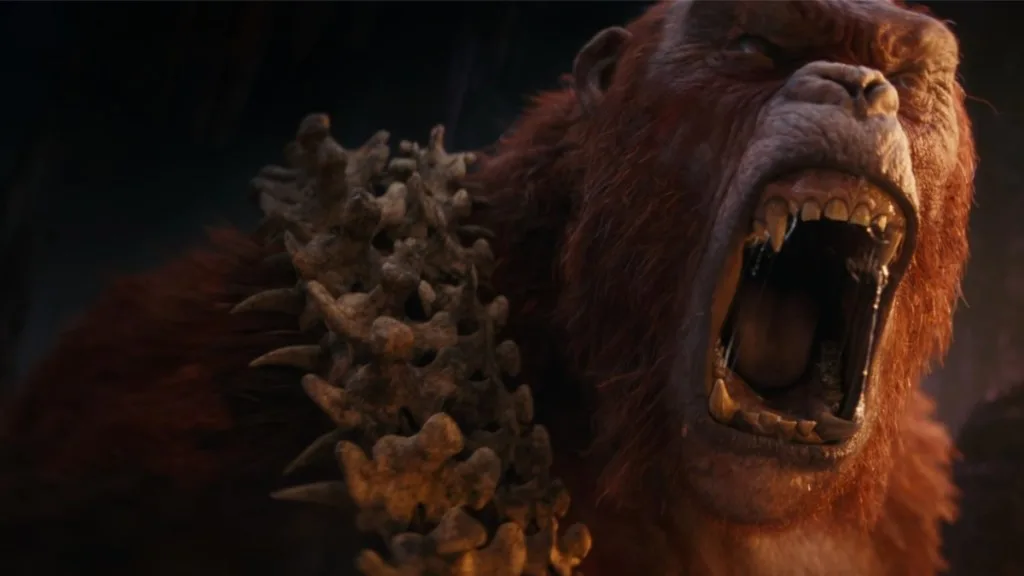
The Iwa? Oh right. Remember Jia (Kaylee Hottle), the little mute moppet from the last movie, who is the only one who can talk to Kong? She thought she was the only surviving Iwa when Dr. Andrews (Rebecca Hall) found her on Skull Island. Jia’s been seeing visions that resemble the strange seismic readings coming from Hollow Earth, so Dr. Andrews goes to consult with her favorite kaiju conspiracy podcaster, Bernie (Brian Tyree Henry). You know. Like your average top-secret quasi-governmental agency does. He quickly determines that it’s some kind of distress call, so the three of them, along with Dan Stevens – playing a wacky kaiju veterinarian named Trapper – head toward Kaiju Town. There the Iwa telepathically fills them in on what’s going on and how they need to summon Godzilla back.

Even by my extremely lax standards for monster movies, this plot is both convoluted and utter nonsense. How long do these giant apes live? Why does Godzilla care about humans? How long ago did he seal them in? And how much was sealed in? (Since there is apparently a whole world with water and blue skies the Evil Apes can roam around in.) Even though we are told repeatedly that Kong or Godzilla invading the other’s turf could lead to all out war, it never does. Also, the Iwa can communicate telepathically, but who taught them English? (If I can read your thoughts, but your thoughts are in Chinese, that really doesn’t help me understand them.) Why is Scar King so hot to get to the surface? And even more importantly, who cares?
And I could forgive all of that if the monster battles were fun to watch. They’re just ok. They just feel rote and perfunctory, with none of the verve of the last movie where Kong throws a revolving restaurant at Godzilla like a frisbee. Scar King does have a pretty neat whip made out of a spinal cord, but he’s no King Ghidorah in a fight. He’s a big monkey, and Godzilla has fought big monkeys before. There’s not any sense of menace.
There are plenty of impressive visuals here – like the crystalline world of the Iwa people in Hollow Earth, Godzilla curling up for a nap in the Colosseum of Rome, and some very cool-looking seas serpents. But because the plot is ridiculous and the CGI is meh, nothing feels at all grounded. After seeing Godzilla Minus One and feeling the sheer enormity of Godzilla and the destruction he wreaks, this just seems small and insignificant. Even though the Kaiju lay waste to several world cities (Rome, Rio, and Cairo among them), there just isn’t the same sense of terror.
And yes, it’s not an entirely fair comparison. Godzilla Minus One was a deeply felt allegory about Japan dealing with post-war trauma, and this is a wannabe CGI blockbuster. But once you’ve shown how awe-inspiring and terrifying Godzilla can be, you can’t just coast by on CGI goop. You have to make a little effort.
The actors gamely try their best with the turgid exposition they’re given. Henry and Stevens have fun with their comic relief parts, but no one is going to put clips from this on their lifetime achievement reel.
All in all, it’s a disappointing outing for any fan of Godzilla, Kong, or giant monsters in general. Hopefully, the next one stays out of Hollow Earth and brings us some new monsters. Oh, and a plot that isn’t actively insulting.
Rating: 2.5 out of 5
Rebooting or reviving a beloved series is always a tricky proposition. Do the show runners try to do something new and risk alienating old fans? Or do they wallow in nostalgia and try recreating the magic of the old show and risk being stagnant and hidebound?
It’s a tightrope, for sure. Several of my all time favorites have gotten reboots in recent years, and the results were not encouraging. Despite a few great episodes, the new X-Files seasons never really gelled for me. The Netflix seasons of Arrested Development and Gilmore Girls were a mixed bag, at best. And the less said about the pallid new seasons of Law & Order the better.
So it was with no small amount of trepidation that I turned on the new X-Men ’97 series on Disney+. Like many Gen-Xers and early Millennials, I have very fond memories of the Saturday morning cartoon that ran on Fox from 1992-97. The cartoon was notable for bringing many of the complex storylines from the comic books onto TV screens. Sentinels, the Dark Phoenix, the Logan-Jean Grey-Scott Summers love triangle, and virulent anti-mutant prejudice all made their way into the show. Would the new series continue this? Or would Disney be content to just play the hits and give fans a nostalgia fix?
Well, I am happy to say that X-Men ’97 is a worthy follow up. And if the first two episodes are any indication, fans can look forward to the same level of storytelling and soap opera theatrics.
The series starts right where the last episode ended almost 27 years ago. Professor Charles Xavier was killed by an anti-mutant assassin, and his death has created a truce between mutants and humans… for the most part. There are still those, like the Klan-like Friends of Humanity, that are dedicated to killing mutants to “protect” humankind. And of course, not all of Magneto’s Brotherhood of Mutants have signed on to this either.
Some things have changed, though. Jean Grey is pregnant, and expecting any day. (Which opens up a door to a world of story possibilities, many involving time travel, if you know about the comics history of Nathan Summers). Logan is still carrying a torch for Jean, and other old favorites like Storm, Beast, Rogue, and Gambit are back. (In a wonderful touch, much of the original cast is back to reprise their roles. Remember when animation used actual voice actors instead of celebrities?) Rogue and Gambit should be especially fun to watch, as the first two episodes hint at a relationship between them and a past involvement between Rogue and Magneto.
Oh yes, Magneto is back. As seen in the trailer, he has found Xavier’s will, and it leaves him in charge of the X-Men and the School for Gifted Children. No doubt, this was Charles’s final attempt to bring Magneto around to his way of thinking.
The nice thing about this show is that — unlike other Disney+ projects I could mention (*cough* Ahsoka *cough*) — it does not assume a lot of prior knowledge. Were you a fan of the old series? Great! But maybe you’ve only seen a few of the movies. Or maybe you read the comics long ago, but stopped when they got too convoluted. (Like I always say, if you haven’t come back from the dead at least twice, can you even call yourself an X-Man?) That’s fine too! The series, with its update to the classic intro, does a good job of explaining who’s who and what powers they have. And the writing is sharp enough to give you context for the relationships between the characters without a massive exposition dump. But there are plenty of inside jokes for die hard fans, too, such as a dig at future X-Man Goldballs, unwittingly made by Jubilee.
The animation is very clever. It is clearly meant to be in the same style as the old cartoon, but with a much higher budget to give it some more flourishes. This includes putting a “video patina” on it to make it look more like the ’90s series. It looks great, especially some of the action scenes. Storm landing in the desert, her lightning turning the sand to glass is fantastic, as is the shot of Gambit riding Wolverine and charging his claws with kinetic energy.
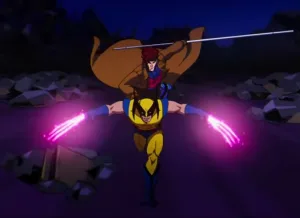
After watching the first two episodes, it’s clear that the creators love the X-Men comics and are intent on staying true to them and to the spirit of the old show. This promises a show full of twists and turns, as the X-Men are probably the superhero squad with the messiest backstories in all of comics. And I’ll be watching, probably with a bowl of Fruity Pebbles to make it feel like old times.
Rating: 4 out of 5
Nickelodeon’s animated show Avatar: The Last Airbender (ATLA) has been widely praised across the years, and the announcement a few years back of its live-action remake on Netflix was met with both excitement and skepticism. Having watched all eight episodes of the new show, Sunil Patel, Victor Catano and I discussed what we thought worked… and what fell flat.
Mary: So having been a fan of the animated show and now watched the live action adaptation, what were your overall impressions?
The most striking thing to me right off the bat was the uneven tone. The show’s content has always been pretty dark, being about war and all, but live action made everything feel more violent, and it seems like they purposely leaned into it? Like showing people burning alive? Which made the fact that the main heroes are young kids feel a bit bizarre.
Victor: I had a similar reaction. The show was originally a Nickelodeon animated program aimed at kids and young teens. While it covered mature themes, there was a limit to what Nickelodeon would allow.
But here, in the opening scene, people are getting graphically burned alive. All through the show, the firebenders are torching people. They show in great detail the massacre of the air nomads. It’s a lot! This seems like it’s definitely pushing the edge of PG-13 and would probably not be shown on its network of origin.
And I agree with you about the age of our heroes. In the cartoon, it seems perfectly acceptable that children would be off to save the world. Maybe because it’s adults doing the voice work. But in live action, they all seem so young! And it’s a little disconcerting to see Fire Nation soldiers trying to murder a child!
Sunil: When I first read they were going to show the genocide on the show, I wasn’t quite sure if that was necessary, but while I agree it’s surprisingly graphic and distressing, I don’t necessarily think that’s a bad thing. I like that this version of the show can engage with the horror of war more directly, and I found the choice to begin with the wiping out of the Air Nomads interesting as it puts us in Aang’s perspective and really makes that loss hit home, as well as his guilt for not being able to stop it.
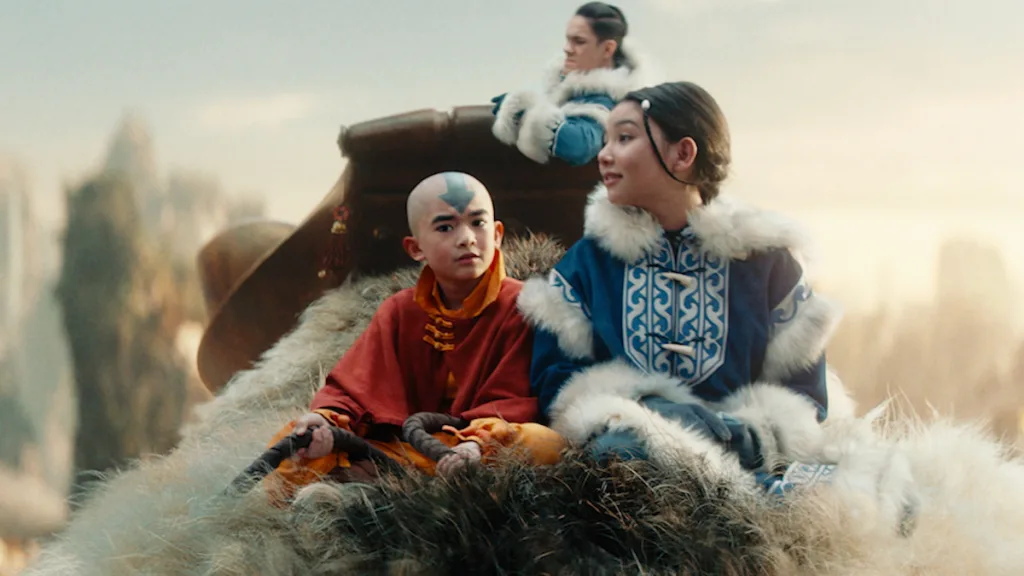
Mary: That’s true. And ATLA certainly isn’t the first live-action thing ostensibly aimed at kids to depict violence. The Hunger Games and Star Wars Episode III: Revenge of the Sith come to mind. The first because it’s got a super violent premise yet is about and aimed at teens / tweens, and the second because it also depicts a genocide (including the deaths of children). But ATLA somehow felt more graphic than both of those, and I think it’s because of some of the visual choices they made. The Hunger Games had much of its violence implied, or at least depicted in a less graphic way. And Revenge of the Sith showed the massacre in montage, which made it feel less visceral yet still tragic.
Victor: What changes from the animated series worked for you? And what didn’t?
Personally I’m glad to see them giving Azula more backstory. In the original show, she comes off as the crazy daughter. Here, she’s shown scheming and plotting and subtly manipulating Ozai.
But because there are only 8 episodes, a lot of the cool smaller characters get rushed. Bounty Hunter June is so cool with her mole thing! And she has a total of 5 minutes of screen time.
Sunil: I agree about Azula! While I wish she’d been more psychotic, I can understand wanting a more nuanced portrayal for this live-action version. But I loved her role as a secret active antagonist for Zuko.
I really enjoyed so much of the clever remixing, like placing Jet at Omashu or doing the Cave of Two Lovers with Sokka and Katara, which I know may seem kind of weird, but I think the show nailed their sibling relationship.
There were also a couple small changes that were so brilliant I couldn’t believe they weren’t part of the original show. Aang stealing Zuko’s notebook to learn about what happened while he was gone adds a lot to his character and deepens his connection to Zuko. And making the 41st regiment that Ozai was planning to sacrifice Zuko’s crew was a stroke of genius.
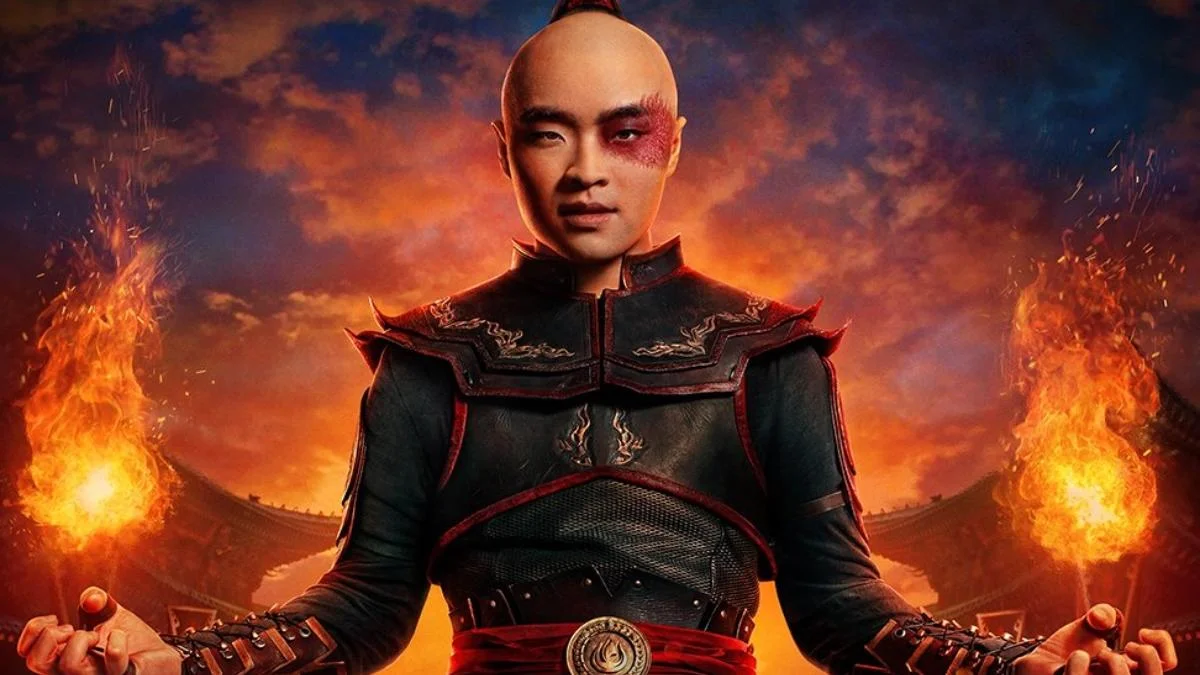
Victor: I was not as much a fan of that. They mashed about four or five different subplots into the episode, and I don’t think any of them got enough time to breathe.
But I agree on those points about Zuko. The notebook and the 41st make him a lot more sympathetic, especially compared to the animated version screaming about his HONOR every other sentence
Sunil: Not gonna lie, I really missed him not saying HONOR every sentence.
Mary: Totally agree about Zuko and the 41st! And I don’t think he says “honor” once in the live-action show which, thank goodness. Using “honor” as a motivation for Asian characters has become so cliche, it’s borderline racist…
I do feel like they softened him a little too much, though. He was definitely nastier in the cartoon, which made his eventual redemption mean more, and the little moments of goodness that peek through in the first season a bit more surprising.
The live-action show seems so determined to show him as sympathetic from the get-go that he never really feels that villainous.
Sunil: I agree with that. I think it’s a similar thing with Azula, where they want to show the full humanity early. Which is a valid choice and could have its own benefits down the line.
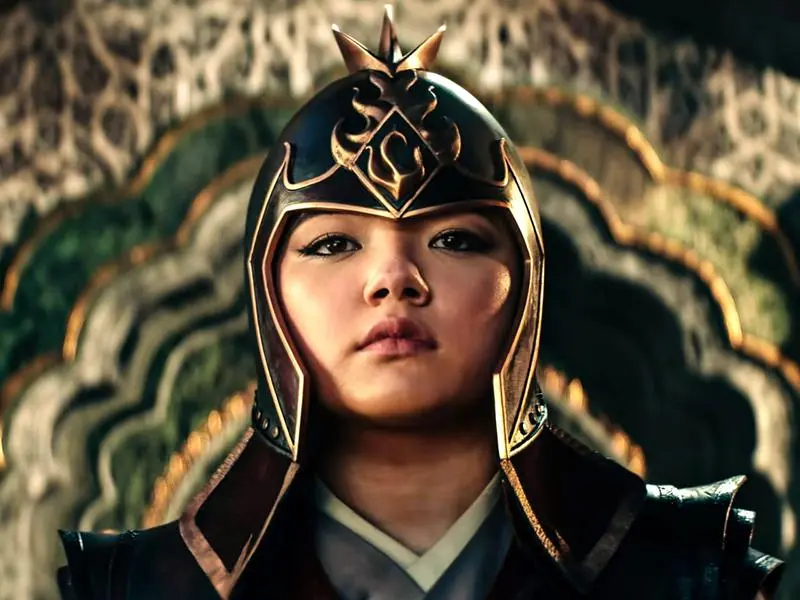
Mary: I do like what they’re doing with Azula. With her, she seems just as nasty, if not nastier, than in the cartoon. More conniving, actually.
Sunil: But in the animated series, it’s UNFATHOMABLE that you would ever like Zuko, let alone think that he could become genuinely good. Here, it seems like a possibility from the start.
Mary: Exactly! Which I feel like makes him lose a bit of his edge.
Another change I like is that they seem to have done away with Aang’s crush on Katara.
Sunil: That is very good if true because he seems like very much like a KID compared to her here, it would be very uncomfortable if they were to do the romance.
Mary: It’s more of an organic friendship that’s blooming between them, rather than him going all heart-eyes from the first episode. I never liked Aang’s romantic relationship with Katara in the original series because it brought out the worst in his character. It made him possessive and controlling. Meanwhile, Katara never showed any romantic interest in him until the very end, which made it feel like she was reduced to Aang’s “reward” for fulfilling his destiny (the only visible romantic interest she shows in the animated show is toward Jet).
And yes, doing a romantic relationship between characters who are supposed to be 12 and 14 would be… problematic… with live actors.
Victor: Yeah…. even in the cartoon, Katara feels much more mature than Aang. In live action, uhhh… no.
Which brings up the characters and the actors playing them I think we can charitably call the acting in the show… uneven.
For me, Ian Ousley playing Sokka was a real standout.
Mary: “Uneven” seems to be the reigning word to describe this show.
A lot of the acting felt almost amateur, like I was watching a fan film made by someone who grabbed volunteer actors from the neighborhood middle and high schools. But it wasn’t just the kids… a lot the adults had pretty stilted acting too. Which is why I think it was wooden dialogue / writing that was the problem. So much exposition was stuffed into the lines that anyone would have had trouble delivering them.
Ian Ousley as Sokka was definitely the stand-out, and I wonder if it’s partly because his character was allowed to be more fun than the others. Both Aang and Katara lost a lot of what made their characters fun in the cartoon thanks to the live-action show’s writing, and I’m not sure there’s anything the actors could have done about that.
Victor: Yeah, the dialogue was pretty on the nose, and when you binge the show you really hear how repetitive it gets
Aang, every episode: “I have to save the world but I don’t know what I’m doing!” Every episode: “The avatar can’t have friends!”
And poor Iroh has to some cheesy Modern Family-style end narration to recap the moral of the episode.
Mary: Iroh! I wanted to love him, especially since I loved Paul Sun-Hyung Lee in Kim’s Convenience. His casting was the one I thought was the most apt, so the fact that his character fell kind of flat can only be the writing. Just as they dulled Zuko’s villain-y edges, I feel like they dulled Iroh’s silly ones. He just seemed much sterner overall.
Sunil: I agree on both Ian Ousley and Paul Sun-Hyung Lee! Ousley really embodied Sokka while still being in this more grounded mode—though I hope he got a face massage after clenching his jaw through the whole series—and I loved that the show explored his struggle to find out who he is and truly wants to be outside of his father’s expectations of him to be a warrior. And Lee was stern as Iroh instead of warm and playful, which I attribute to his acting choices more than the writing.
Daniel Dae Kim’s perfect as Ozai, and I really enjoyed Ken Leung’s take on Zhao, who doesn’t have the sinister megalomania of Jason Isaacs but leans more into Zhao’s arrogance and petulance. And there are some really good performances in smaller roles, like Maria Zhang as Suki and Amber Midthunder as Yue and so many more!
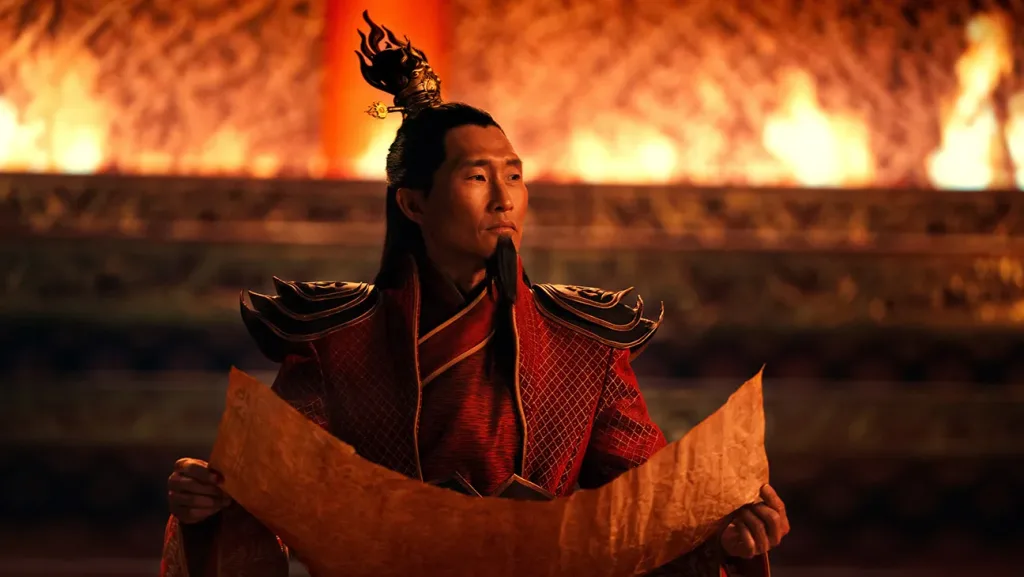
Mary: I really liked Kim’s Ozai! Perfectly sinister. And I thought it was interesting how they made Zhao a scheming striver. It made him less scary… until it made him more. Like, you could see how the desperation to matter made him evil, and that was pretty cool.
Sunil: Right? He did seem kind of comical at times, but then the comedy becomes… very dark and threatening in the finale when he’s like, “I’m not going to kill the Ocean Spirit, that would be devastating to Waterbenders around the world, I’m not a monster! … I’m just going to kill the Moon Spirit.”
I feel like there are more than enough strong performances to make up for the weaker ones in the cast.
Victor: Yeah that was just crazy. “I AM ZHAO THE MOON SLAYER!!!”
Sunil: I was disappointed they changed his death scene, though. It would have fit with this version to be so prideful and arrogant as to refuse help from Zuko and just go out like a boss/chump.
Victor: It seems like we’re being a little hard on the show, but I enjoyed it! I kept watching! I think they find their footing about halfway through, once they go to the creepy spirit world.
Sunil: Oh, that’s good to hear because I was feeling really defensive over here! I enjoyed it, felt it got better and better.
Victor: The action is really good, especially the prison break in episode 6 where they use the ladders as stilts to escape.
I think a problem is that a lot of people hold the animated show in extremely high esteem—and rightly so! So any attempt to adapt it is going to meet with grumbling from some fans
Mary: True! But I do think a lot of the grumbling is merited. Looking at not just this show but also the other live-action adaptations of animated shows and films out there, I think there is just something ineffably magical about animation that gets lost in live action unless special care is taken. Not saying good adaptations don’t exist (I, for one, really liked the live-action Aladdin, and live-action Cinderella was absolutely gorgeous), just that it’s really hard, and much gets flattened out.
In trying to be “realistic”, the spark that made the animation come to life gets lost.
Victor: Yes. Let us not speak of the “live-action” Lion King again.
Sunil: I also liked the live-action Aladdin! And the live-action Cowboy Bebop! And this! Maybe I’ve just gotten lucky, or maybe I just like things.
Mary: So what did we think of the visuals? I really liked a lot of it (Omashu! Earth bending! Appa!). Others I wasn’t a fan of. Turns out airbending isn’t as cool when you can’t see anything…
Victor: Are you ready for the word of the day? Uneven!
Sunil: I was surprised at how much I liked the visuals overall given how dicey it all looked in the trailer. But I agree that the airbending was lacking a certain oomph without seeing it. In general though I thought the bending looked very cool!
![]()
Victor: Some of it looked very cool. Some of it looked very green-screened. Waterbending was kind of meh, unless it was being made into ice.
Mary: Yeah, and firebending was just… graphic.
Sunil: What’s wrong with graphic!
Mary: Some of it looked really cool, but it was a lot grosser in live action…
Sunil: It’s fire! Yeah! Huh-huh, huh-huh.
Fire rules!
Mary: I feel like overall it’s a very confused series. Like, who is gonna show their kid something where people get burned alive while screaming? But what adult is gonna watch a show starring children? And not, like, prestige-acting kids, but Disney Channel-type kids?
Victor: Yeah, like we started with, the tone is all over the place
But I still found it enjoyable! So, I guess 50-year-old men is the target demographic? Shrug emoji?
Mary: One thing I wanted to touch on was representation. The cartoon is of course beloved for its unique world building, and it was an Asian fantasy in a time when pretty much all fantasies were European. But behind the scenes, we had some white actors voicing non-white characters, and I don’t recall if there were any Asian writers or directors? Some of the world-building is a little stereotypical, possibly for the latter reason—the imperialist Fire Nation that’s clearly inspired by Japan, Ba Sing Se as a stand-in for China being kind of flatly authoritarian, and then the idealized peace-loving Water and Air Nations inspired by Inuit and Tibetan cultures, respectively. Of course, it’s a cartoon for kids, but there were things they could have done better. I did notice that they’ve made an effort to show another side of the Fire Nation in the live-action show, with the rebel group, and I wonder if that’s because there are more Asians behind the scenes this time.
And of course, it’s great to see so many Asian and Indigenous actors in front of the camera.
Sunil: I agree that this show is a great opportunity to show off the talents of many Asian and Indigenous actors, from the well established like Daniel Dae Kim (Ozai) to rising stars like Amber Midthunder (Yue). And then there are actors who’ve been in some notable projects, like Momona Tamada (Ty Lee), who was Claudia in the wonderful but canceled Netflix The Baby-Sitters Club, and Kiawentiio (Katara), who starred in the critically acclaimed Beans, which I heard some buzz about but now I’m more interested in checking out. I’m kind of floored scrolling down the cast list of this show and seeing all these names I don’t recognize, all these names that I could be seeing in cast lists for other projects.
I also love that the four directors are all Asian, including two Asian women! One of them is aptly named Jet! And the other is Roseanne Liang, whose work on Shadow in the Cloud I really liked, so I appreciated the horror vibe she brought to the Spirit World episodes.
Victor: So happy to see Amber Midthunder again. I lover her in Prey.
Sunil: I can see why people would think there’s no reason for this show to exist, and I certainly can’t defend it as a work of art even close to the level of the original animated series. But I think despite its shortcomings, it has much to offer in transporting me back to this world in a different medium and showing me these characters and stories in a new way. It saddens me that hyperbolic hate gets more clicks than more reasoned responses that can acknowledge both strengths and weaknesses. In the end, I had a good time with these eight episodes. It’s Avatar, it did Avatar things, yip yip!
Mary: Ok real quick: Three things you liked, three things you disliked, and three things you’re hoping to see in future seasons. Go!
Victor:
Liked:
Disliked:
Want to see:
Sunil:
Liked:
Disliked:
Hoping to see:
Mary:
Liked:
Dislikes:
Hoping to see:
I’ll confess, I hadn’t been paying enough attention to realize that Season 2 of Quantum Leap would only be 13 episodes long, but started having suspicions after Episode 211. With the big Gideon Rydge reveal, things were starting to feel finale-ish. So when Episodes 212 and 213 dropped and I realized they were a two-parter to wrap up the season, I was like “Oh, no wonder!”
By now y’all know that I absolutely loathe the Hannah storyline for various reasons, one of which being that Ben ditching Addison and falling in love with her felt way too rushed. Now, I realize that this was inevitable due to the the short season and the writers’ grand plan. To their credit, they actually had one. Did it work out in the end? I have mixed feelings.
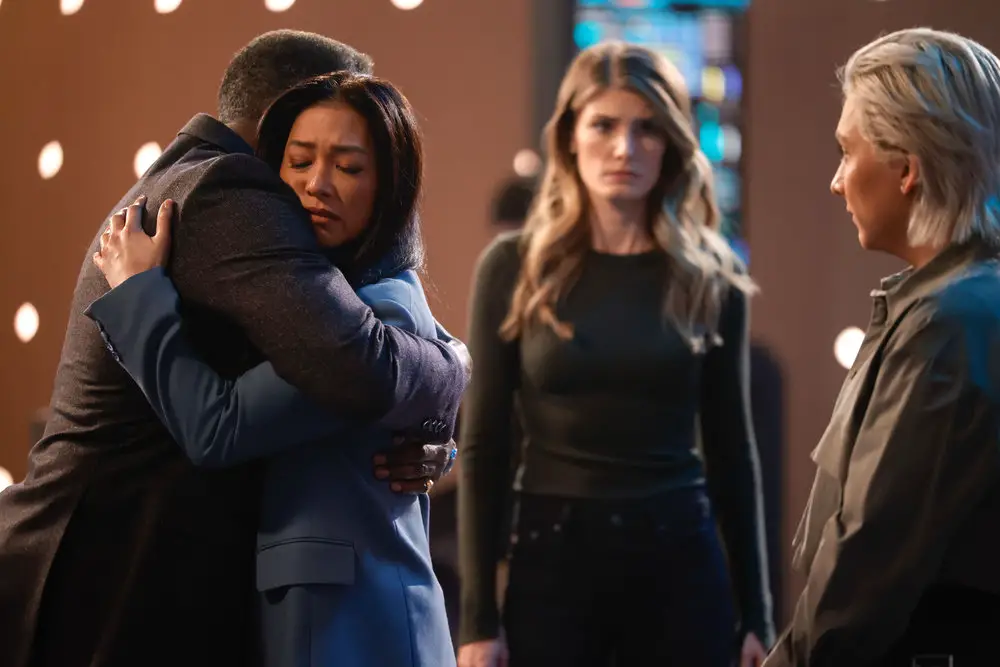
Something about Season 2 of Quantum Leap felt oddly familiar, and I finally realized what it was: It reminds me of Heroes Season 2 back in the day. A truncated second season, impacted by a writers strike, given the unenviable task of following up on an excellent first season. And one where the writers seemed weirdly fixated on a romance that no one asked for.
After mostly giving us a break from Hannah in Episode 211, Episode 212, “As the World Burns” thrusts her back onto center stage. Ostensibly, Ben’s leap this time, into a veteran firefighter in Baltimore, is about saving a bunch of construction workers from a burning high rise. But in reality it is all about that Hannah. AGAIN. Because naturally, she and her son live in said high rise. Her husband has passed away despite Ben’s effort to save him via future message, leaving 11-year-old Jeffrey very angry and rather insufferable. As in, flames are literally engulfing the building around him, and he gets extremely upset when Ben and Hannah won’t let him go back to the apartment for his dad’s things. What a brat.
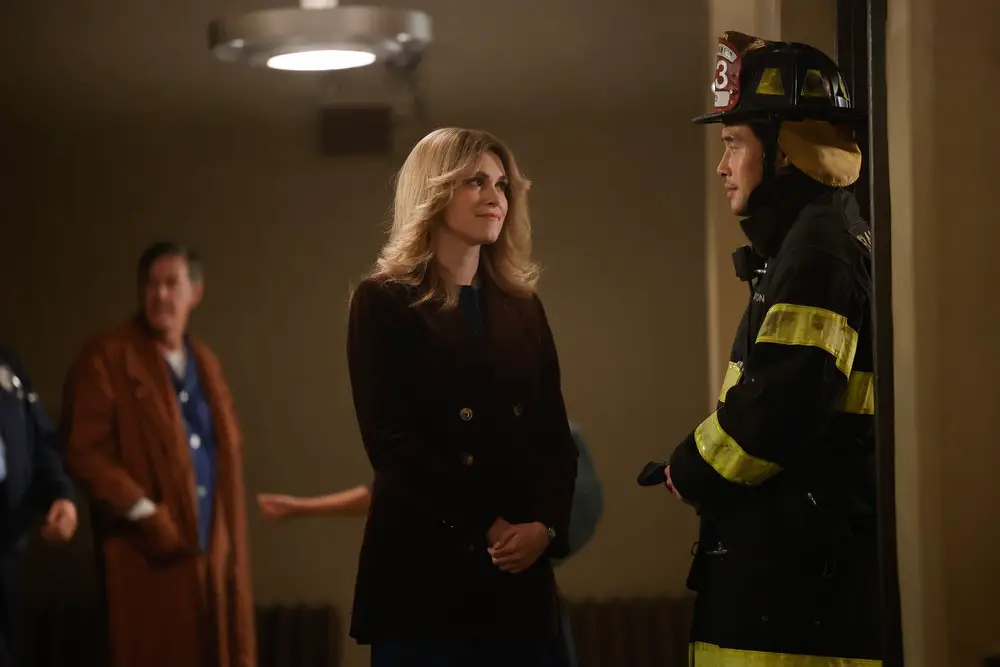
Back home at HQ, Ian is feverishly trying to solve the mystery equation that could bring Ben back home, while Gideon is throwing his weight around. How Gideon has so much power is glossed over. They finally clarify that he’s a Silicon Valley billionaire who has pretty much the whole government in his pocket. Okay, that totally explains why he’s later able to command a bunch of armed soldiers. The writers seem determined to wave off the logistics behind that with a huge “whatever”, so I guess I won’t dwell on it either.
With Gideon boxing them out of Quantum Leap HQ, the team turns to an old ally: Janis Calavicci. After all, she has her own imaging chamber, plus her dad’s retro Quantum Leap tech. The nostalgia plug was nice, though also a reminder of everything the new show retcons without explanation (WHATEVER HAPPENED TO THE WAITING ROOM???).
At this point, most savvy viewers have probably figured out that Hannah is the reason behind the magic equation. How is it possible for her to have figured that out, or even think about figuring it out, when Quantum Leap doesn’t exist yet for her? Don’t worry about it.
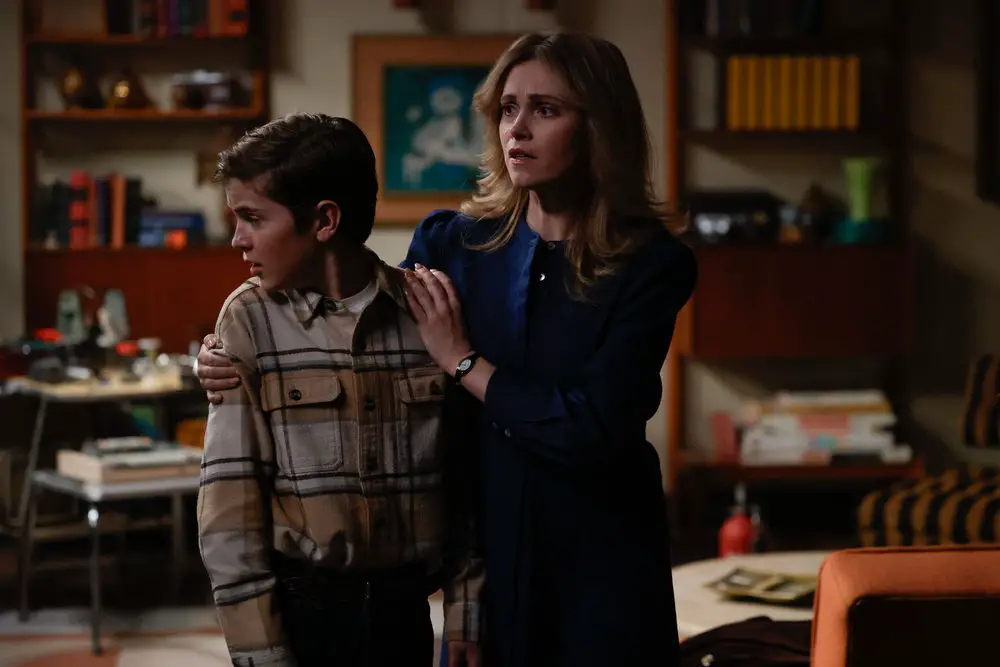
By now, Gideon has totally taken over Quantum Leap HQ and steps into the imaging chamber to tell Ben about the 50-year-old grudge powering his takeover of the program. Ben’s letter to Hannah, warning her of her husband’s heart condition and signed with “all my love,” was discovered by said husband and caused him to storm out. He drove into bad weather and died in a crash. So Jeffrey, having overheard Hannah try to explain the time traveler thing and witnessed some of Hannah’s encounters with Ben, blames Ben for his dad’s death. He built his fortune out of stock tips that Ben offhandedly rattled off hoping to help Hannah materially and has wormed his way into Quantum Leap so he can change history for his own benefit. The magic equation is actually a swap code — it won’t bring Ben home, but it’ll allow him to trade places with someone. And Gideon intends to be that someone. DUN DUN DUN.
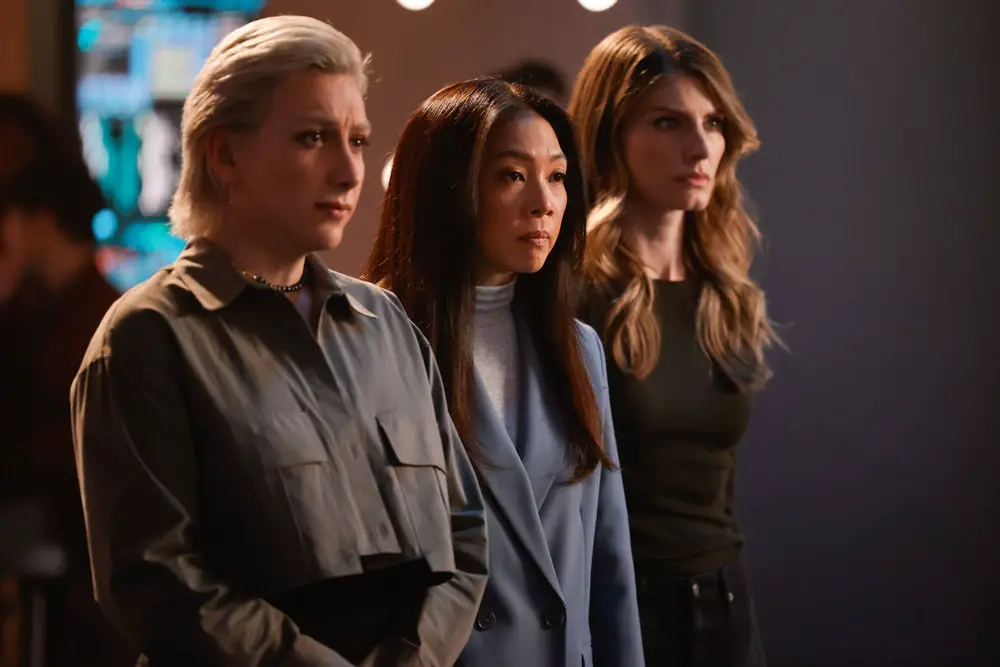
Team Quantum Leap, meanwhile, has figured out that if Ben in the past can impact Jeffrey, Gideon Rydge (an identity Jeffrey took on to keep time travelers from figuring out his connection to Hannah) will effectively never exist, and a Butterfly Effect will occur, changing the present. Their initial plan is to get Ben to destroy Jeffrey’s science project, which in the original timeline got a lot of business attention and kicked off his career. But shattering a child’s hard work and confidence doesn’t feel very Quantum Leap, so naturally Ben tries a different route. He brings Jeffrey along on his attempt to save the race car driver.
Back home, the stakes are upped when Jenn breaks into HQ to stop Gideon from entering the accelerator, and there’s a long, dramatic moment where Gideon threatens to have her shot if she doesn’t stop uploading the program that will lock him out of the accelerator. Of course she refuses, and of course they shoot. (Why don’t they just shoot her tablet? Or incapacitate her and snatch the tablet from her hand? Because we need drama!). So now Jenn is dead in this timeline, and we’d better change it!
This being Quantum Leap, Ben successfully shows Jeffrey the light when the two work together to save the race car driver (Jeffrey helps Ben build a defibrillator using a car battery). That one moment of do-gooder-ness is the Butterfly Effect needed… now, Jeffrey no longer grows up to be evil. Addison steps out of the imaging chamber and learns that the present has changed; she still remembers the old timeline because of said chamber, but no one else does. Jenn is very much alive. Gideon Rydge doesn’t exist; Jeffrey Nally grew up to become one of Quantum Leap’s biggest supporters.
As for Hannah? Well, she and Ben get one last nice moment together before he ostensibly leaps out of her life for good. While I’m glad that story line is wrapped up, and that her widowhood didn’t make her conveniently single for Ben to romance again, the whole thing felt clumsily executed. In the end, she was just a vessel to birth the season’s Big Bad and come up with the magic Bring Ben Home equation. A plot device, never really a character.
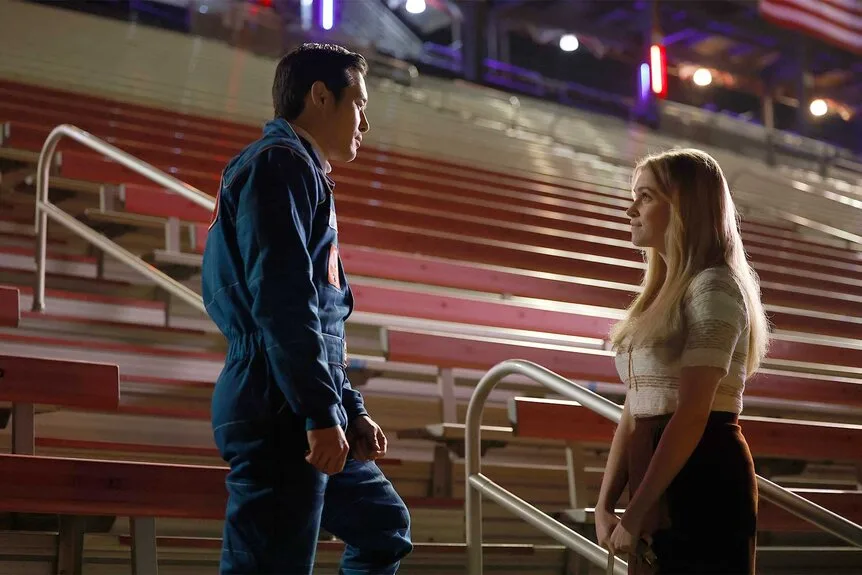
But hey, at least this means Ben and Addison can get back together at last! Now that Tom is out of the picture (and thank goodness there was no villain turn for him, which means I don’t have to throw the whole season in the trash), Addison can once again explore her feelings for Ben. Overall, I didn’t mind the direction their relationship took this season, at least on Addison’s end (Her falling for a new guy years after Ben apparently vanished for good makes total sense. Ben falling for a new girl, like, a week after she broke the news was ick.).
Since Hannah’s magic equation will swap Ben for a new leaper rather than bring him back directly, they need a new volunteer. Of course, it’s Addison. She was supposed to leap originally, after all. Then they say something vague about “home” not being a place, but a person. I think we all know where this is going…
Addison steps into the accelerator and ends up in a World War 2-ish setting. But Ben doesn’t emerge — he’s there too. Because home is a person, get it? Aww, they get to leap together now!
The show hasn’t yet been officially renewed for Season 3, and the show runners have indicated that they have plans for future episodes, but if this is the end for this incarnation of Quantum Leap, at least it’s a happy one.
Was it all a bit Accelerator Ex Machina? Definitely. Did the writers wave off questions of logic (and bodily consent) in order to force their plot plans forward? For sure. But at least in the end, they set things right.
2-Part Finale Rating: 4 / 5 stars. Despite all the too-convenient plot moments, both episodes were quite enjoyable to watch.
Season Rating: 3 / 5 stars. Mostly entertaining when it wasn’t being obnoxious. And they pulled everything together at the end!
Sometimes, things just hit at the right time. It was New York Comic Con 2013. I was writing for a transgressive culture website called “Moneygunsweed.com.” Like the Electric Banana, “Don’t look for it; it’s not there anymore.” Though not my first rodeo at the Javits, that year was my first foray into the venerated hall of immeasurable talent that is Artist Alley.
To be among so many whose art you admire can be somewhat intimidating… but that year I knew a face among the group of creators. Memory, much like the intrepid mountain goat, takes a slip from time to time, but I feel like I was a fan of The God Machine creator Chandra Free for even longer. Her febrile talent jounced my sensibilities, an elixir combining the inky freneticism of Jhonen Vasquez, and the romanticism classic 80s goth punctuated with madcap Merrie Melodies-esque moments through side characters, all in the color palette of a fever dream I don’t mind being entrenched in.
The interaction between Chan and me that year lasted probably no more than a sweaty handful of awkward moments on my part, but the reception couldn’t have been sweeter if you baked it and put in on a fucking windowsill. I had no college radio show at the time, and no podcast to speak of yet. Stock in myself approaching a total stranger whose oeuvre I’d loved was nowhere to what it is now. However, Chandra never felt like a total stranger, for there was something subcutaneous in her work that clawed at me, something that was just at the right time. Plus, the leatherbound edition of The God Machine was also too divine to pass up.
It’s been 11 years, infinitesimal in the grand scheme of things, but a decent chunk of minutes lived. The hoary winds of Fate have entered the chat, and despite this being my first proper chat with Spooky Chan, our conversation seemed to reverberate with an energy usually reserved for old friends catching up. Chan never felt like a stranger through the years, however. Her art always felt like home to me. Yet, it didn’t allow my brain to grant it residence. Rather, it tore the door from the frame, fired up a Djarum Black, and sauntered in… Hey, I ain’t complaining.
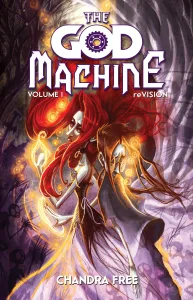
Chanda Free: The God Machine started in 1999 when I was in high school, so it was a concept I really enjoyed, and my background [loving] Disney, Warner Bros.–
Robert Kijowski: The good stuff.
CF: Yeah, the good stuff! Me and my cousin [Lindsey Cibos] would watch Disney television and other programs like Gargoyles, Batman: The Animated Series–
RK: Amazing.
CF: We would tape them, pause them, and then recreate what we saw because we’d seen certain poses, and we didn’t have the books or anything like that. So, we would just like to practice and practice and practice… When you think about that, those are my biggest influences early on. All of that 80s/90s pop culture and stuff like that because I’m an old person.
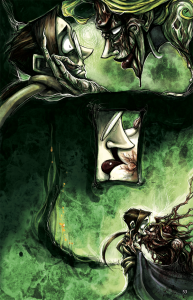
CF: Guy [Salvatore] is very much me, but I did not act out towards people I didn’t like. I didn’t like yell at anybody or anything like that. I was more morose and in my own head, and in my own world. Guy is like the part of me that didn’t get to shine through, I guess you could say.

CF: A Perfect Circle, “Mer de Noms”. That was kind of the mantra of 2000 when it came out. We were listening to that non-stop and it’s one of those albums I come back to every so often and it’s a good playthrough from start to finish, but also… “Songs of Faith and Devotion” from Depeche Mode is another really friggin’ great album. God… ugh! Music, I love it!!
CF: I owe it to my fans. I owe it to myself.
RK: Yes.
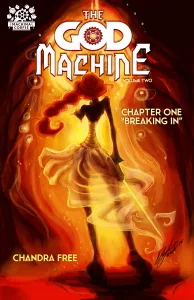
CF: I mean, I got the creative bug again and I don’t know why. I’m not going to question it.
RK: It’s a gift.
CF: Oh, yeah. Oh, wow. What a gift! (laughs)
RK: … I was saying that half saying that seriously… as a creator myself, it’s a gift… until it’s a curse.
CF: Oh yeah!… like, it’s always going to be a curse.
RK: It’s the Ouroboros. It’s just the snake eating itself. Which I would have no other way. This madness of creation, I would have no other way, personally.
CF: I’m just so thankful for my brain kicking in and being like “Let’s do Volume 2.”
Machina Corpse is a spooky comics imprint from the minds of Chandra Free and Stephen Emond. The company was founded in 2019, successfully Kickstarting comic publication FIRST OFFERINGS. They had further success with Kickstarter in 2022, funding the relaunch of The God Machine, Volume 1 re:VISION graphic novel and art book, which can be purchased at: https://machinacorpse.myshopify.com
I genuinely enjoyed Morbius and remain baffled at the hyperbolic hate it received, but Madame Web deserves to be crushed under the boot of a gleefully destructive Internet. I am kinder than most, of course, so I found some saving graces here and there, but… this movie is legitimately bad, folks. There’s no getting around it.
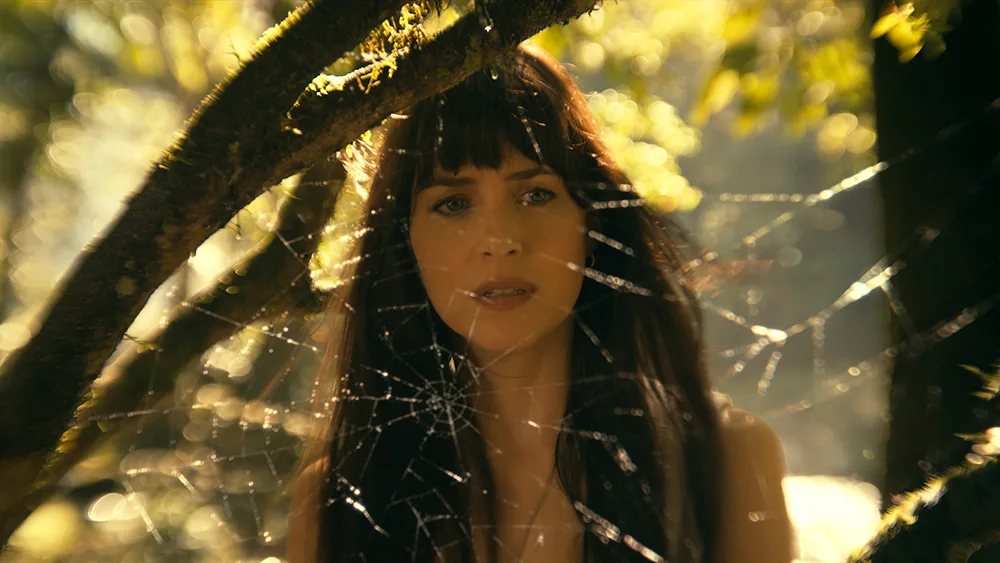
The film begins when Ezekiel Sims was in the Amazon with Cassandra “Cassie” Webb’s mom when the latter was researching spiders right before she died, and when the film flashes forward to thirty years later, he has not aged at all and it is 2003. The only reason this movie takes place in 2003 is because it features Peter Parker as a fetus in the belly of EMMA ROBERTS for some fucking reason. The fact that Peter Parker is a fetus in the belly of Emma Roberts has absolutely no bearing on the actual plot of this movie, and it is fucking embarrassing how much Sony tries to remind you about Spider-Man in this movie.
They say the word “spider” three hundred times! Adam Scott plays Uncle Ben! One character casually namedrops her uncle (J.) Jonah (Jameson)! Look, I have enjoyed the Venom movies, and as I already stated, I enjoyed Morbius, and everyone hated those movies for their tenuous connections to Spider-Man, but this movie actively annoyed me with its shameless pandering. THEY EVEN GANK GREAT POWER/GREAT RESPONSIBILITY.
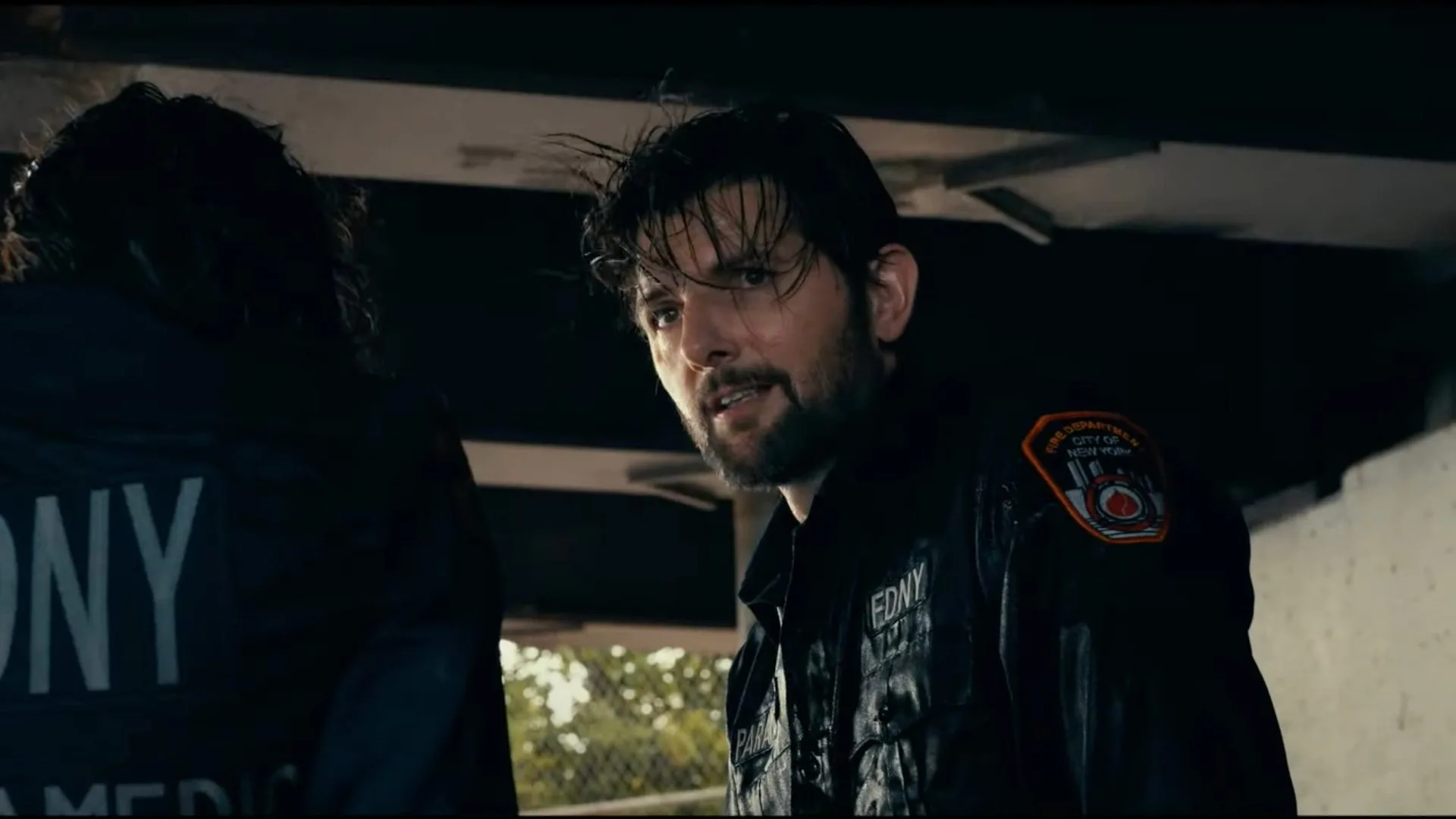
Okay anyway the actual plot of this movie, which it took four (4) people to come up with—Matt Sazama and Burk Sharpless (writers of the aforementioned Morbius), director S.J. Clarkson (a TV director making her film debut and failing spectacularly), and Claire Parker, with a story credit to Kerem Sanga, so make that five (5) people, but also an additional literary credit to Chris Bremner, so make that six (6) people—is that Cassandra “Cassie” Webb has her precognitive spider powers awakened (she’s a spider-woman who can see the future; Cassandra Webb, get it, comics are amazing) and must protect three teenage girls named Julia Cornwall, Mattie Franklin, and Anya Corazon from Ezekiel Sims, a spider-man who seeks to kill them because he has a vision of them killing him (as costumed superheroes, not teenage girls). I cannot stress enough how much this is the entire plot of this 115-minute movie.
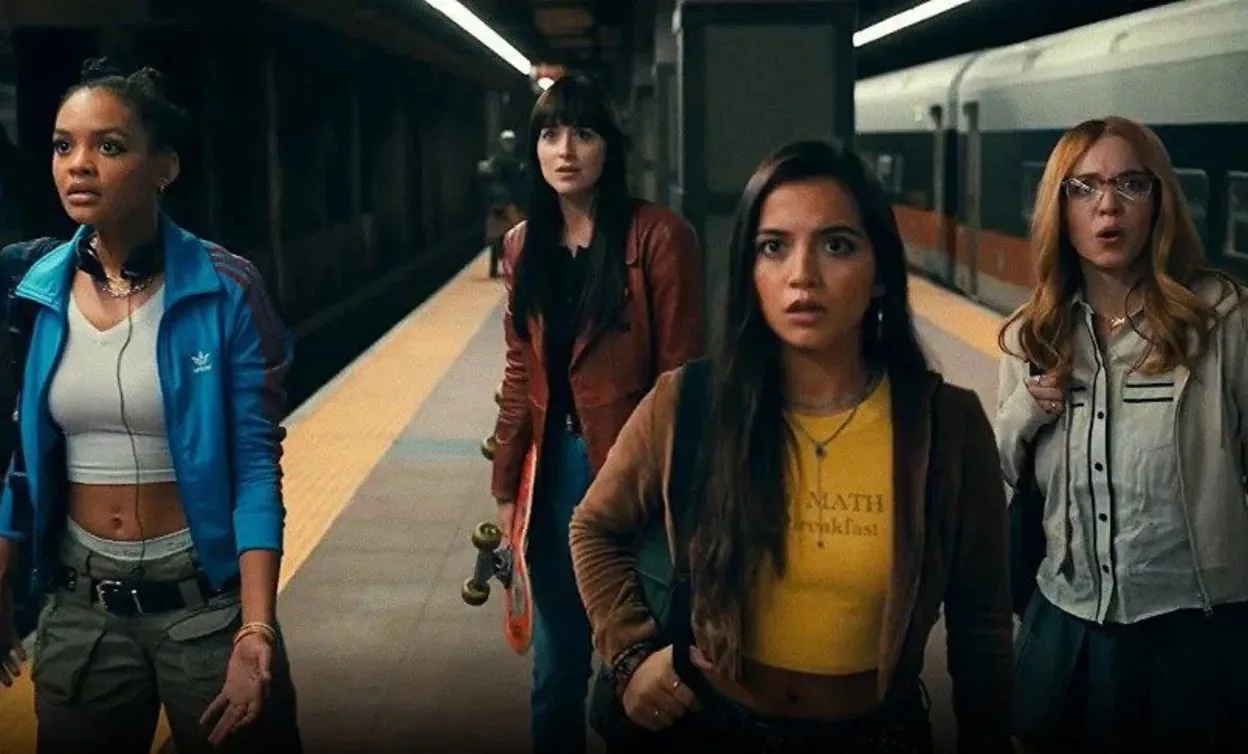
Would you believe me if I told you she doesn’t even meet the girls she’s supposed to protect for NEARLY HALF THE MOVIE? Believe it, believe everything I tell you about this movie, I would never lie to you. Believe me when I tell you this movie takes a looooooooong time to get to the fireworks factory, and I mean that because the action climax of this film occurs at a LITERAL FIREWORKS FACTORY.
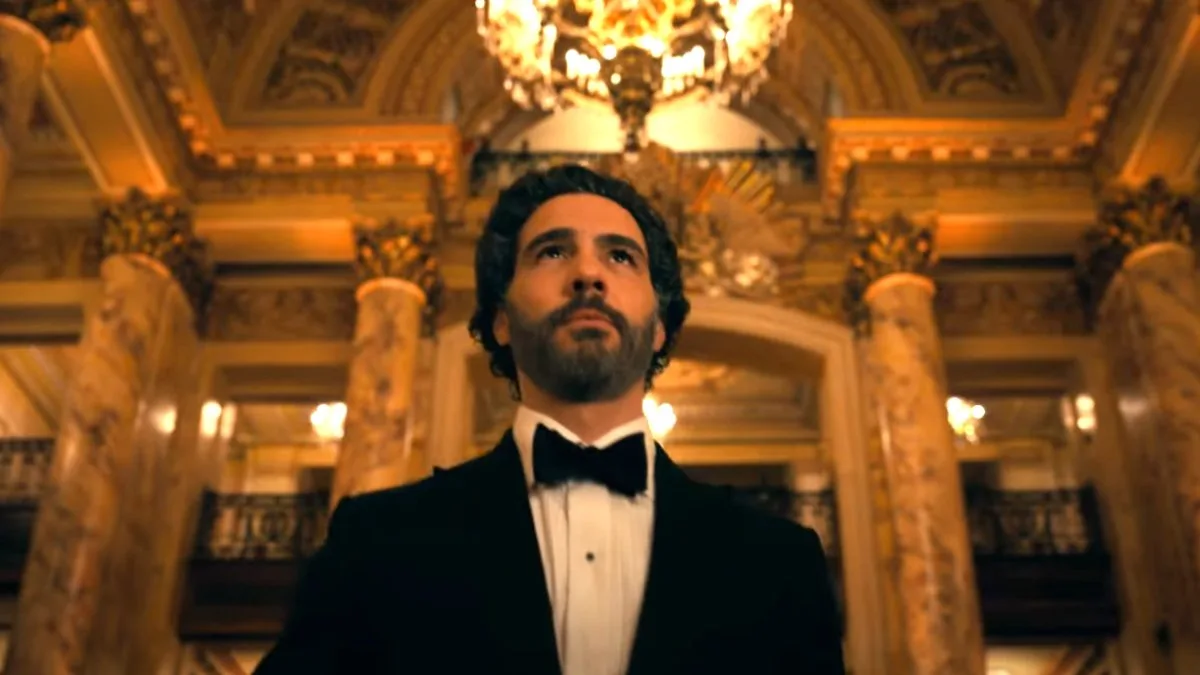
The villain of this film, Ezekiel Sims, has one goal and one goal only, and while I can understand not wanting to die or whatever, Tahar Rahim does nothing with this character to make him interesting or intimidating or memorable, struggling to deliver his English lines in a semblance of an American accent as his French accent keeps slipping through. He has visions, but also he can crawl on walls, but also he can talk to Cassie in her dreams? His power set is very unclear, and also why did he not age in thirty years. Also why is Zosia Mamet here, what favor did she owe.
The three teenage girls named Julia Cornwall, Mattie Franklin, and Anya Corazon are not endearing or likable at all, so we don’t have a real attachment to them apart from the fact that we see a vision of them becoming badass superheroes that will not be fulfilled in this film. Sydney Sweeney is awful here, a vapid shell of a human being. Celeste O’Connor is annoying here, a one-note jerk of a human being. Isabela Merced is… okay here, a science nerd who wins my affection by default despite not being an actual character.
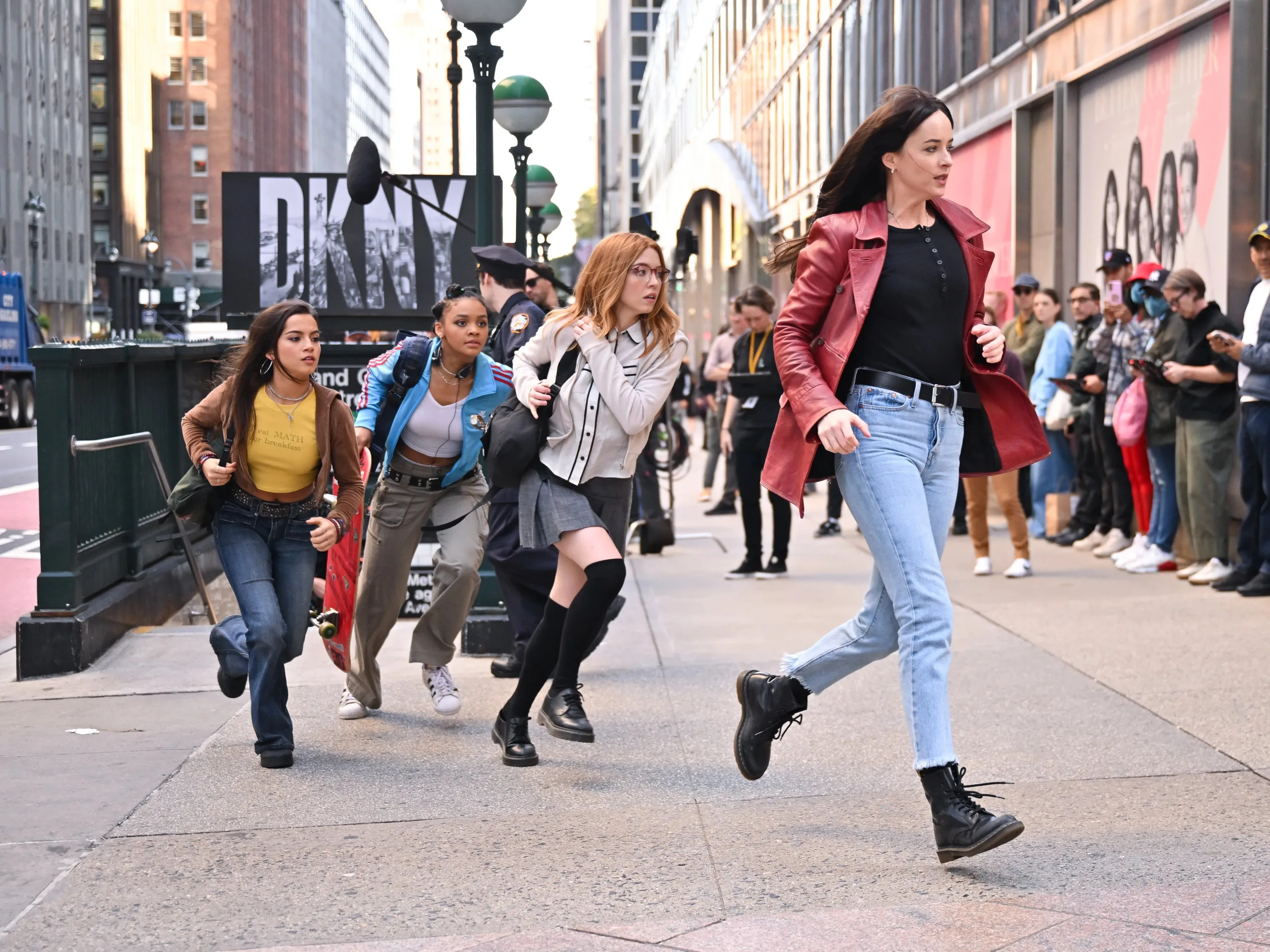
These three girls who are established as having no connection to each other somehow get drawn to the same place because of destiny or whatever—and look I could be into this shit if done well but it is not done well, that is basically this movie’s ethos, take something I would be into and not do it well—and despite being complete strangers, immediately act like they’ve known each other for years. Their relationship to each other makes no sense, their relationship to Cassie makes no sense, I could be into this found family shit if done well but remember what I said about this movie’s ethos.
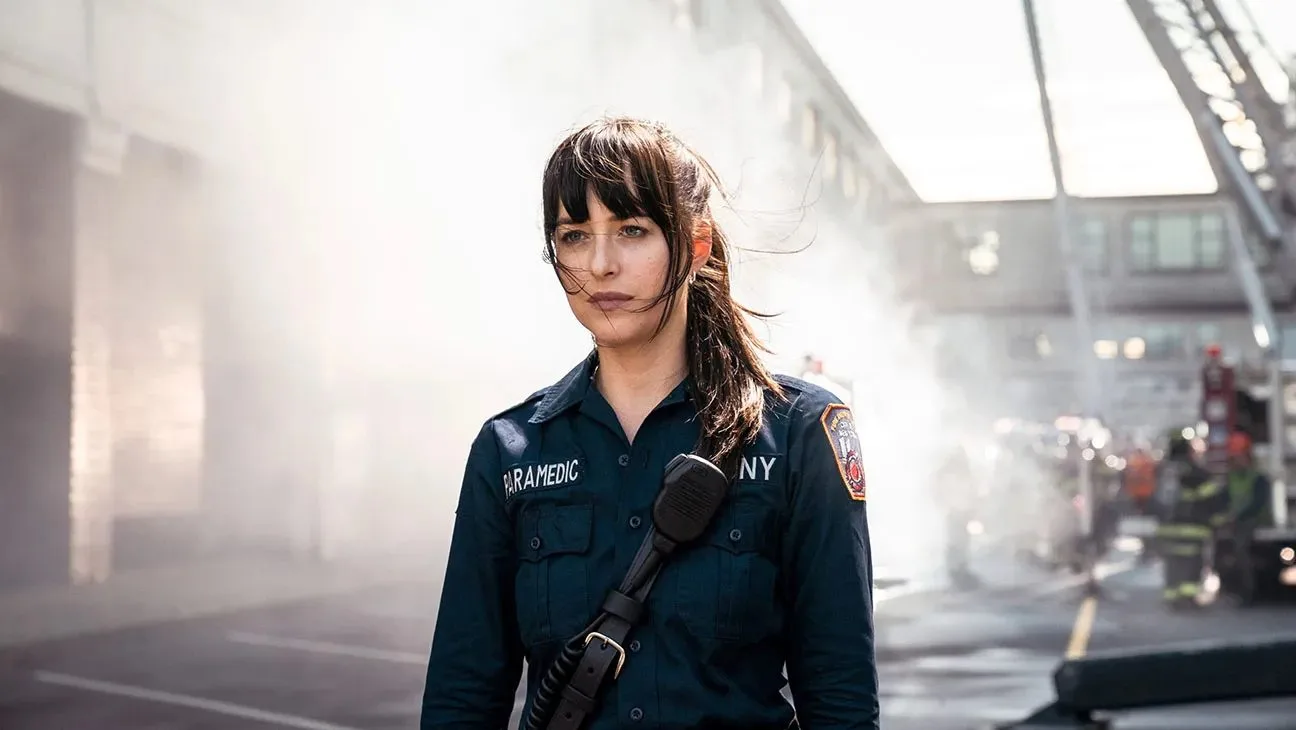
The protagonist of this film, Cassie Webb… is good! And by good I don’t mean good, I mean that I really enjoyed Dakota Johnson not giving a shit in this movie. There’s about twenty percent of the movie where she’s kind of acting in a dramatic fashion, but the other eighty percent? She does not want to be here, she thinks this is all stupid, and it honestly makes Cassie a fun character unlike other superhero protagonists. I can see why Clarkson, who directed a couple episodes of Jessica Jones, likened her to Jessica Jones because they do have a similar “I’m so over this but I guess I gotta save people” vibe. For all the failings of this movie, Johnson’s entire presence manages to make this film far more watchable than it otherwise would be.
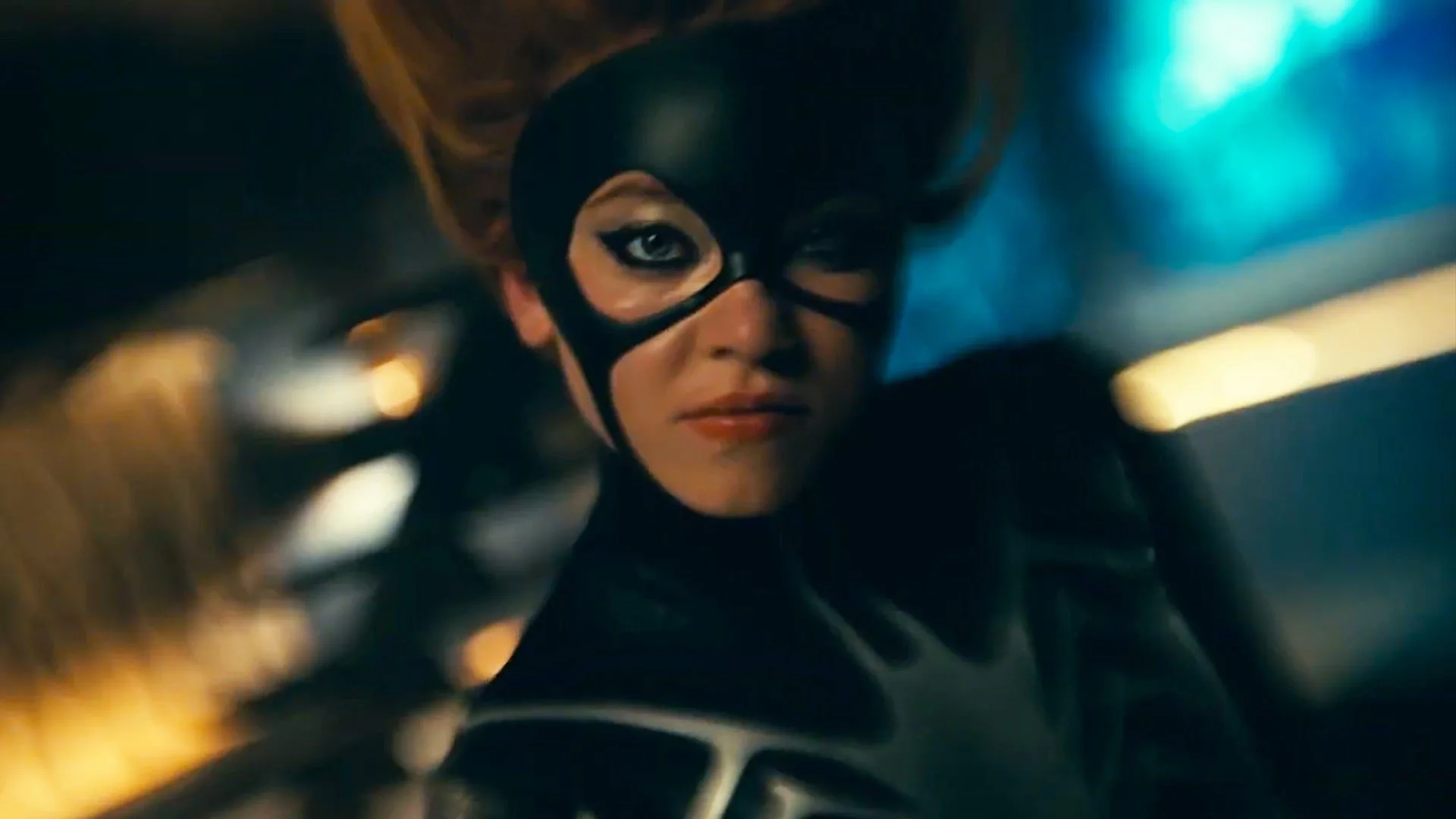
Which is impressive because everything about the way this film depicts Cassie’s clairvoyance makes the film borderline unwatchable. Initially, it’s effectively disorienting by showing a scene happening and then revealing it to have been a vision, putting us in the same POV as Cassie. But as the film progressives, it gets more and more inconsistent and chaotic, with multiple visions occurring at the same time, visions being thrown in piecemeal, visions resetting back to different points… like… this is the only reason this movie exists, right, to have your psychic superhero, and you can’t even show her powers without being incoherent?
Also why did you take a comic book character who is elderly and has myasthenia gravis and turn her into a movie character who is young and does not have myasthenia gravis. You know what comic books fans love? Changes.
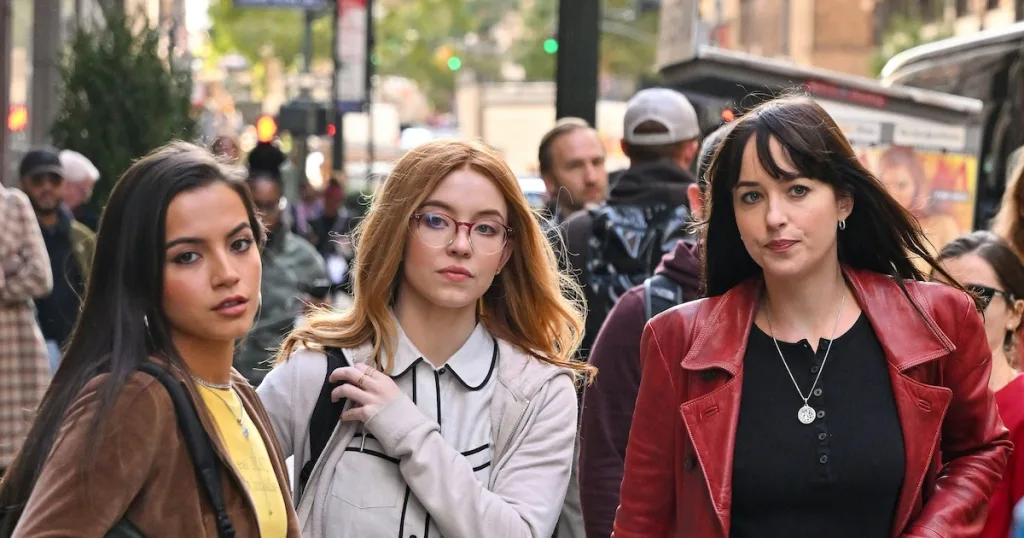
Speaking of borderline unwatchable, someone please take away cinematographer Mauro Fiore’s membership to the ASC because I have no idea why he is sometimes switching to some kind of demented documentary style with random push-ins and pull-outs. I thought he was having trouble focusing the camera and they just left it in the movie. I’ve never seen anything like it.
At one point Cassie steals a taxi and then she just drives it around for the rest of the movie. She crashes it, it’s beat up, and she keeps driving this stolen taxi. She drives her stolen taxi to the airport, pays to leave it at the airport for a week, and then drives her stolen taxi home. At no point does she return this stolen taxi. As far as I know, the stolen taxi is now her car at the end of the movie and she is a wanted fugitive.
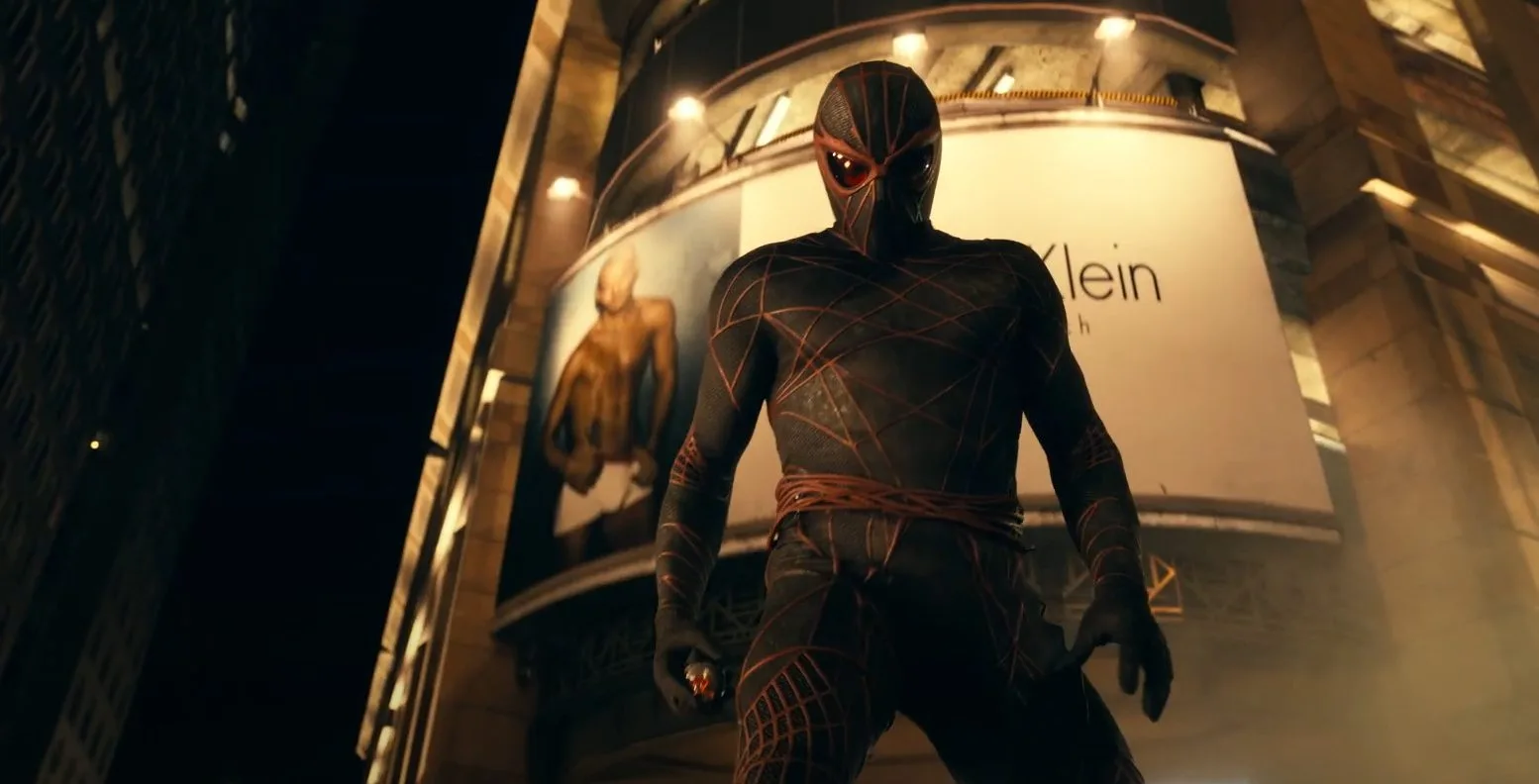
There is some stuff I actually liked in the action climax! Un-ironically cool business that is actually done well! And then it gets incoherent again, but for a few minutes there, damn, four stars, baby, four stars. There’s a little subplot about how Cassie feels about her mom that’s almost almost emotionally affecting. There’s Cassie’s whole character arc about embracing these teenage girls as her own. There’s a genuinely funny gag where Cassie checks to see if she’s a wallcrawler. There’s this bit where the girl whose thing is riding a skateboard does a skateboard-type thing in the action climax, FOUR STARS.
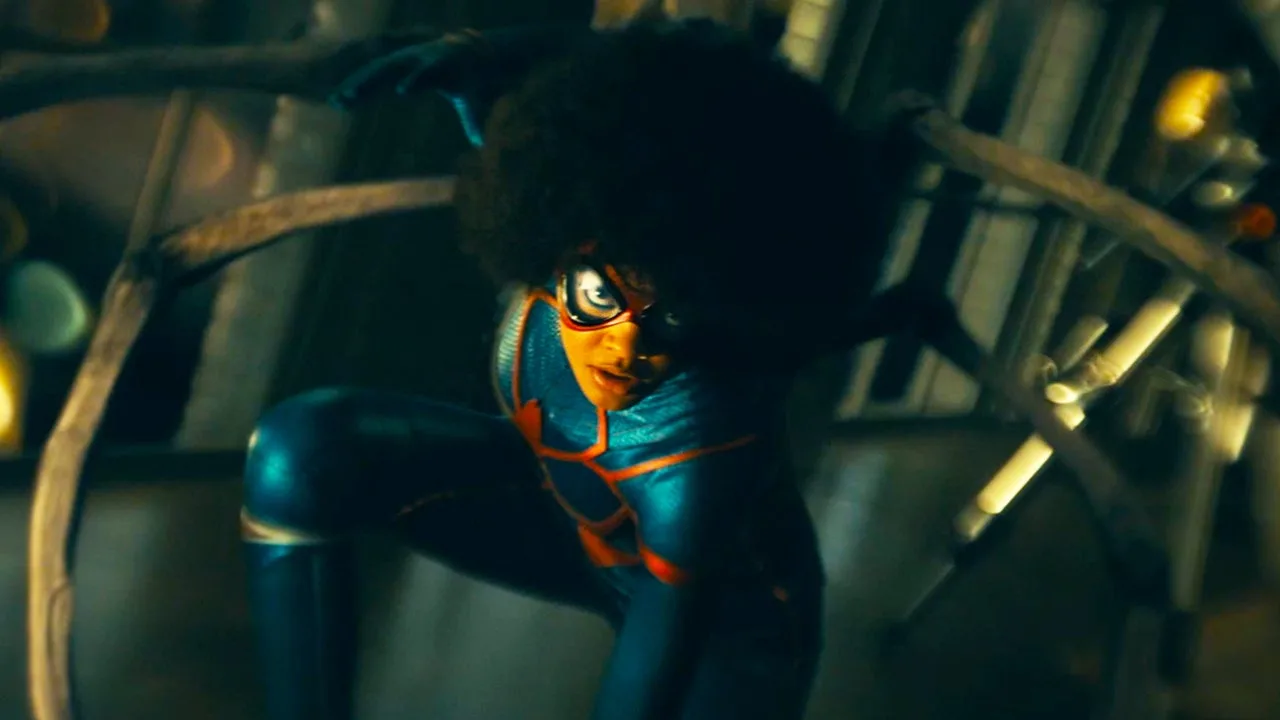
But then there’s the completely embarrassing sequel tease at the end that made me understand why some people describe this movie as a two-hour trailer because yeah. I went to see this at the drive-in because I wanted to go to the drive-in but needed a movie where I wouldn’t mind if the picture and sound sucked. So thank you, Madame Web, for being a movie that sucked.
Recently, I got to perform the score of The Lord of the Rings: The Two Towers on stage at Radio City Music Hall, where they played the movie and had live instrumentalists and singers perform the music. I was one of 100 adult choristers as part of MasterVoices (altos rule!); there was also a children’s choir (Brooklyn Youth Choir), a full symphonic orchestra (the Orchestra of St. Luke’s), and a mezzo-soprano soloist (Kaitlyn Lusk), all under the baton of Maestro Ludwig Wicki, who worked with Howard Shore to adapt the music for a live show. According to the show’s posters, that was 238 musicians total, and according to how crowded that stage was, that is absolutely accurate (seriously, my score kept whacking into those of my fellow altos).
Don’t let that photo fool ya; the show sold out (the pic was taken by an early birdie who got there before most of the audience). It was quite something, to hear 6,000 movie fans cheering their favorite moments and lines and meme moments.
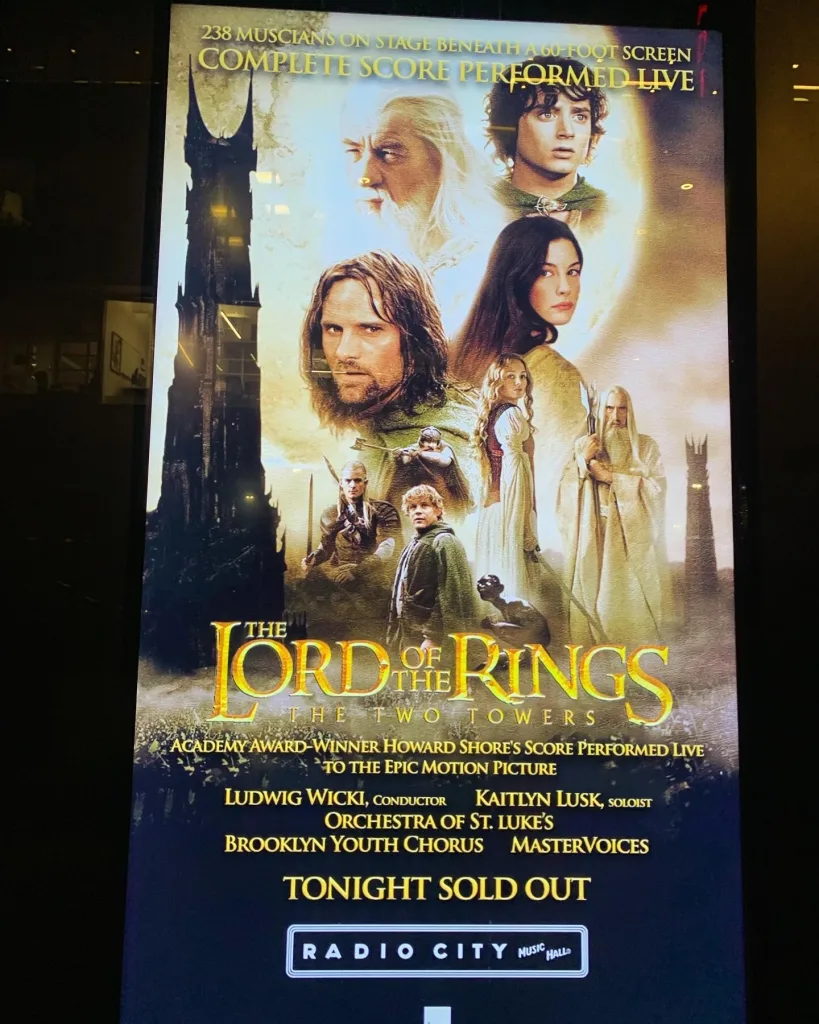 Here are a few fun facts from behind the scenes.
Here are a few fun facts from behind the scenes.
1. The show is performed around the world, and singers all use the same scores.
They’re issued to us before rehearsals, and we have to return them when we’re done. Which means pretty much all the scores have notes, cues, and markings written in by previous choristers, in an assortment of languages. The Maestro and the soloist travel with the show, but the orchestra and choirs are local.
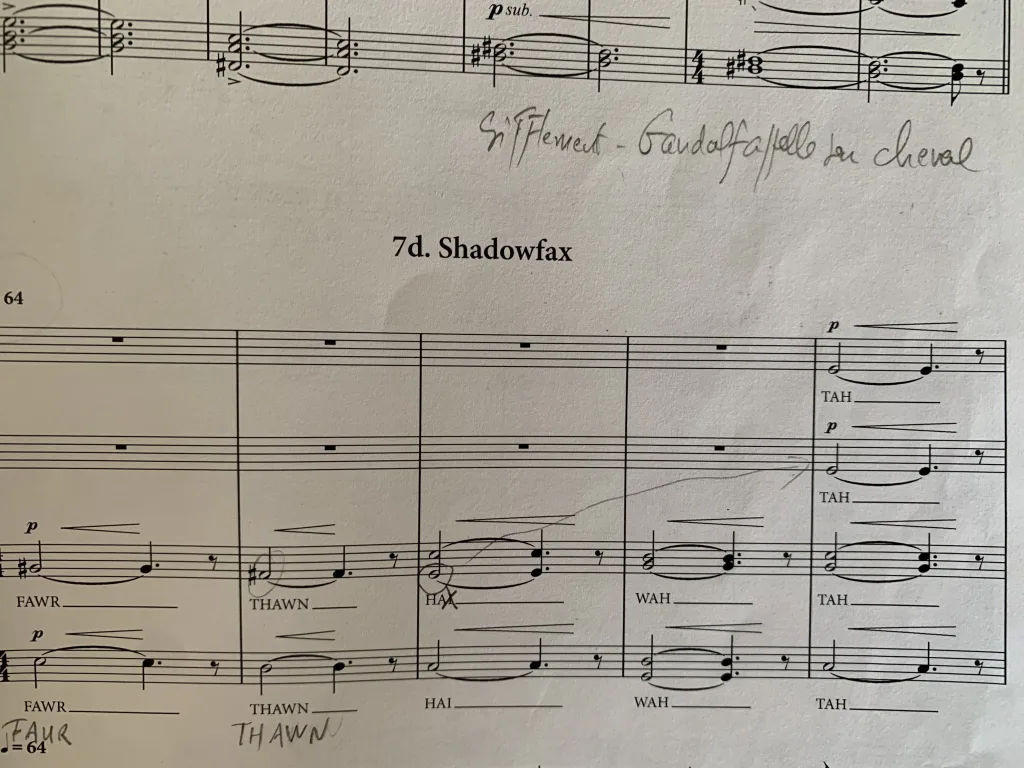
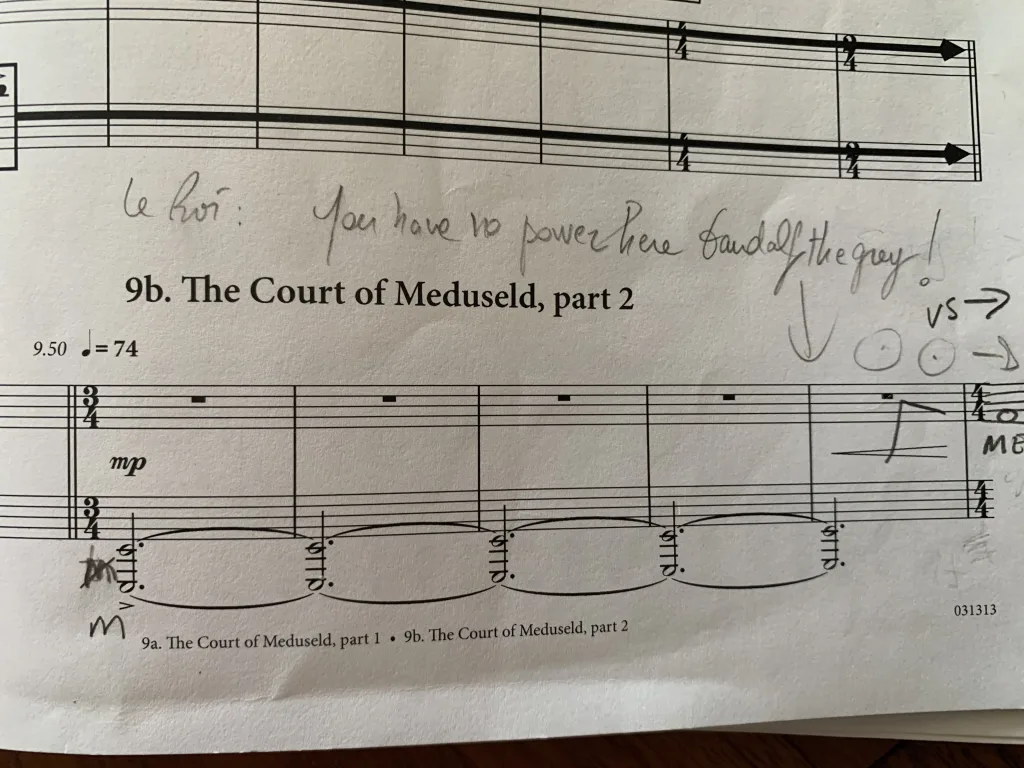
2. Lyrics? What lyrics?
According to Maestro Wicki, the music comes before the text, which is used more as a vocalise than actual lyrics. Apparently, Tolkien scholars have written to Shore pointing out mistakes in the text, which Shore heartily ignored. Text is presented in the score as a series of syllables. For instance, here’s The Last March of the Ents.
What the text Sindarin says:
rithannen i geven
thangen i harn
na fennas i daur
ol dûr ristannen
What we see:
REE THAN NEN EE EH VEN / THANG GEN EE HAHRN / NAH FEN NAH EE DOWR / OLL DOOR REE THAHN NEN
By the way, that’s not the end of the musical phrase. The end of the phrase comes in the middle of a word, and the boy soprano soloist begins his run on the second syllable of said word.
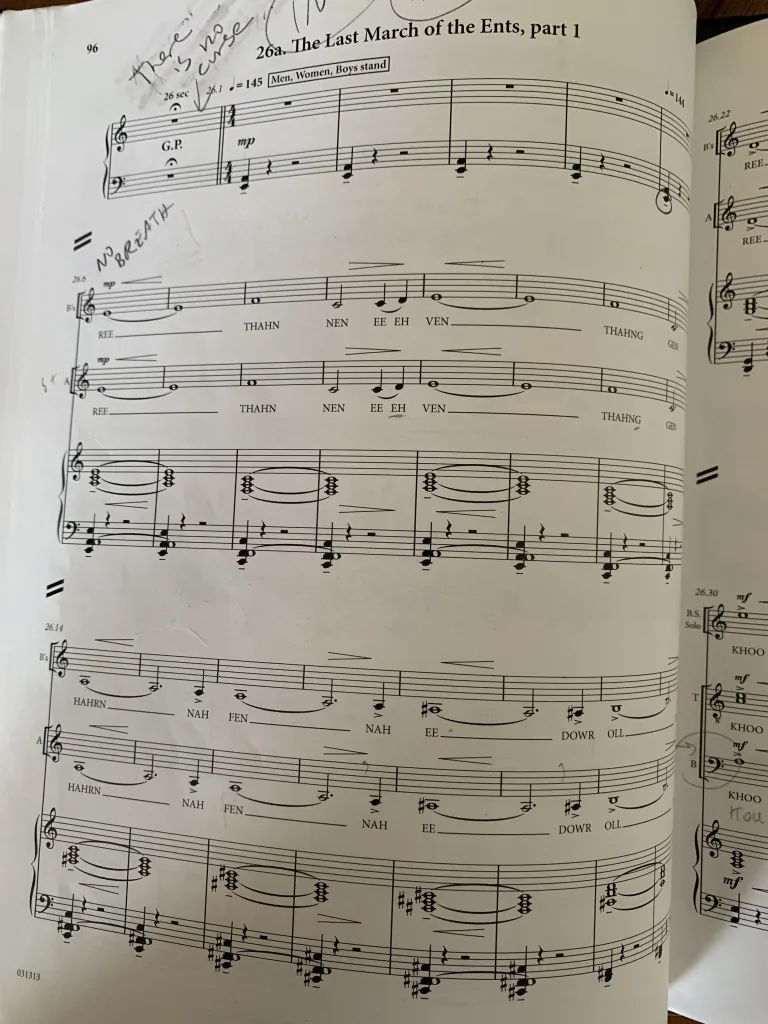
3. There are more choir parts in the stage show than in the movie
At least the version that’s on Amazon Prime. I watched The Two Towers with my score, mostly out of nerdy curiosity but also because I wanted to see which scenes our singing lined up with. There were multiple parts where my score showed choir entrances, but I didn’t hear any singing in the film. My guess is that some choir parts were taken out during the sound mixing (or sound editing?? what’s the difference??) process to avoid clashing with dialogue. Also, in the Dead Marshes scene, the choir provides a sound effect by whispering text…
4. The tempo changes A LOT
To keep up with the push and pull of dramatic moments in the movie, the pacing of the music is constantly shifting. There are some parts where we have a different tempo in every measure… things might be getting increasingly faster to build up to a big moment, or slow abruptly for dramatic effect (such as when Gandalf the White appears). The time signatures are also super fluid—one measure might be in 3, followed by one in 5—which allows the music to stretch out or contract. The only way to keep us to watch the maestro LIKE A HAWK.
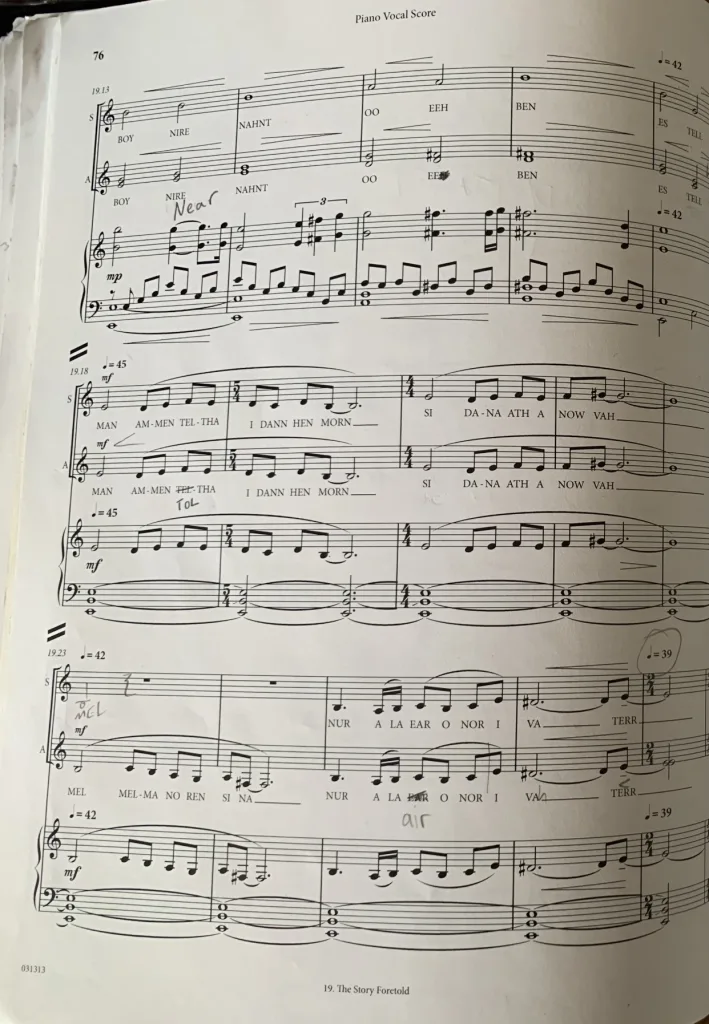 5. Maestro Wicki mouths along to a lot of parts
5. Maestro Wicki mouths along to a lot of parts
Speaking of Maestro, because he needs such precise pacing for the movie (which, after all, will not stop and wait if we fall behind, or speed up if we get ahead), he’ll often mouth the syllables of the choir parts to show us exactly what timing he wants. As long as we mirror him, we’re good!
There are also a few parts with no music, and he’ll sometimes mouth along to the movie’s dialogue just for fun (my favorite is him doing “PO-TA-TOES!”)
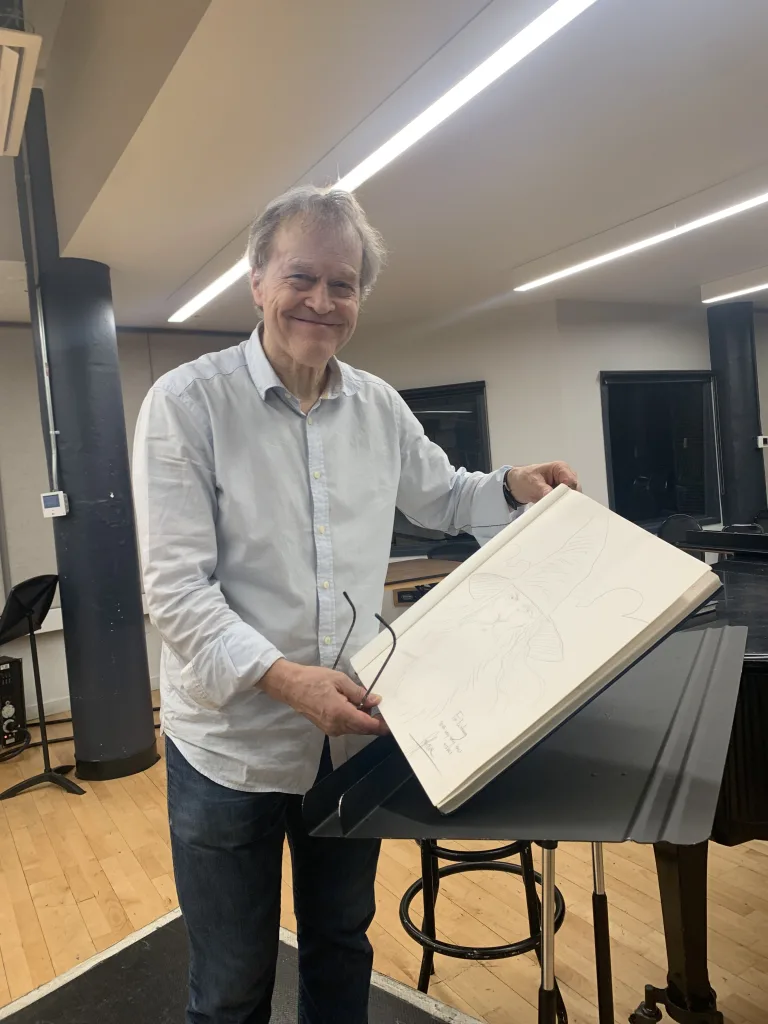
6. We breathe at random times
The Lord of the Rings music includes a lot of suuuuuuper long phrases, and no individual human could sing for so many measures without breathing. Fortunately, there are a hundred of us in the choir. To give the illusion of unbroken lines of music, we all sneak breaths at random moments. Just don’t breathe at the same time as your neighbors…
7. The choir can barely hear the movie
The sound design at the theater is for the audience to get the best audio experience, and the speakers are actually in front of the stage. Which means from the back, where the choir is, we can barely hear the movie, and what we do get is weird and reverb-y. Especially since we’re right behind the percussionists, and they are LOUD, there are several parts we can’t hear at all. We also can’t see the movie, which is behind us, which means we really have to rely on music cues to know when to come in.
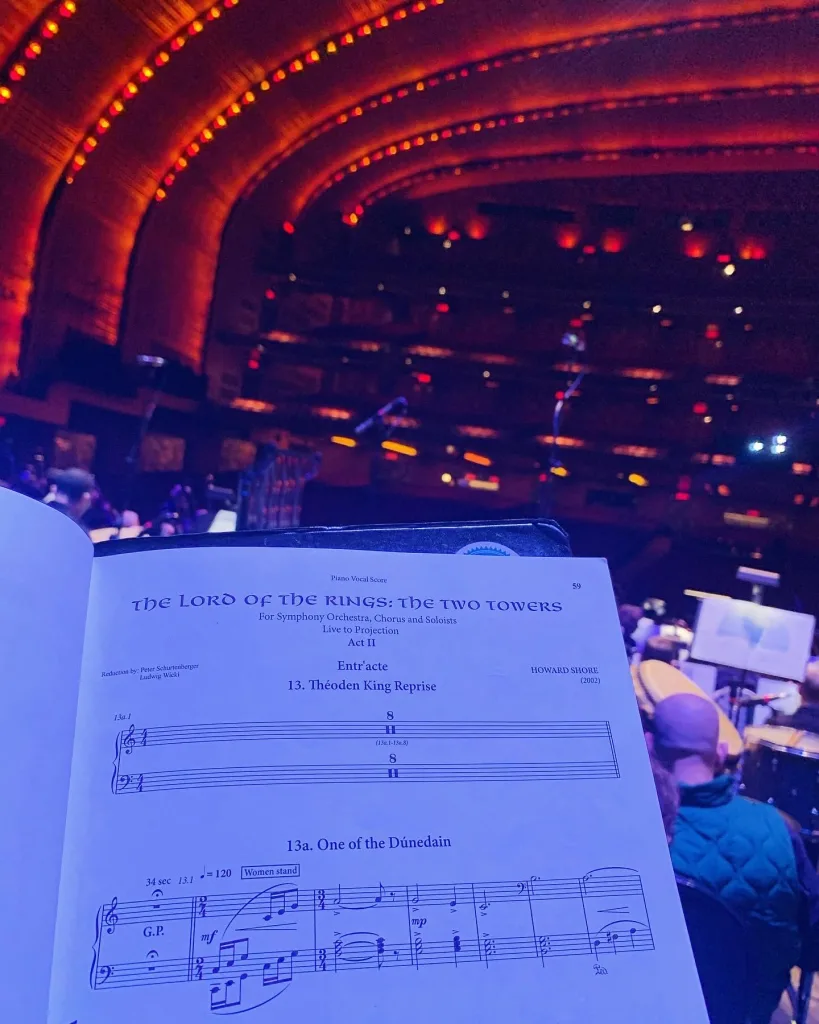
8. Dress rehearsal and the first performance are on the same day
From 1ish in the afternoon to 5ish in the afternoon, we did our dress rehearsal, which was the first and only time we got to run through the whole movie without an audience. At 8PM that same evening, we did our first show. The reason for that is so the show only has to rent the hall on the days we’re performing; otherwise the hall would be dark the night before (and be making zero moneys).
9. The dressing rooms aren’t on stage level
For the choir, they’re on the third floor stage left, which means to get out after the show, some of us have to get off, cross behind the whole stage, then go up three flights (or wait for the elevator… of which there is exactly one). So it can take a while to leave after the show!
10. The choristers don’t get paid
The choirs get paid, as in the organizations, but the individual singers (for both the adult and youth choruses) are there on a volunteer basis, because we love the music, and the opportunity to perform, and, in many cases, The Lord of the Rings.
Finales are tricky things. Most long running series have their work cut out for them, but high concept shows – even without having the trouble of a long run – pose a particular problem. Depending on the concept upon which they’ve been built there is added shit to deal with. Not only do you have your standard character issues to clean up, but you’ve got that high concept that needs settling.
La Brea plays it safe on all fronts. Ignoring many a plot-line in its race to the finish. Does it work? Is it a satisfying conclusion? Let’s see what happened and then get into the nitty gritty.
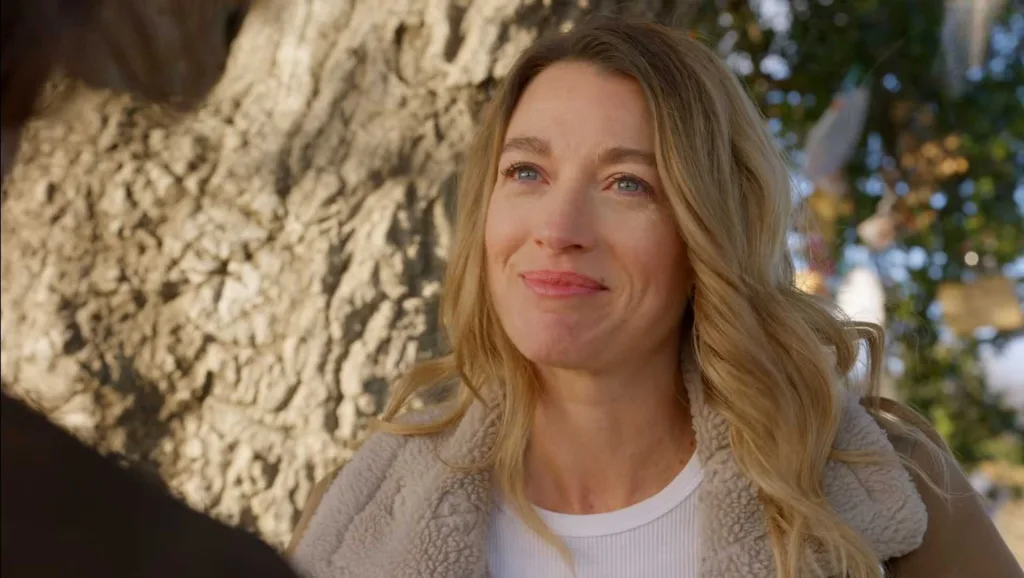
We start with a flashback featuring Gavin and Eve at the recently mentioned Wisdom Tree. Then we’re back in Los Angeles circa 1965 with Helena casually stealing a car to help them achieve their goals. Plan is simple: Use an EMP bomb to wipe out the servers thus destroying any time travel research at Maya’s main facility. Are we worried about there being other, backup servers, in other, more secure locations? No. No, we are not. This is the only one and once we destroy it that’s it! No need to concern ourselves with James or Caroline. Nope. This is the ONLY source of time travel tech. Whew!
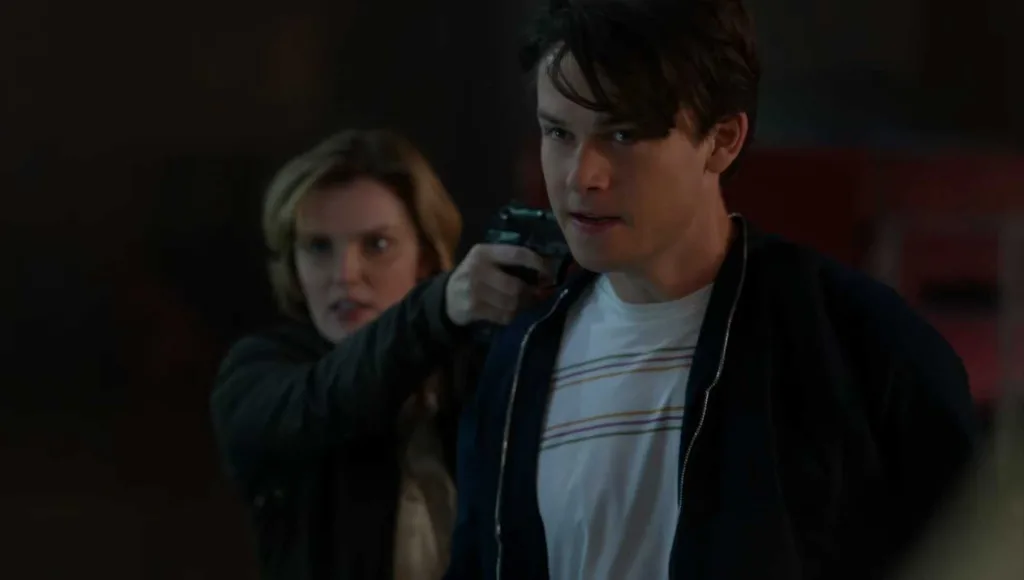
Back in 10K B.C. Scott explains how the double aurora works and Ruth and Leyla assure Veronica and Lucas they will lead their people here so they can go home if they choose. Do we get to see any of our favorite background players? Nope. Not even Judah. Oh well. Let’s assume everyone that wanted to was able to travel back to 2021 sans issues. Also, it might be good to note that, if Ty’s experience is to be the bellwether, aren’t they all going back to two weeks before the sinkhole? So…what about their current selves? Hmm? We don’t have time? I mean, it’s a show about time travel, but ok, sure…SKIP! In fairness to 10K B.C. all is not resolved anyway, as you might recall Paara is still MIA. Luckily, Ty, Lucas, and Scott’s interrogation and subsequent investigation of the bad guys’ jeep reveals Paara’s ring. This leads to the discovery that a group of fort folk were attacked by dinos not far away. Scott is weirdly optimistic that Paara isn’t dead, and Ty clings to that hope.
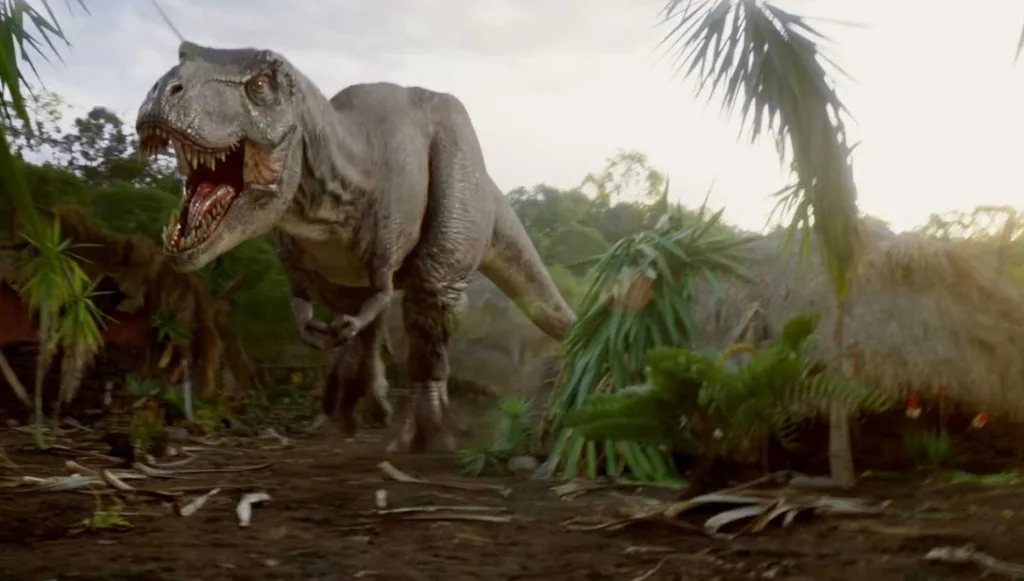
Essentially the 1965 story mostly involves Sam finding and performing emergency surgery on Riley. It’s a nice moment that allows them to bond as father and daughter, Sam finally opening up to Riley in the way she’s been wanting of him. And, while Gavin and co. reach the facility they miss Eve by that much. On the bright side, they get Josh back. Helena eventually reappears to describe a fight that could have been and explains Eve is staying in 1965 to set off the EMP bomb. Once that’s settled it’s off to the military base in 10K B.C. to end this!
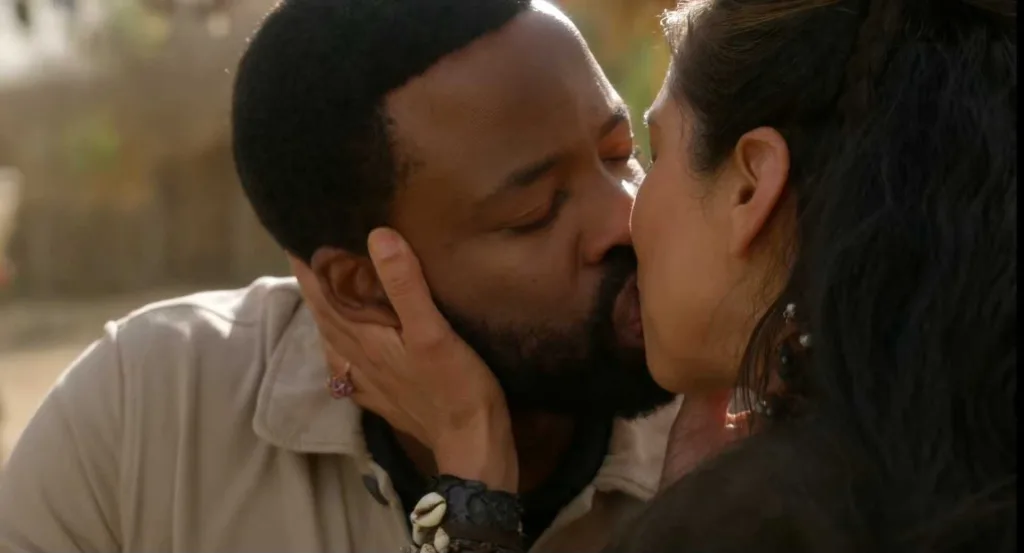
The 10K B.C. side is a large chunk of the episode, naturally. Ty reunites with Paara after a death-scare. They kiss, it’s very sweet. Ty reassures his beloved that he doesn’t want to live in a time without her, so 10K B.C. is home sweet home for him. Lucas and Veronica figure out what their future is going to look like – spoiler, Lucas is open to returning to 2021 thanks to the love of his friends and family. If you noticed Veronica’s cramps and thought something more might be coming, I assure you it’s not. There simply isn’t time for it. Instead, it’s played off as her stressing out about having a kid giving Lucas the opportunity to once again lift his woman’s spirits – which he does to excellent results. Their relationship is one of the sweetest parts of this season and though I wasn’t 100% convinced of this couple in the beginning, I’ve been pleasantly surprised. Granted, a lot of that is due to the truncated season forcing optimal couple goals, but still.
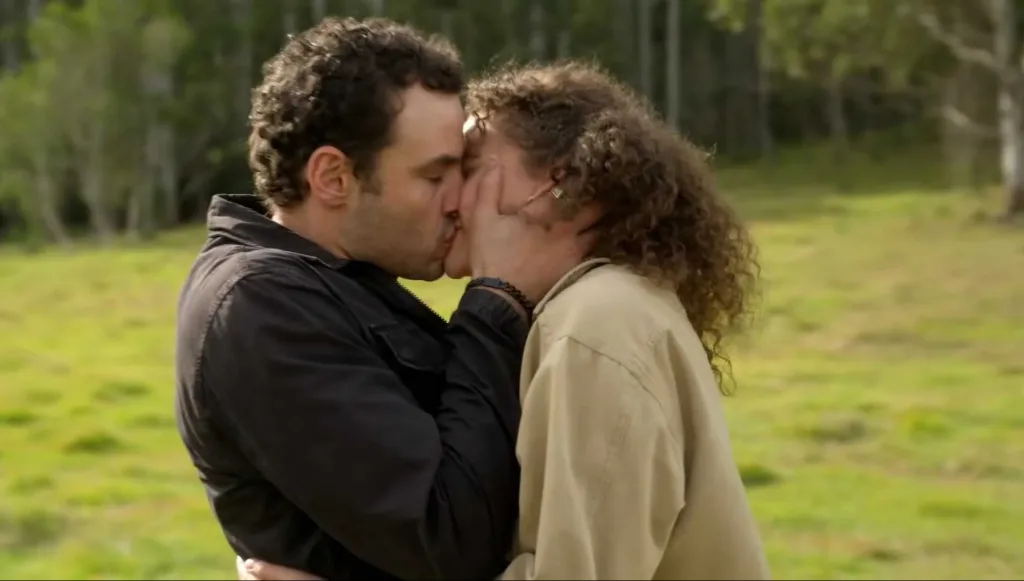
After those two issues are dealt with, it’s just a matter of Gavin and co. storming the military base (with the aid of a T-Rex) and getting the chip. Scott and Lucas have a briefly described side quest where they rescue Petra – in a full season we definitely would have seen this play out in great detail, but much like the fire fight Helena describes with Eve we’ll just have to imagine what could have been. We do get one semi big fight scene. See, after getting the chip, Maya and a boatload of soldiers show up to stop the gang from escaping. But, then Ty, Paara and the rest of the fort folk (and I’m guessing any sky people who didn’t choose to go back to 2021) show up as reinforcements. All hell breaks loose, Leyla gets to make up for betraying everyone by saving Izzy via arrow – they share a last longing look of what could have been, and then rejoin the others. It’s a short-lived victory though, because the aurora has closed.
That’s it right? Everyone is trapped in 10K B.C., yes? Nope! Don’t forget about the whole reason for the clandestine time travel project in the first place: fighter jets! Thanks to plot, there’s room for everyone. But wait, there’s more! In a final desperate ploy, Maya takes Josh hostage and demands the chip. She gets it, plus a shot to the chest from Helena.
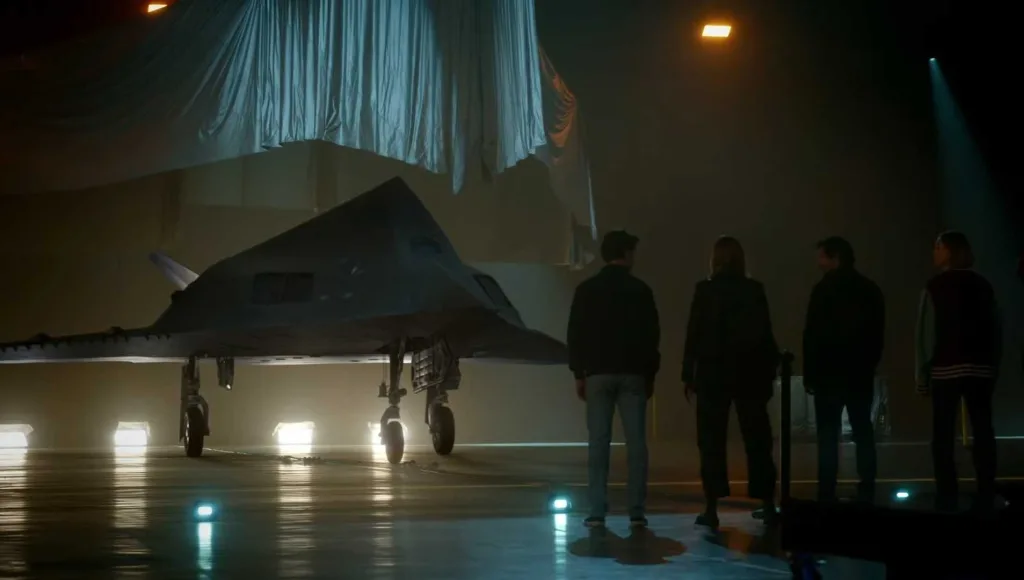
Alls well that ends well, literally. We are treated to a litany of happily ever afters. Lucas and Veronica’s baby is on track for a healthy birth, Scott has eternal brunch plans with the couple, he also makes amends with Emily (Leela Rashid) and they kiss. Ty is happy in 10K B.C. with his wife. Josh and Riley reunite, as does Sam with Riley and the rest of his family including his ex-wife. Even Helena is invited to family dinner. Who’s missing? Eve of course! No worries, after a traffic joke, the Harrisons are finally made whole.
First, the bad. It’s a shame that the series chose not to have Izzy and Leyla kiss. I get that in the end Leyla betrayed Izzy and that’s why they don’t join everyone else in the finale kiss cam, but seriously…there was time before the betrayal to have these ladies solidify their love. Ah well.
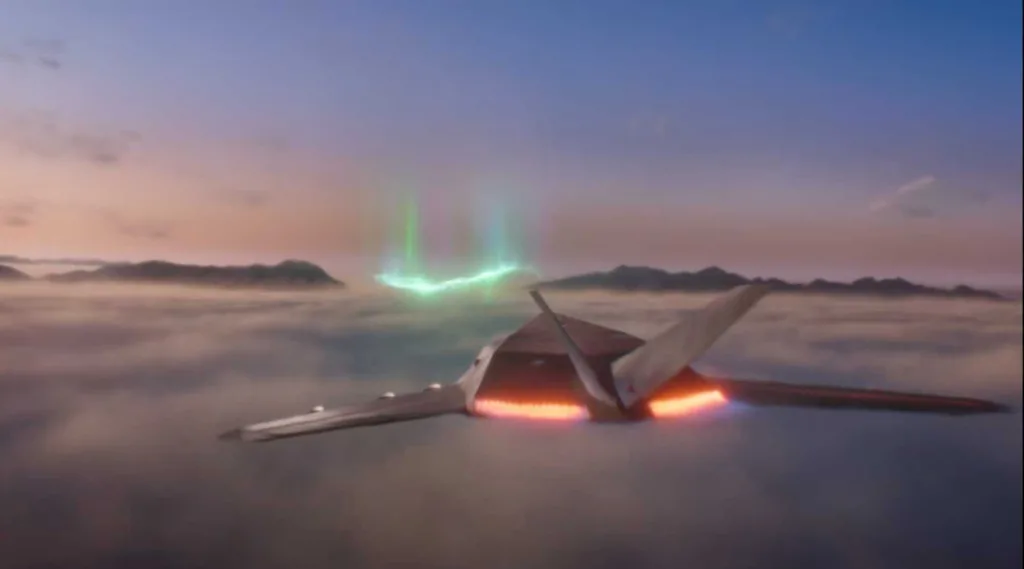
Next, Scott’s paper. Remember that paper that was so important Maya’s people kidnapped Scott for it? Yeah, we never get an answer on that. At all. We’ve covered James and Caroline. The pirate booty is also left behind to no applause. But maybe the worst betrayal is how poorly handled Eve and Levi are. Granted, the writer’s strike explains a lot of what’s lacking in this final season. Which is sad, because there were a lot of promising story lines that are forced to die on the vine.
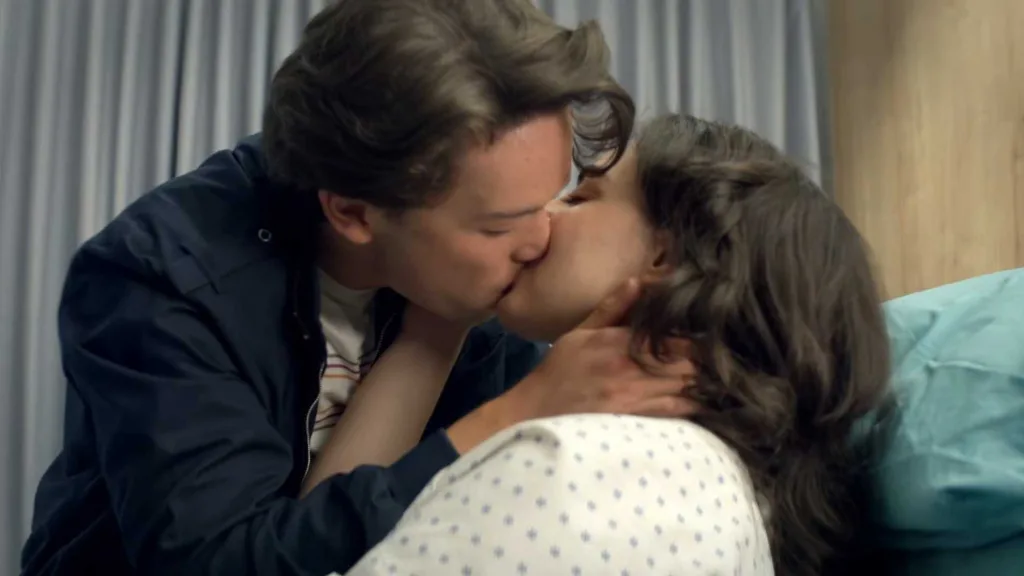
You know what can’t be blamed on the writer’s strike? All the happy endings. I’ve seen enough series finales to know they can go one of a few ways. You’ve got the mega happy ending, the middle of the road ending, and of course the frustratingly bad ending (or, debatable if you like). Lately, a lot of shows have been playing it safe. Don’t get be wrong, I love a good happy ending for some characters, but every character in an ensemble this big getting a happy ending??? It feels disingenuous. Riley should have died. Paara should have died. Eve should have died. Hell, even Helena if you didn’t want to kill off Eve. For fuck’s sake…Riley was torn apart by a raptor. A RAPTOR. Not only that but she was trapped in 1965 with inadequate medical care for who knows how long. Paara is even worse! She was trapped under debris and somehow no part of her body was punctured or lost circulation due to the pressure??? Also, also, wasn’t she missing for days? Shouldn’t she have starved to death!? As for Eve, uh, again, in a firefight with trained soldiers. One of them should have died or at least been critically wounded. Not to mention Veronica’s pregnancy scare (which I did briefly mention).
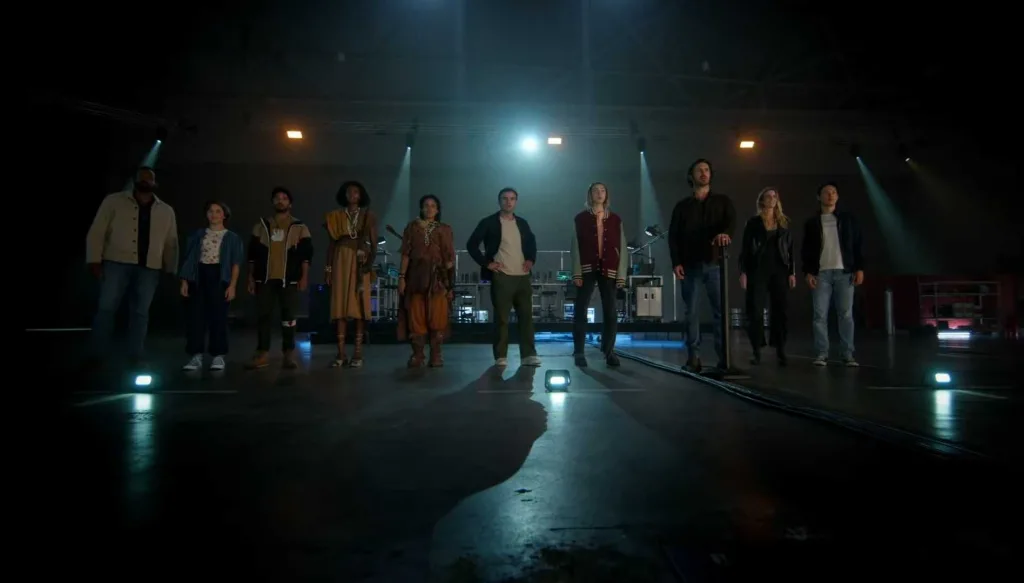
Still, overall, is it the worst series finale I’ve ever seen? No, that’s still Lost by far. But, it was a little too saccharine for my taste. I like a finale with more consequences, especially when the stakes are set this high. It’s too bad, though I’m sure there’s plenty of fans who are happy everyone made it out OK. Happy to know that living in 10K B.C. created lifelong relationships among a group of strangers who had the misfortune to fall into a giant sinkhole. Because, for all the sci-fi insanity, this really was a show about the characters, and on that front I will say it succeeded. It never forgot the real stars of the show, which is a win in my book.
It can be hard to keep doing good when all your efforts feel futile. And in Quantum Leap episode 211, “The Outsider,” Ben must convince former star journalist Connie Davis that she shouldn’t give up on hard-hitting stories because her last effort ended in disaster. At the same time, he must convince himself… his efforts to keep Hannah from becoming a widow in the future seem to have failed. She received his warning about her husband’s heart condition and got it treated in time, but now, said husband is doomed to die in a car crash. It’s almost as if the Fates (ahem, the writers) wants the guy to die… to make her available to Ben in the future? Whatever, I just can’t with this whole Hannah storyline, and mercifully, it’s merely a blip in this otherwise very excellent episode.
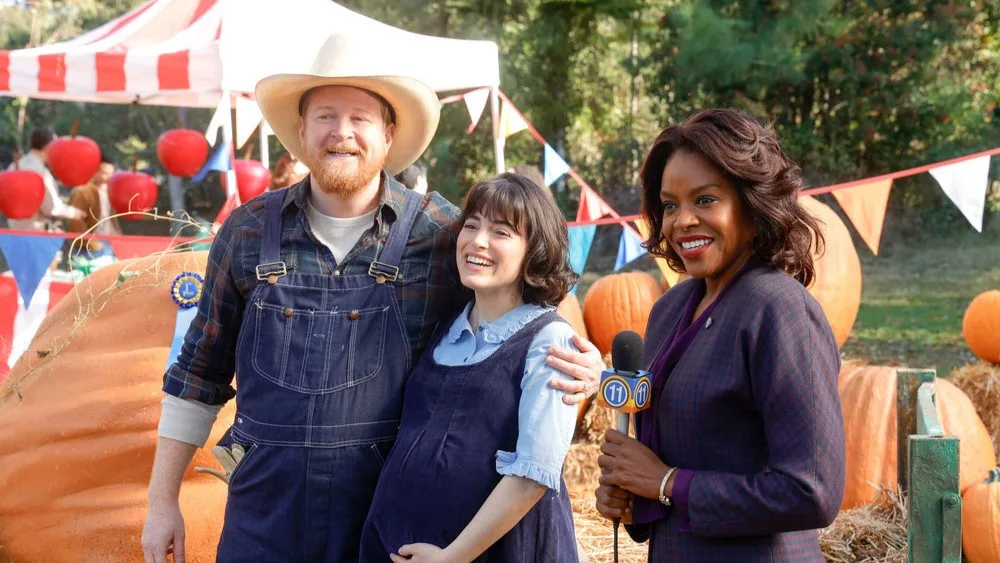
The leap kicks off with Ben in a phone booth, receiving an ominous warning that a lot of people are going to die. He soon discovers that he’s a young news producer in the 1980s, and that Connie, after her career-ending failure in New York, is now a local newswoman in Denver, covering silly stories like one about the largest pumpkin. And Connie is absolutely adamant about retaining her puff-piece persona; no more deep investigations or world-shattering truth bombs for her. She’s grateful to just have a job. Even after Addison helps Ben figure out that the mysterious tip was about a weedkiller that is about to go to market despite being a carcinogen, Connie is resistant. But eventually, her journalistic instincts kick in, and she and Ben set out to reveal the truth.
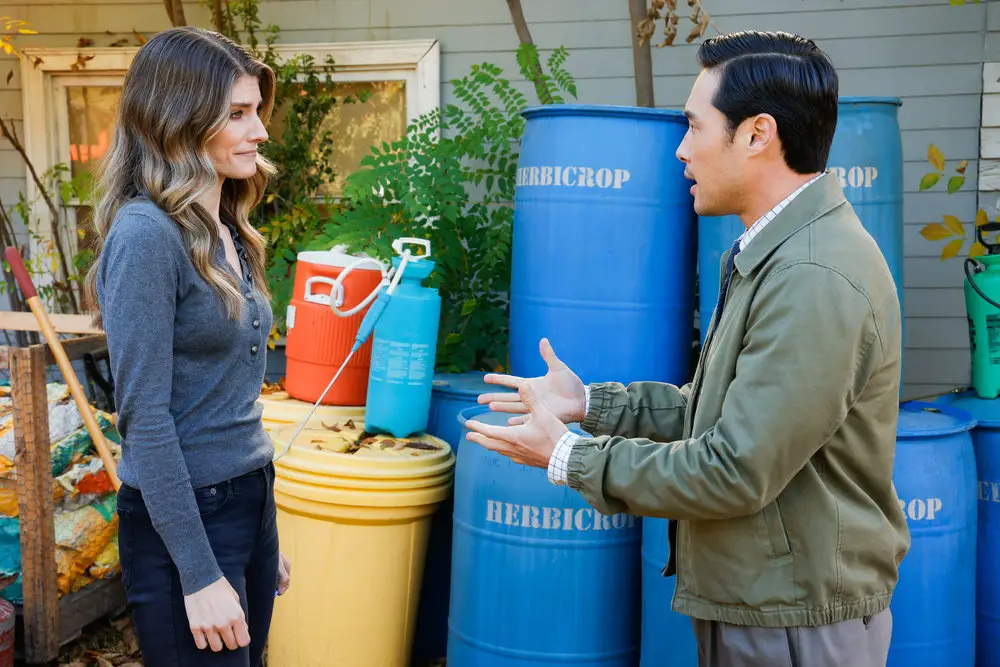
The episode has all the markers of a good journalism thriller: high stakes (thousands will die of cancer if this weedkiller is released!), mysterious sources (who’s the voice in the phone booth??), physical threats (a guy in a ski mask tells Ben to drop the story!), and enough twists and turns to keep you wondering how this one’s going to work out. Connie is a compelling and sympathetic subject for Ben’s leap; it’s easy to root for her, especially when she’s on her game, yet when she reveals why she’s been banished from the world of hard-hitting news, you can’t help but feel for her.
The leap by itself makes for a great watch. What makes the episode more impressive is that it balances the aforementioned thriller with drama back home at Quantum Leap HQ, without compromising either story line. The mysterious boss, whose quantum chip enabled Quantum Leap program to resume, has entered the room, and he wants his pound of flesh. Just who is Gideon Rydge, and how does he have the power to mess with the Quantum Leap program? I’m still trying to figure that out, but he’s giving me serious Elon Musk vibes: a smarmy, entitled jackass who thinks he’s above the government… because he kind of is. He’s got tech that the government wants, and therefore he has some sway.
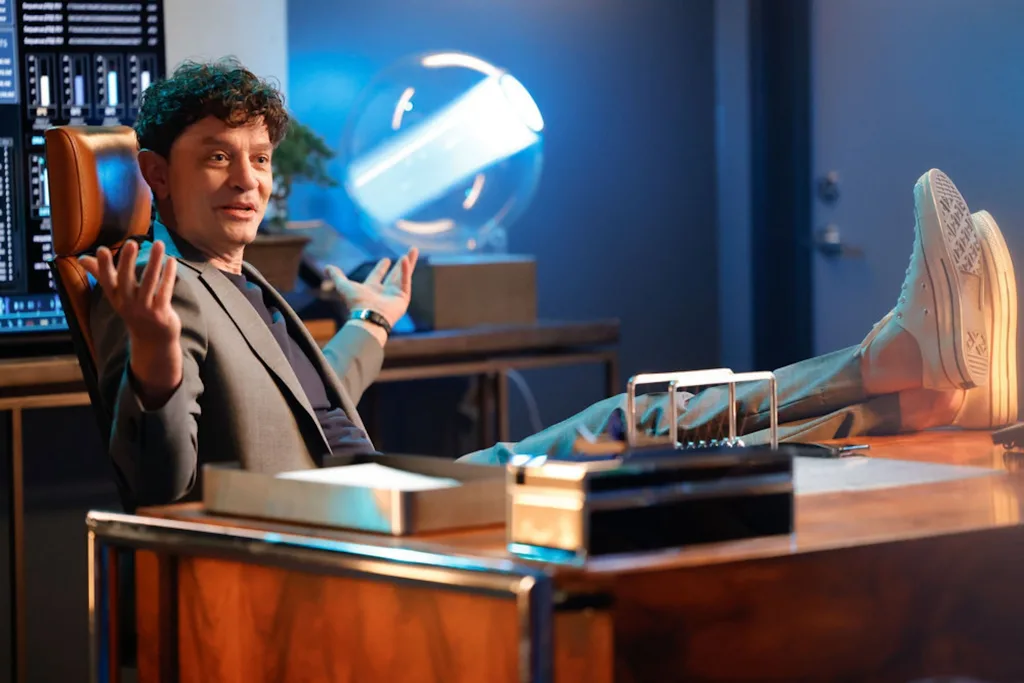
Ian, of course, is the reason Gideon is out for blood. Tom is left in the uncomfortable position of interrogating Ian about what they did and why, and Magic is left in the even more uncomfortable decision of figuring out what to do about it. Does he fire Ian, not only breaking everyone’s hearts, but also depriving the program of the one person who might be able to figure out how to bring Ben home? Does he offer up Jenn, who helped Ian with the whole chip thing, as a sacrificial lamb instead? That ain’t who Magic is though, and though I could immediately see where this was going, the ending still hit hard.
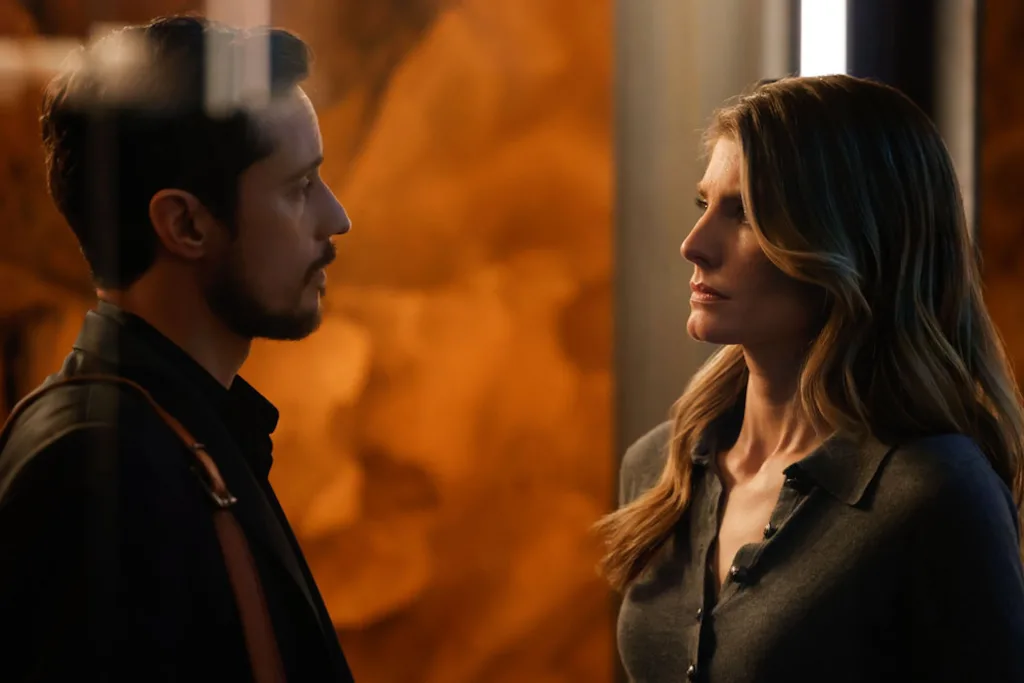
By the way, Tom is taking the whole break-up with Addison pretty well. Of course he’s got his issues with her, but so far, he hasn’t been vindictive, or whiny, or even cold, showing that he’s actually a good guy at heart. Which, thank goodness. I am so, so sick of the get-out-of-love-triangle-free card where writers reduce one love interest to an irredeemably evil cartoon villain who’d only been pretending to be nice all along. It’s hackneyed, it’s lazy, and it makes the heroine at the center of the love triangle look like a total buffoon (it’s also so, so overdone… the last TWO books I read used the same trope). That one love interest simply wasn’t the right fit, despite ticking all the boxes, allows for a lot more character depth on the part of both said love interest and the central heroine (in this case, Addison). Which is why I’m sincerely hoping that the writers leave well enough alone with this love triangle and don’t reveal next week that Tom is a mustache-twirling baddie who screams histrionics and tries to murder everyone. If they do, I’m throwing this whole season in the trash.
Anyway, kudos to the writers for giving us not one, but two compelling storylines this episode, and balancing them so well in 40 short minutes. This iteration of Quantum Leap has always felt like two shows smashed into one — a time-travel adventure and a contemporary sci-fi thriller — and while it has struggled with that unwieldy format in the past, this week proves that we can have our leap and eat it too. Wait, what?!
4.5 / 5 stars… The mere mention of Hannah was enough for me to dock half a star. Sorry, like I said, I just can’t with that storyline.
Cult classic comic, The God Machine, makes its return with Volume 2 via webcomics hub Global Comix!
It’s Valentine’s Day! As a gift to fans, Machina Corpse and Chandra Free invite those old and new into the intoxicatingly lush, dark, and mysterious world of teen Guy Salvator and the quirky Gods.
Following 2022’s successful relaunch of The God Machine with the Volume 1 re:VISION hardcover graphic novel, the spooky series returns with all-new weekly pages and behind-the-scenes bonus content via Global Comix and Patreon.
New readers will have the opportunity to catch up by reading Volume 1 starting February 15th with a FREE chapter update every Thursday until the debut of Volume 2 in March. Eager readers will also have the option to buy the physical edition of Volume 1 and its full digital PDF with bonus extras immediately.


Additionally, on March 19th, a charming 4-page recap comic, “Tea Party Theater at the Edge of Forever” will delight and prepare audiences for the new content.
The God Machine Creator and Machina Corpse co-founder, Chandra Free, is excited to bring her creation back via Global Comix. “I’ve been searching for a way to reach new readers while bringing new content to my existing fanbase,” she said. “Global Comix is an emerging leader in western styled webcomics with publishers like Valiant, Image, BOOM! Studios, and more coming to the platform. I felt The God Machine and my company, Machina Corpse, would be right at home here.”
“With my partner Stephen Emond’s satirical comic, Jon Died on a Monday,” she continued, “we got to test the Global Comix waters, and liked what we saw.” She concluded, “The God Machine started as a webcomic in the late 2000s, so it feels fitting and comfortable to tell these new stories in this format before we produce a physical edition down the line.”
The God Machine is a majestic weaving of loss, love, teen angst, Gods, and monsters, designed as a large, ongoing series that Machina Corpse is excited to bring to readers both new and old. “This story has been in my head for years if not decades,” Free said. “I finally feel like the time is right to move forward and build on the foundation I’ve set for these characters. I’m so excited to share all the twists and turns I have planned and to connect with readers online while it happens.”
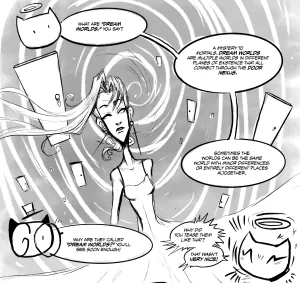
The God Machine “Time’s End” Volume 2 will update on Global Comix every Tuesday and Thursday morning starting March 21st with a traditionally styled black and white page with a guided view for mobile users at Global Comix: https://globalcomix.com/a/machina-corpse/comics
THE GOD MACHINE
Created by Chandra Free
Editorial/ Volume Two Lettering by Stephen Emond
For mature readers: [language, sexual situations, drug usage]
Sometimes, one of your favorite shows goes off the rails, but you keep watching anyway hoping it’ll find its way back. Well, I’m happy to report that this week, that was the case for Quantum Leap. Episode 210, “The Family Treasure,” is one of this season’s most fun episodes yet, full of adventure, mystery, thrills, and, of course, the show’s signature heart.
This time, Ben leaps into the (mercifully Hannah-free) life of Nadia, a 17-year-old Lebanese American girl in the 1950s. Ben and Nadia’s two older siblings (an eldest sister and a middle sibling who is obviously trans masc, yet whose identity / pronouns aren’t clarified till nearly the end) receive items from their recently deceased father, presented by the father’s lawyer and personal friend. The father was obsessed with discovering an ancient hidden treasure, to the extent of ignoring his family, and it doesn’t take long for the siblings to discover that each item contains a piece of a map.
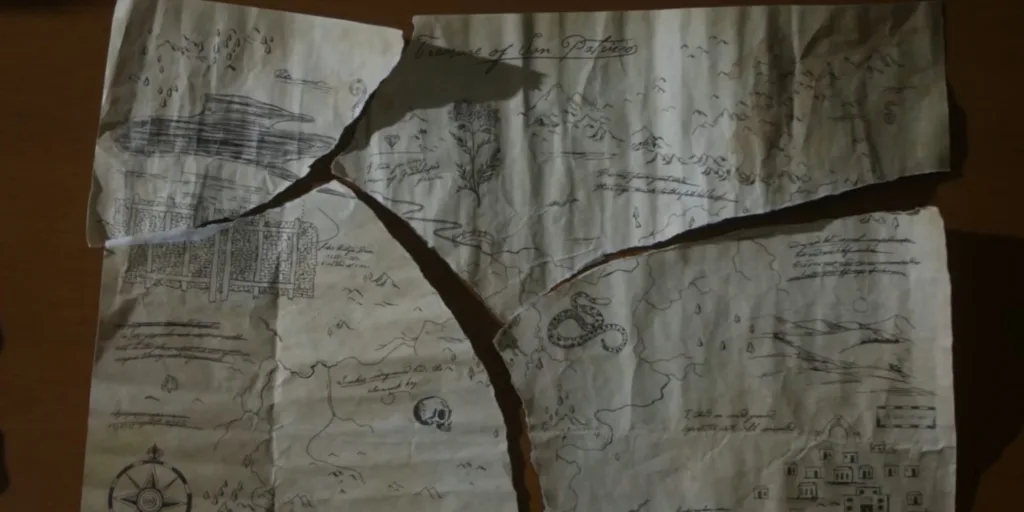
In the original timeline, the middle sibling, Dean, went off alone to find the treasure and never made it back. So Ben insists that he and the eldest sister, Sarah, go with them and make it a family affair. Sarah is reluctant at first; she and Dean are polar opposites in many ways, and the two can’t stop bickering. In many ways, it’s a classic rivalry: The traditional “good girl” versus the rebellious non-conforming sibling.
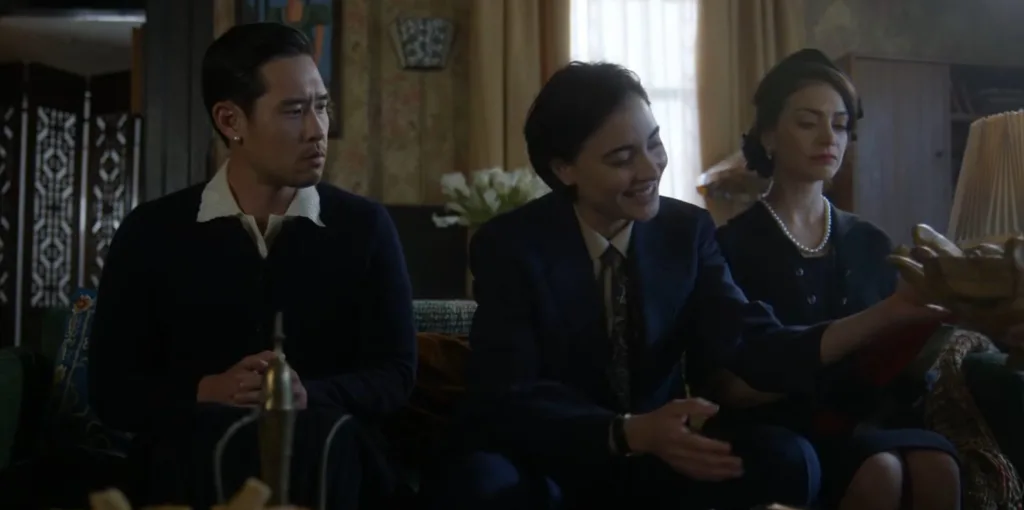
But eventually the three wind up in Mexico, following their dad’s map. What follows is a classic treasure-hunt story, complete with enigmatic text clues, dark tunnels, and nefarious villains. The plot is a bit compressed given the show’s runtime (and need to make room for its signature conversations about the characters’ feelings), but remains entertaining despite feeling rushed. And one can’t help but feel warm and fuzzy about the sibling reconciliation that’s Ben’s true purpose in this leap.
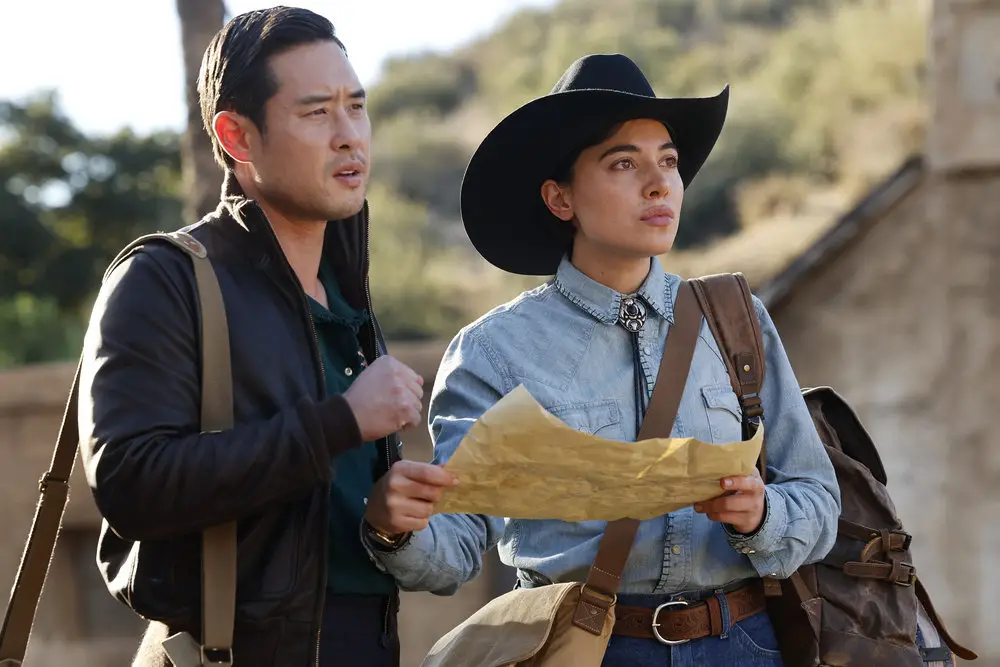
While the show’s commitment to diversity and inclusion is admirable — hooray for women of color and trans folks in 1950s America! — the execution can be a bit ham-fisted. In this case, using Dean to explain what “non-binary” means feels a bit too didactic and does a disservice to the character. For a few moments, they’re no longer a person, but a walking, talking dictionary definition meant to educate the audience. Perhaps that’s necessary, considering Quantum Leap still airs on network TV and older viewers might need the clarification. Still, I feel like there must have been a smoother way to showcase Dean’s identity without having them literally explain it. The show did a much better job of bringing up trans issues in last season’s “Let Them Play.”
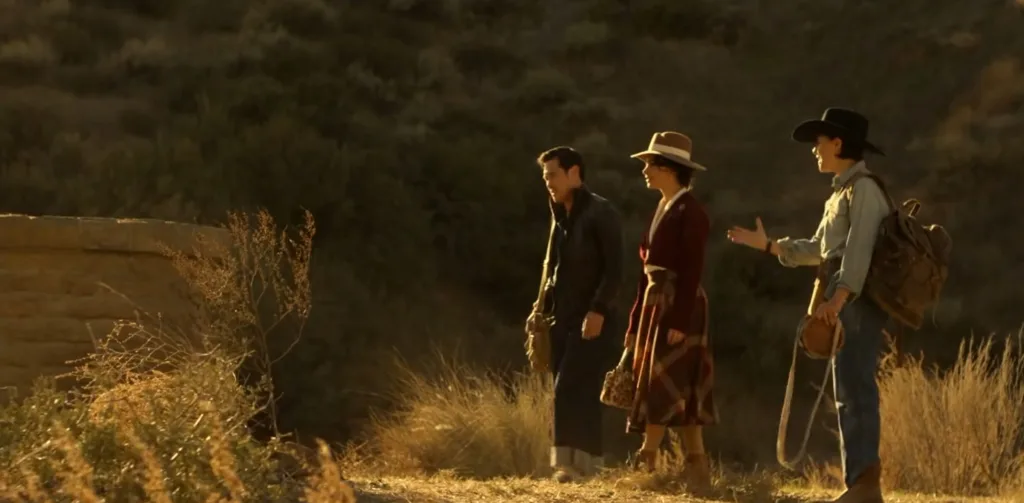
Anyway, all in all, it felt good to see Quantum Leap return to the kind of fun yet heartfelt adventure that made me love the show in the first place, where the focus is on the mission of putting right what once went wrong.
Meanwhile, back at HQ, some bombshells get dropped. First, Addison and Tom are getting married, much to the team’s surprise (though they’re plenty polite about congratulating her). And second, Rachel’s mysterious boss, the person pulling the strings of Quantum Leap after providing a vital component to restart the program, finally shows up.
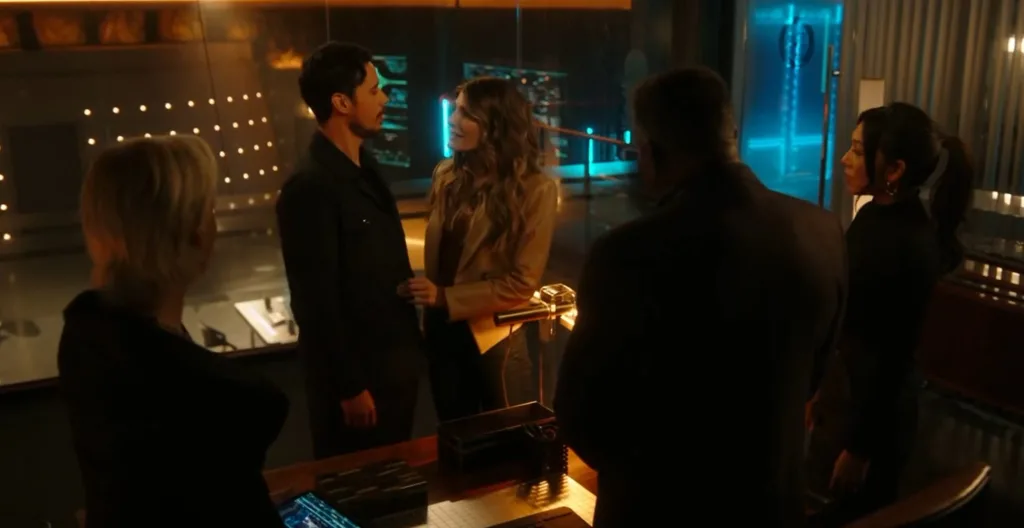
I must admit to being less than invested in the sci-fi thriller-ish contemporary storyline. Not only because it’s been so fragmented, it’s hard to keep track of, but because the stakes aren’t entirely clear. Okay, so Ian made a deal with the devil, if you will, to get Quantum Leap back, and that devil is now getting data from the accelerator. So…? The fact of the threat is often reiterated, but the why of it is muddy.
Season 1 had the advantage of having an obvious mystery in need of resolving: Why did Ben leap? Season 2 is a lot murkier, and so the whole thing with Rachel’s boss feels more like a distraction than a story arc. But we’ve still got some episodes to go, so maybe it’ll all come together in the end.
The very concept of this current iteration of Quantum Leap came with a host of writing challenges. It tries to have things both ways: The episodic structure of the original, and the season-arc structure that’s currently in vogue in sci-fi/fantasy television. Basically, two shows smashed into one. The results are mixed, but this week’s episode shows that it can be done. We get our (albeit rushed) adventure in the past, and we get our (albeit vague) contemporary thriller. Not bad for 40 minutes of screen time.
Here’s hoping they can keep up the balance in the coming weeks.
4.5/5 stars
The groundwork gets laid for things to take off later, so let’s get caught up. Gavin’s not sure giving the chip to the mystery person who has Eve is a good idea. Izzy is worried she’s missing her chance to bond with Leyla when she turns down a date. Paara’s still missing, making Ty worried. And, Lucas has come to suspect there’s a traitor amongst them.
We get three suspects. One we already know is Maya – the obvious choice. Another is Ruth, who reacts poorly when Veronica finds a radio to the air base stashed in the council’s hut. Finally, Leyla, who is acting very shady when it comes to getting Izzy alone in the woods.
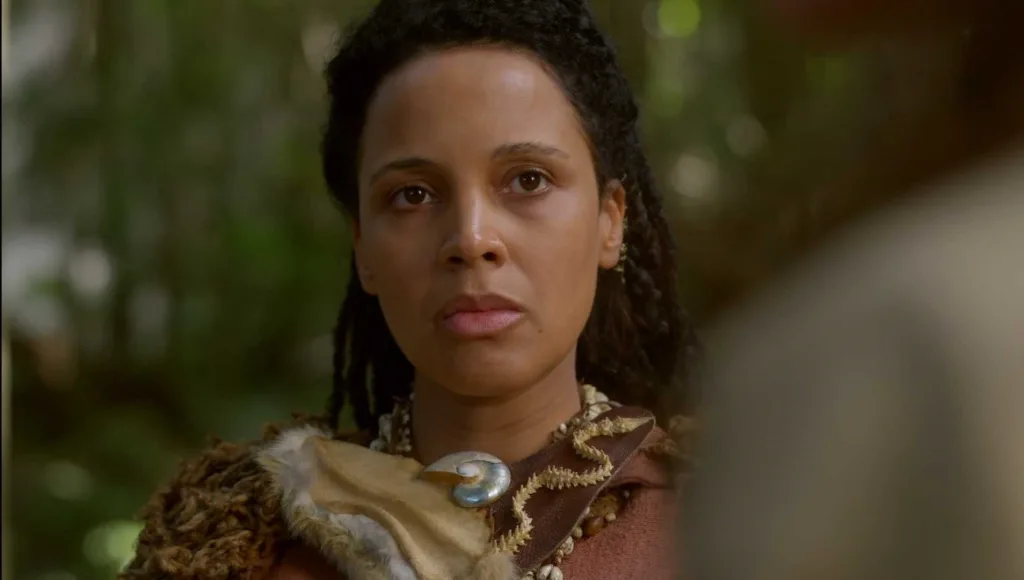
Maya is quickly sussed; Gavin sets up a little trap for her which she walks right into. Unfortunately, team 10k B.C. forgets that Maya has future tech, and her watch serves as a tracking device. Her people show up and rescue her, but before they can kill Gavin, Sam, or Ty, Helena shows up and takes out the armed men, sniper style. Helena then fills them in on Maya, who is the head of a private security firm contracted to create the fighter jet time machines. It’s why she wants that chip. In the chaos, Maya gets away via jeep. They all make their way towards the base.
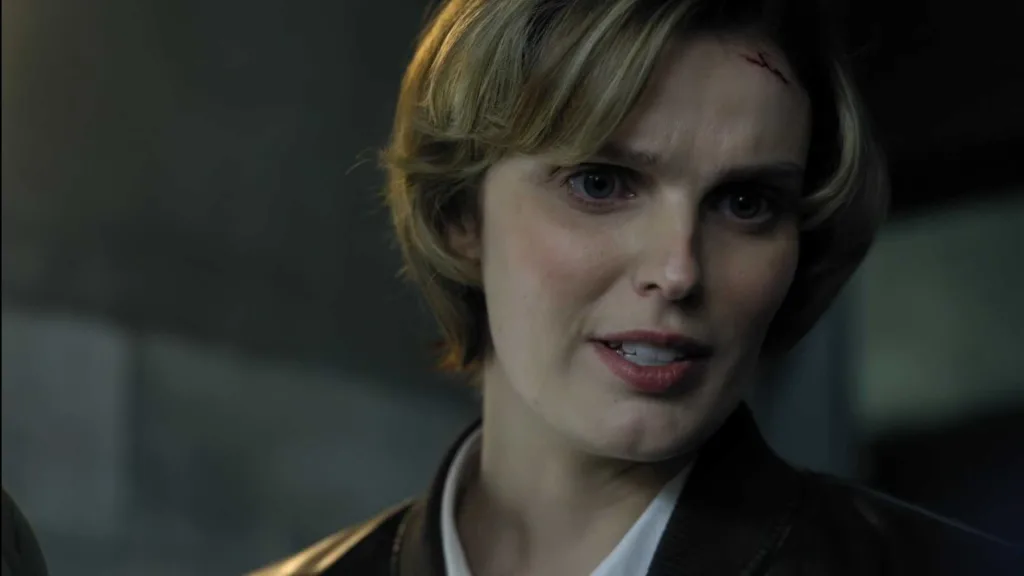
Over at said base, we see Scott get put in a cell across from none other than Levi! Because it’s Levi, there has to be more to the story, and there is. Remember his tattoo? Levi joined up with Maya’s private security firm in order to get back to 10k B.C. so he could kill James. But he assures Scott he’s on team 10k’s side, all the way. Scott is, understandably, skeptical, but still plays along with the “fake” interrogation where Levi suggests Scott should be moved to a more secure location. The ploy works, and Maya approves having the prisoner transferred.
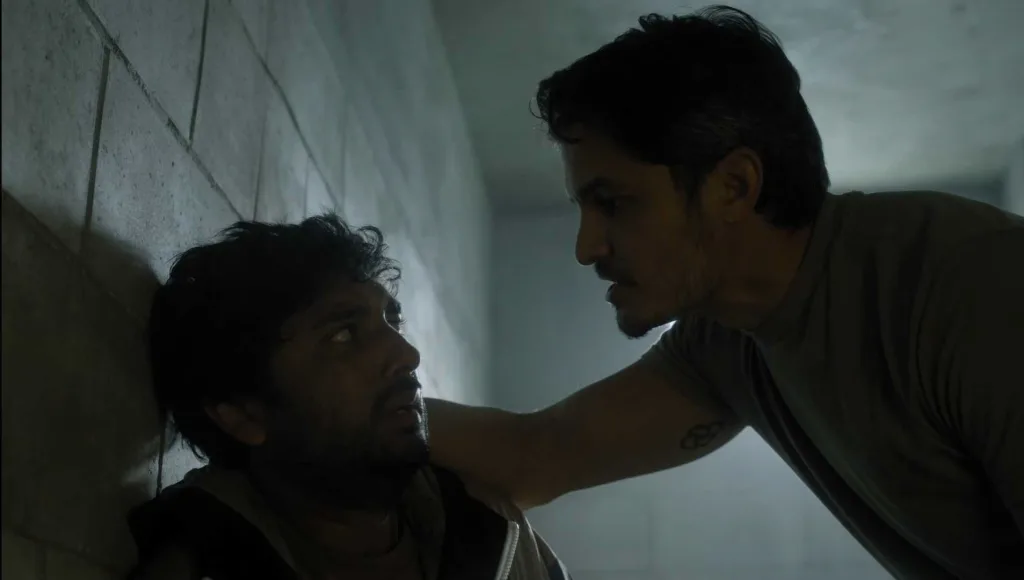
Traveling by river proves nearly fatal when Gavin and the gang’s raft is attacked by a giant alligator. While it gives them all a great story to tell one day, it also gives Gavin an opportunity to try and patch things up with Helena. See, before Gavin lost his memories, he and Helena had a plan to book it to Mexico after stealing the chip. Gavin backed out and his sis was left to run on her own.
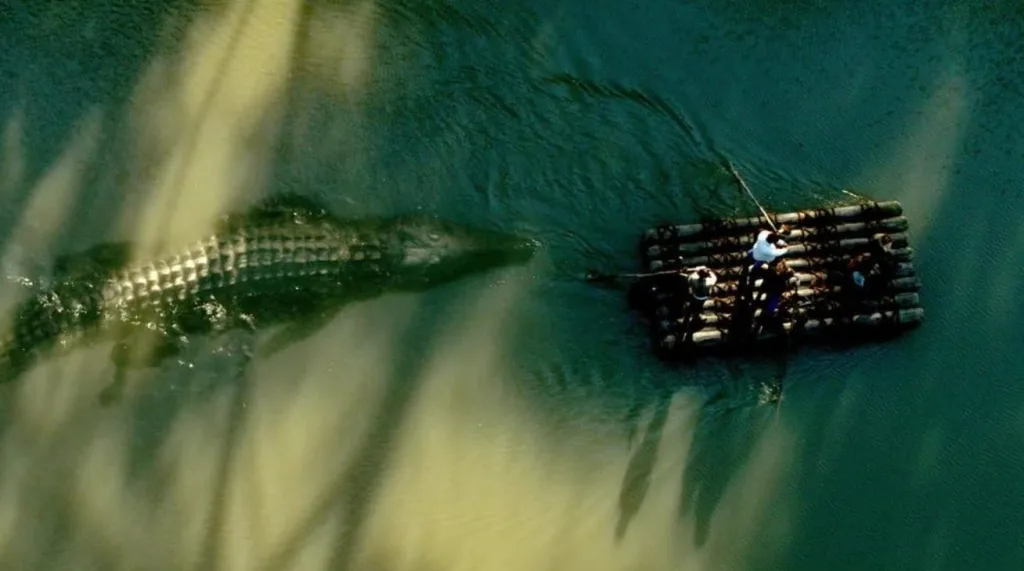
Speaking of plans to escape life… Leyla wants Izzy to go away with her, to 2021! That’s right, Leyla lures Izzy out into the woods and lies to her about helping track down her dad, just to reveal that she sold out the fort for a chance to use a double aurora and leave 10k B.C.. Well, that explains Ruth’s sus behavior. Izzy isn’t thrilled, but when confronted by Veronica, Ruth, and Lucas, Leyla does the right thing and helps unlock the radio so the group can spy on the base for a change. Good timing, too, as they hear about Gavin’s party being in trouble.
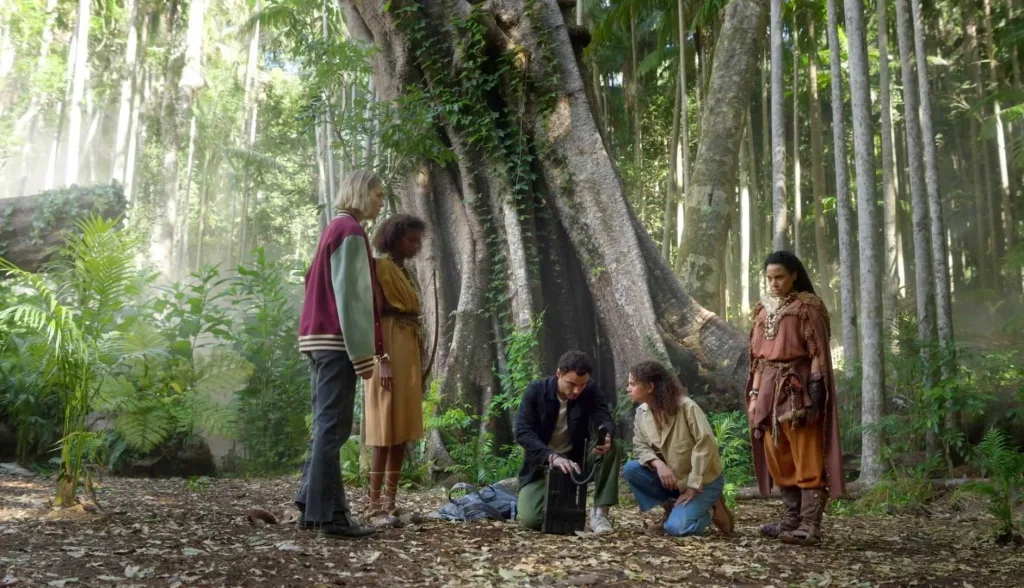
Levi’s plan to get Scott moved was twofold. He’d heard from the other soldiers that Eve is being held at the same place, so he wanted to get Scott moved so he could see where it was and they could rescue Eve. Sadly, the plan goes tits up when Izzy appears on the scene, and Levi has to break cover to keep her from getting killed. Lucas joins the fight soon after, and Levi breaks off to help Gavin’s group. Izzy gets her shot to play hero after Levi, Helena, and Sam take out most of the enemies, leaving one for her to shoot with an arrow. Her morale boost is quickly lost when she discovers her prey got a single shot off and hit Levi in the gut. When Sam rushes over to put pressure on the wound you can see on his face the prognosis is, well, terminal.
Levi reveals to Gavin that Eve is nearby. Izzy says goodbye to her uncle, as her father forgives him for his transgressions. Levi dies, left unburied because time will not allow it. Scott managed to get the coordinates of the detention center’s location and they gotta go. But the location just has a double aurora waiting for them. Helena explains Maya’s main facility is in 1965, she must have Eve there. Since Josh and Riley are also there it tracks that Gavin, Sam, Izzy, and Helena all go through the aurora.
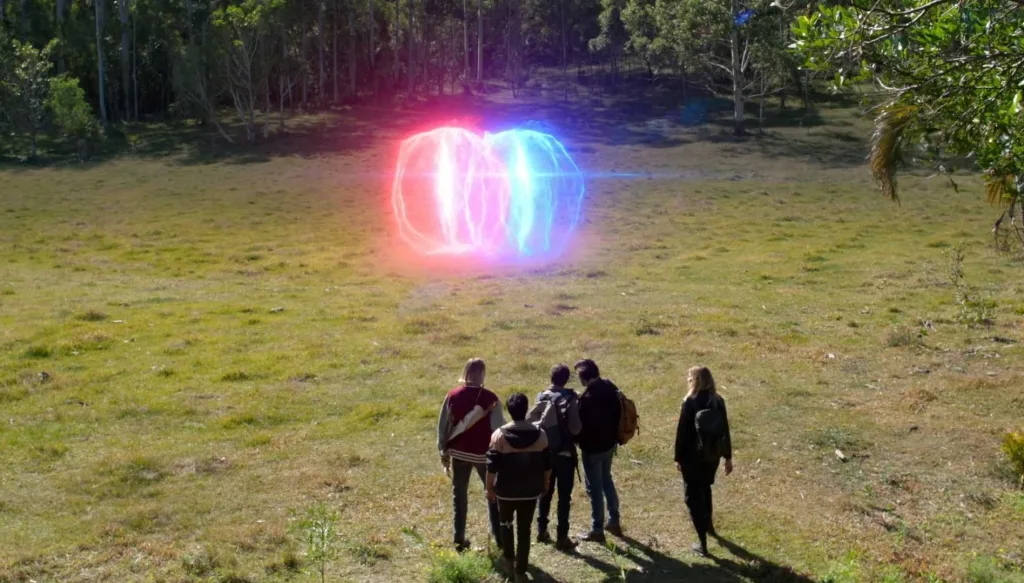
Man, we’re in the shit now, kids. Important players are dying, traitors are coming out into the open, and time travel might be a thing of the past (yeah, I said it).
Overall, a fantastic penultimate episode. Levi’s death was tragic but not entirely unexpected. First off, he committed a cardinal sin. Second, his wife and kid are dead. Third, let’s all be honest, we know he was still in love with Eve. Boy had to go, and what better way than as a hero for the cause? I’m sad to see him go, and I’m pretty sure that shot was to the chest, but either way it would have been fatal. Having him absent for the majority of this truncated season sucked, but it also made losing him a lot easier. Levi’s arc was complicated; hell, he was the reason the group lost their quick fix to getting out of 10k B.C. I get why he had to pay such a high price, but still…
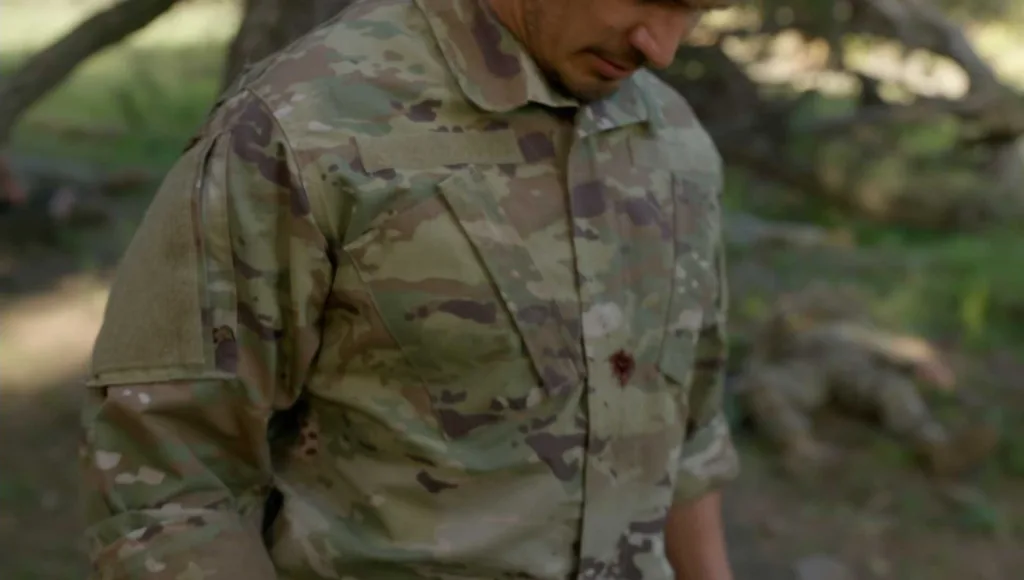
The traitor angle was fun. At first, I was on board when Ruth being guilty because Paara is still MIA. Did Ruth kill her to take control? It would make sense. It’s a great motive, but sadly, no. My guess is Paara was taken by Maya’s people for… reasons? I’ll be honest, when Izzy heard the flies buzzing in the woods with Leyla I really thought we were gonna find Paara’s body. However, when it turned out to be the soldiers and Leyla wasn’t too surprised, well that’s not natural.
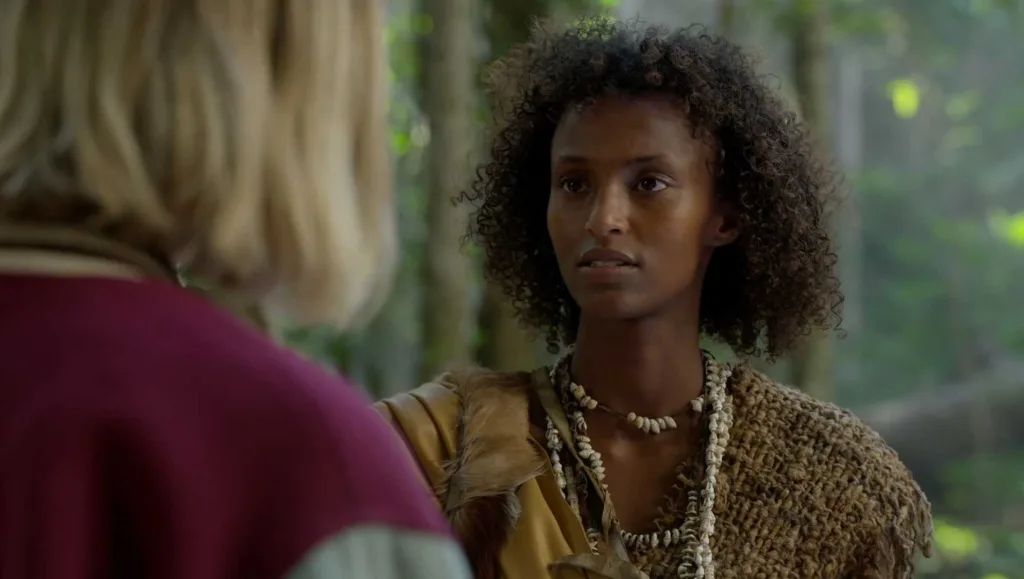
Leyla was a good traitor. She had her mother’s access to the council tent. Most everyone ignored her (or must have for her to be able to do this for as long as she did). But the weird thing is, the way Leyla makes it sound, Maya promised her an escape for her and Izzy to live happily ever after in exchange for information. Problem is, Levi and Petra get kidnapped in the first episode, before Izzy and Leyla meet. Yeah, they meet in the second episode, and by the third episode Maya appears, but still… was Leyla always planning on bouncing and just decided to add Izzy to her plans after they met? Suppose it’s not the worst plot hole. Seems a little forced just so Ruth isn’t the obvious solution, a little red herring for funsies!

How will everything come together? What’s up with Scott’s paper and why is it so important? My only guess there might be that the plants’ regenerative powers prevent the human body from falling apart when it travels through time? Who exactly invented time travel in this entire show? We’ve got Gavin’s mom and dad, who we were told created the science behind it, then it was a secret government project that James built off of, and now it’s Maya? Not loving the changing stories, folks. Also, will everyone in 10k B.C. be able to get back home? And, if they can, will they all choose to? Do the auroras just not cause sinkholes anymore? Finally, will we see Eve for real? OK, finally, finally, is anyone else gonna die? Paara… I’m looking at you…
After being disappointed by “Maya”, La Brea has more than made up for it with Tuesday’s adventure: “Fire Storm.”
We begin in 2021 with Gavin getting kidnapped at gunpoint by a mystery woman. Ty and Sam are once again on the hunt for Gavin.
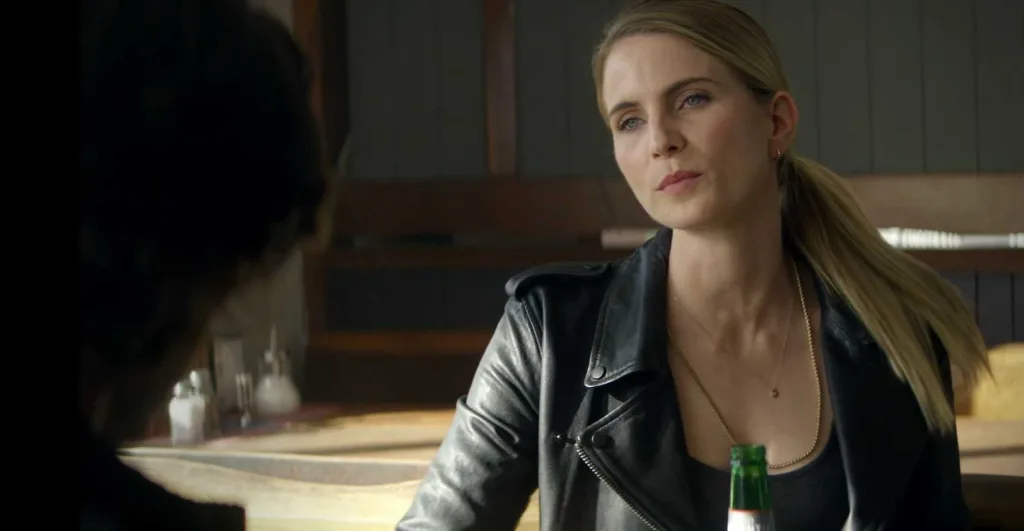
Back in 10k B.C. Sam’s suspicions about their unnamed contact is proven correct when the person produces a picture that appears to be Eve tied to a chair. Gavin’s gotta find that chip or Eve is toast. Maya tries to get him to think about where it is, but the absentminded pilot is convinced he hid it in 2021. Sam’s got a solid idea – send a message to 2021 via the tar pits. Turns out, Scott knows people who can get it to his 2021 self, though he’s not sure how helpful that him will be.
In other bad news there’s a huge fire headed their way forcing the fort to evacuate ASAP. Luckily, Lucas and Veronica make amends allowing her to lean on him in this hard time. So, while Sam, Lucas, and Veronica help lead the people to higher ground, Izzy, Scott, Maya, and Gavin head for the tar pits. This gives Scott a chance to ask a stupid question (I know your well-meaning teachers told you there’s no such thing, but there totally is). Why oh why would a time travel project want an anthropologist around? Really!?! I mean, Bones made an entire show of an anthropologist solving murders in modern times. You really think a person with extensive knowledge of the PAST wouldn’t be helpful in dealing with a TIME TRAVEL project!? Scott’s low-self-worth aside, they succeed in sending the message.
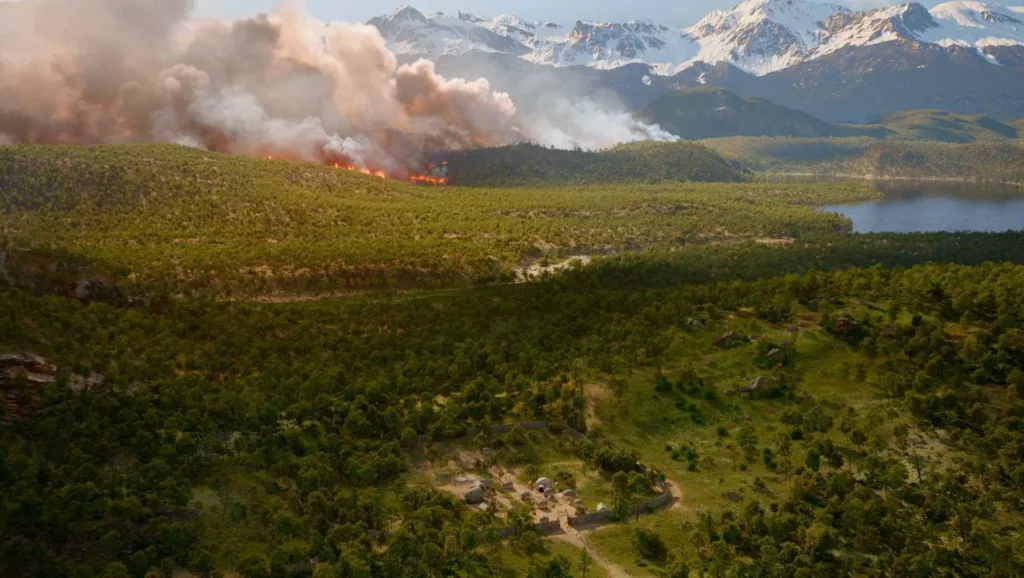
Before heading off to 2021 we also see Lucas pick up a stray wolf pup much to Sam’s protest. Meanwhile, 2021’s Sam’s got a cop friend searching for the car Gavin was taken in. In a brief moment of downtime Ty and Sam bond a bit until Scott calls Gavin’s phone (which Ty happened to find left behind). Why does Scott’s number come up as if he’s a contact in Gavin’s phone? What does the “Maybe” before it mean? We’ll get back to that.
Ty and Sam try to talk to Scott and he seems vaguely open to listening, to the point he lets them into his home, but he’s not totally convinced. Ty is determined to win him over…with food!
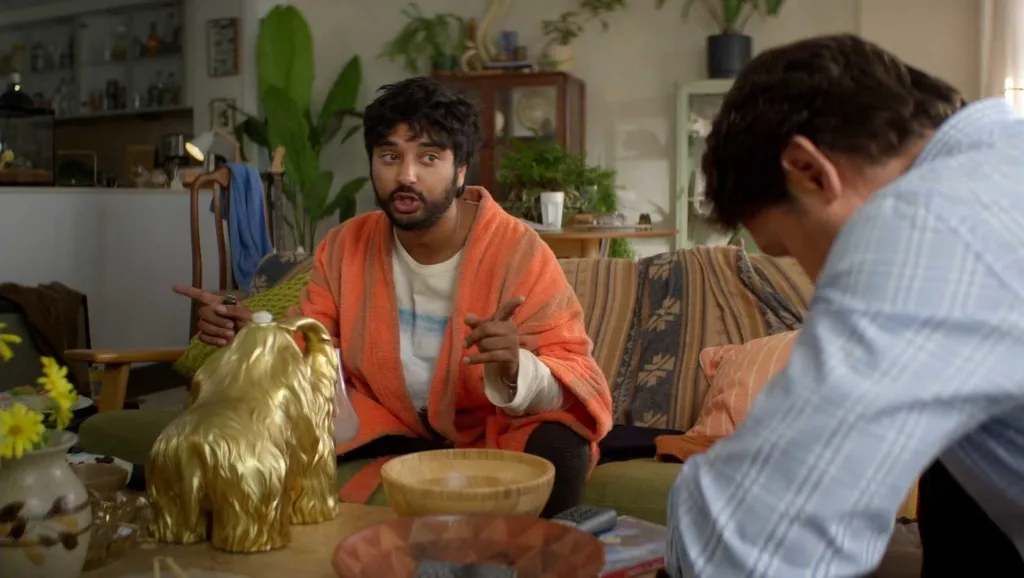
Over in 10k B.C. Lucas and Sam bond a bit when it’s clear the fire is bothering Sam a lot. Thing is, Sam’s faced fire before and had to scramble to get his family to safety. It left him shaken. Unfortunately, returning to the group reveals that Ruth’s scouts are sure the fire will reach the fort. Fortunately, there is a river nearby and if they open the damn the water will flood the area putting the fire out. Unfortunately, it’s in the direction of the fire, so naturally Sam, Lucas, and Veronica volunteer.
The smoke is making things bad for Gavin’s lungs and he and Izzy take a break while Scott and Maya go off to get water-soaked clothes (fire tip, it helps against smoke inhalation!). Gavin has a flashback showing him a paper written by Scott.
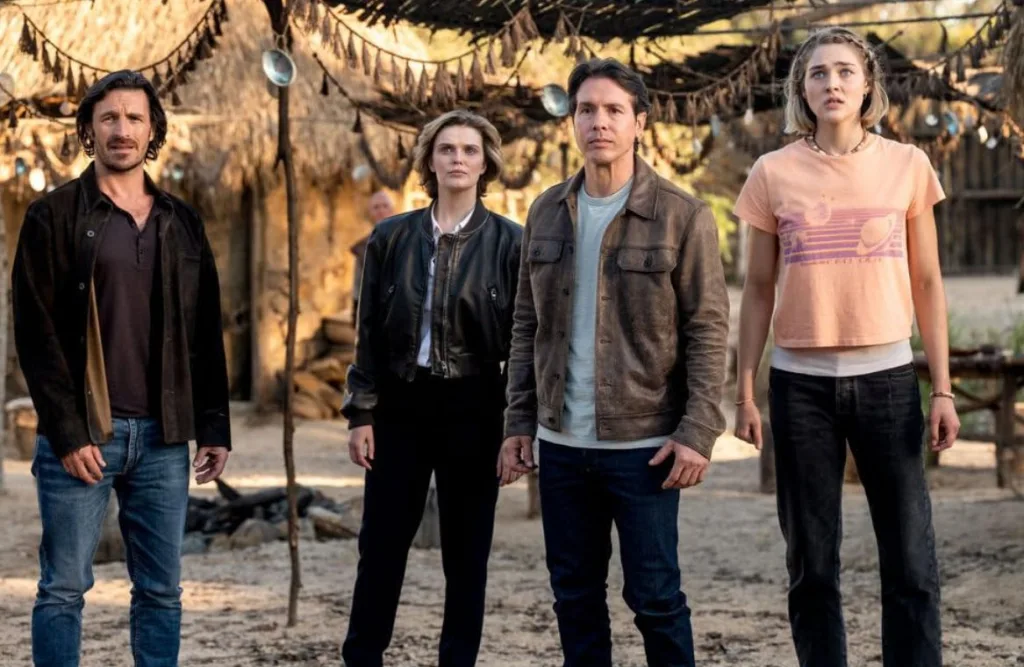
2021 Gavin is getting some cryptic answers of his own. The lady is named Helena, and I love how Gavin points out her telling him her name explains NOTHING. Alright, how about she was civilian consultant to the military and is the reason he was one of the pilots selected for the time travel program? Or, that they were working together to stop the military from creating jet fighter time machines? Gavin’s skeptical, but Helena says she’s got receipts!
In 10k B.C. Gavin questions Scott about the paper. Our former pot head is confused as A: he never published it and B: what would a paper about the regenerative properties of prehistoric plants have to do with time travel (again, SERIOUSLY!?!)? Scott asks who showed him the paper and all Gavin can say is the person has three scars on their arm. The fire is closing in though, prompting Gavin and Izzy to head off while Scott goes back to get Maya.
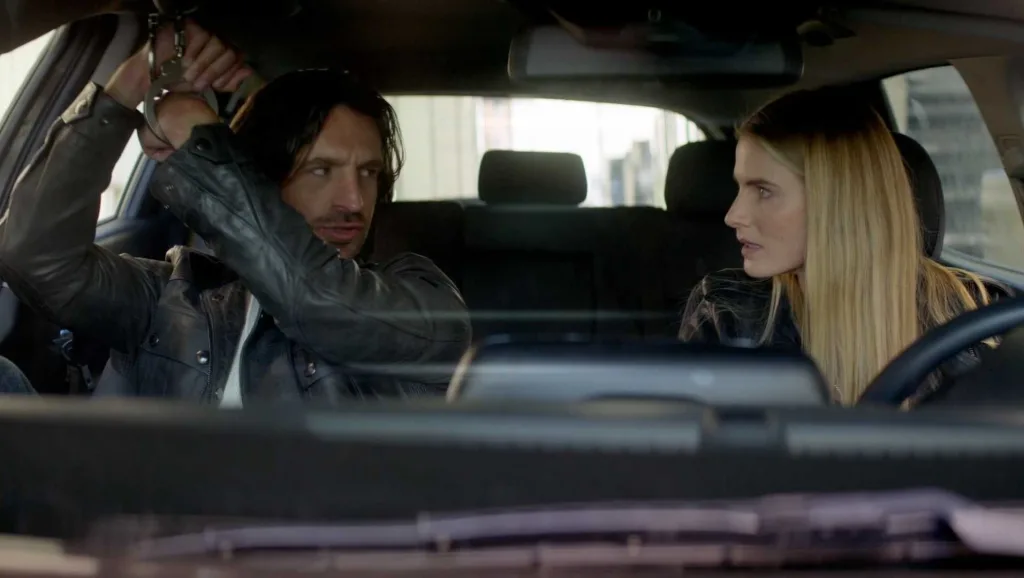
Some millennia later in 2021 Helena makes good on her promise using her thumbprint and Gavin’s to open a safety deposit box wherein lies the stolen microchip (which is HUGE btw).
The damn destroyers of 10k B.C. reach their destination but instead of being able to use the damn the easy way, they’re gonna have to blast it, thanks Veronica! Sam says it’s doable but when the dog runs off into fire territory he runs off after it. This leads Lucas to abandon damn too, leaving Veronica and Ruth to make a bomb.
2021 Ty and Sam are still making progress with Scott. Ty butters him up using insider knowledge comfort food and his shrink powers. Our dear Mary Sue is suffering from a wicked case of heartbreak. Conveniently, Sam and Ty are both excellent pep-talk givers and Scott shows them the note. Not soon after, Sam’s LAPD contact calls about that BOLO.
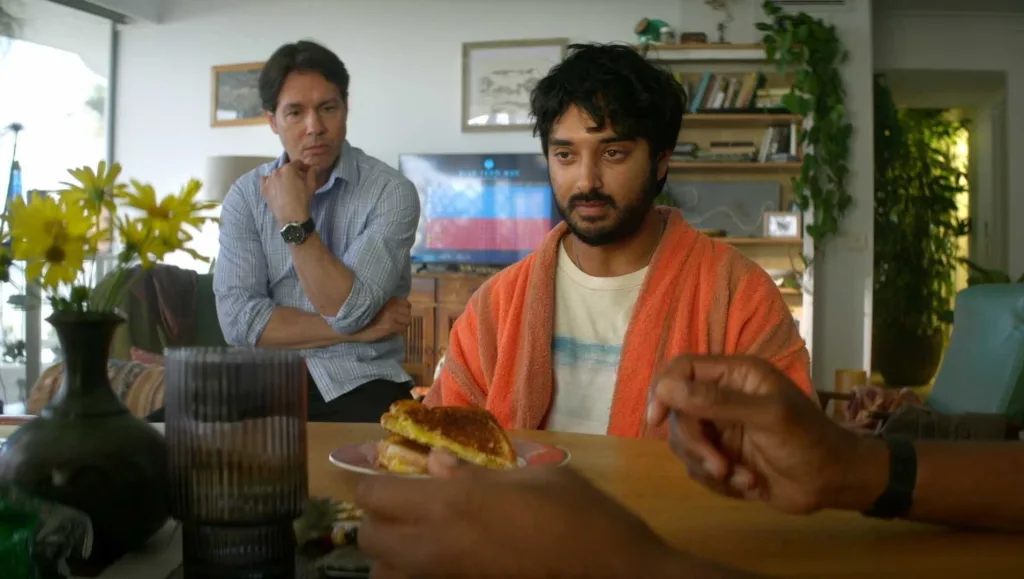
Speaking of…Helena has taken Gavin to a lake where she confesses, she’s his half-sister. Their father was a d-bag obsessed with time travel. He used the government’s science to build his own time travel experiment, hence the sinkholes. It’s why Gavin and Helena teamed up to stop him, and Gavin gets on board.
10k B.C. Sam searches the fire and smoke for the dog, successfully finding the little pup. Lucas wonders why it was so important and Sam recounts when that fire happened the family dog was killed. What’s worse is Riley made him feel bad about it. This second chance has a kind of happy ending, he finds the dog, but there is no way out of the burning woods. Thankfully, Veronica’s third time is a charm as she triggers the explosion releasing the life-saving water. Ruth gives her a “good work”.
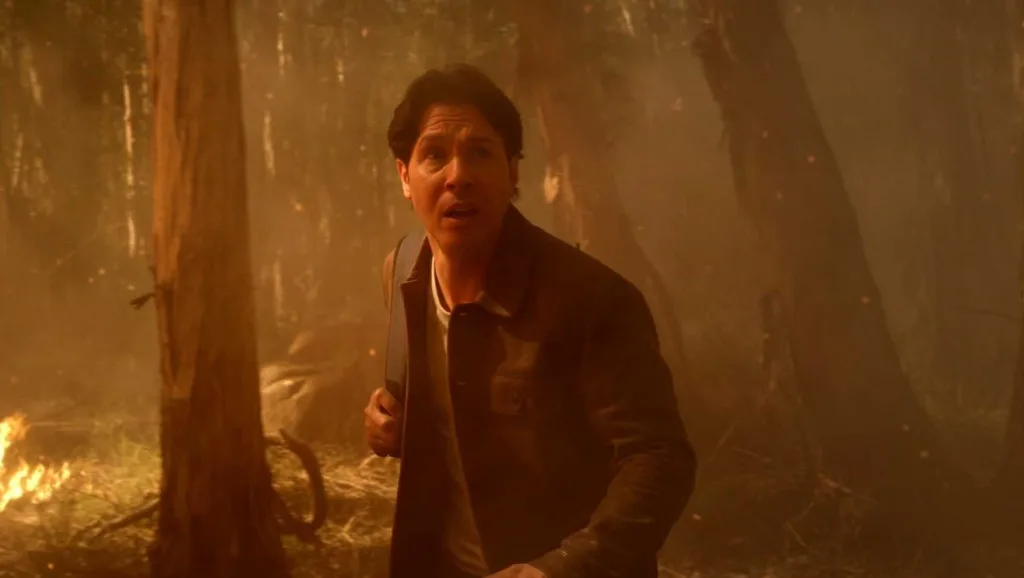
Over in 2021 Helena takes Gavin to a double aurora. Blue leads to 10k B.C.; Red leads to 1965. Helena says they need to take the chip to 1965 to stop the time travel shit at the source. Of course, Sam and Ty show up at that moment to plead with Gavin for the chip. Sam pulls out his SEAL moves once Helena ups the ante with her gun, but Ty successfully acquires the chip.
Things wrap up in 10k B.C. with Scott realizing Maya is evil, Maya getting the drop on Scott (oh, Scott…you make it too easy!), Lucas and Sam surviving the fire thanks to the water, and everyone returning to the fort in celebration. Even Ty returns with microchip in hand. It’s great! Except for…you know, Maya being evil.
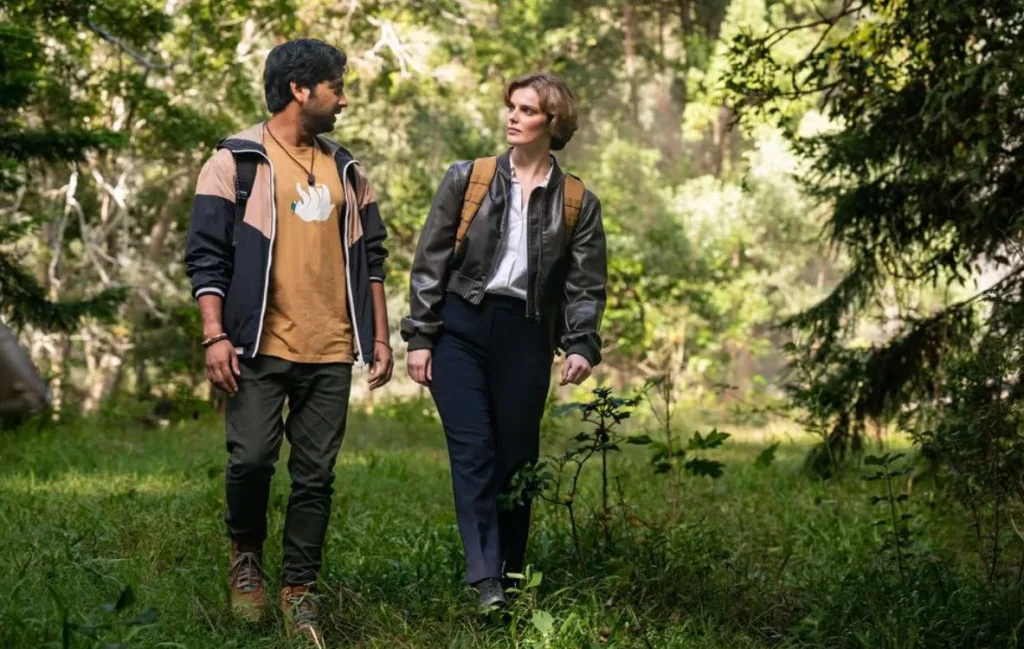
Whew! What a jam-packed episode! A solid final season entry if ever I did see one. There was character development, more explanations of the mythology, and stakes raised!
I had lamented that Scott seemed like a waste and sadly I can’t retract my statement. I mean, this kid is smart. He’s smart enough to be suspicious when Sam and Ty show up claiming to be Gavin’s friends. He even does the classic movie nerd time travel movie evaluation of the situation. That being said, he can’t wrap his head around why a time travel project might benefit from having an anthropologist on the pay role!? Like, come on man, you clearly weren’t born yesterday. You really have ZERO idea why the gov or even a villain of the show like James might need to know which old timey plants could, I dunno…cure cancer, heal terrible injuries, or say, create a fucking super soldier???
And, if that wasn’t bad enough (he asks this question TWICE!), when he realizes Maya is evil, he just straight tells her! Seriously dude??? Aren’t you the one who watches all the movies??? In Scott’s defense, he’s been an idiot before. Remember all that shit with Lucas, and then Taamet? Kid’s got a serious blind spot for real world danger that frankly doesn’t jive with the character they’ve made him out to be so far.
I do appreciate how they finally introduced Gavin’s sister, and through her we get an explanation about his father’s place in all this. Does leave Caroline out in the cold. Also, if they destroy the initial program would it really stop James? Maybe not, but we’re in the endgame now, any loose threads will have to stand. I’m still wondering what’s the explanation for why Scott’s number was seemingly in Gavin’s phone – was it because of Maya? Helena?
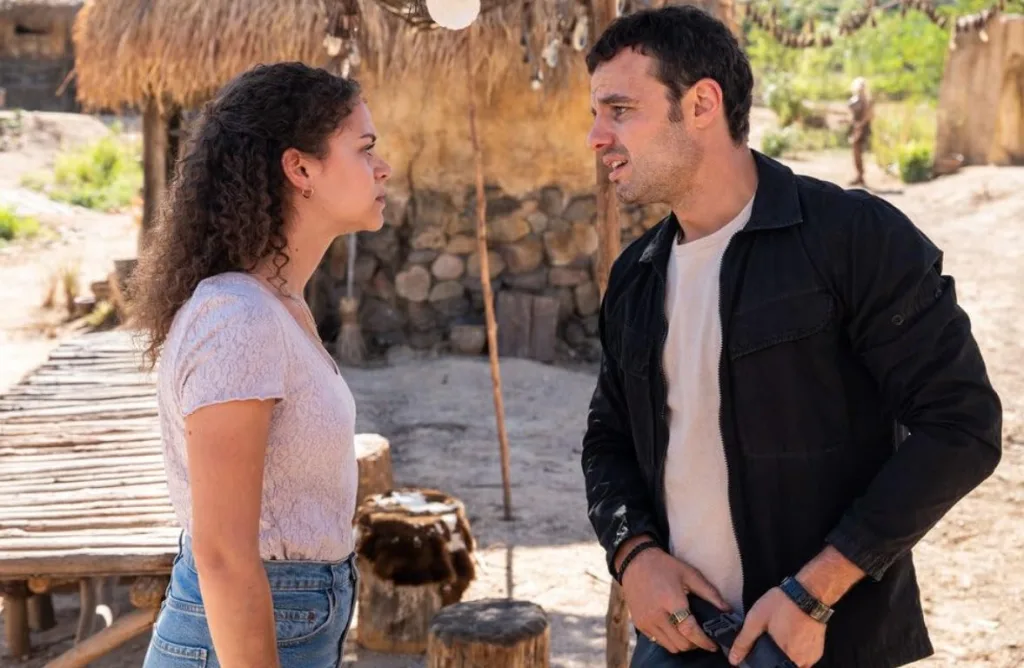
Lucas and Veronica’s couples goals are great to see, clearly sped up for the purposes of the truncated season, but hey, I’ll take a little joy where I can on this show. Also, how did it take this show so damn long to get a dog!? Finally, hoping Riley and Josh make an appearance in the next episode, since Ty is back it would give the show a new time period jump excuse.
Only two episodes left guys, I’m very interested to see how this all wraps up. Will we see James again? What about Eve? Levi showed up in the trailer for next week’s episode so…Petra too? Will the next episode reveal who has Eve? Only time will tell…
One of the biggest shifts in tone between the current iteration of Quantum Leap and the 1989 original is the unrelenting spotlight on the characters’ emotions. At its best, the current show delivers some truly powerful emotional moments, really digging into the characters’ feelings and letting the actors and writers show off how well they can tug at your heartstrings. At its worst, it just kind of gets tiresome, and everyone starts feeling a bit whiny.
If you’ve been falling my Season 2 reviews of this show, then you can probably tell by now that I’m not a big fan of the Ben-Hannah romance storyline. It’s rushed, it’s shallow, and it stubbornly refuses to address matters of consent when Ben is in someone else’s body. But I’m tired of harping on that.
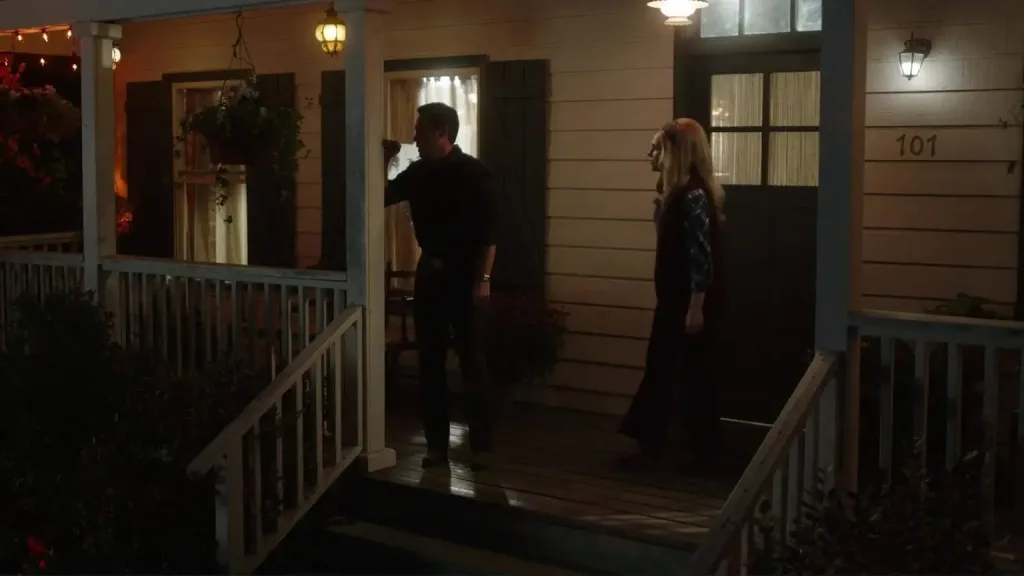
So I was actually quite glad when Episode 209, “Off the Cuff,” chose to focus more on Ben’s latest adventure, at least for the first half (even though Ben himself keeps obsessing over Hannah). Ben has leaped into an ex-cop-turned-bounty-hunter who already has his latest quarry, a sleazy lawyer with shady clients, including a dangerous arms dealer. Problem is, the lawyer, Kevin, has also double-crossed said arms dealer, and in the original timeline, he escapes jail only to be horrifically tortured and killed. So Ben’s job is to deliver him safely to jail.
Kevin, though, doesn’t make things easy. Not only does he keep trying to escape or bribe his way out of the situation, but he’s incredibly obnoxious, promoting a philosophy he calls “radical selfishness.” Truly, he tries Ben’s (and the audience’s) patience. I did enjoy how the show made fun of its own formula, when Ben wonders aloud whether the person he’s supposed to help this time has any redeeming traits. We’re treated to some fun action sequences as Ben and Kevin dodge the bad guys, and I was like, “Yes, please, this is the show I’m here for!”
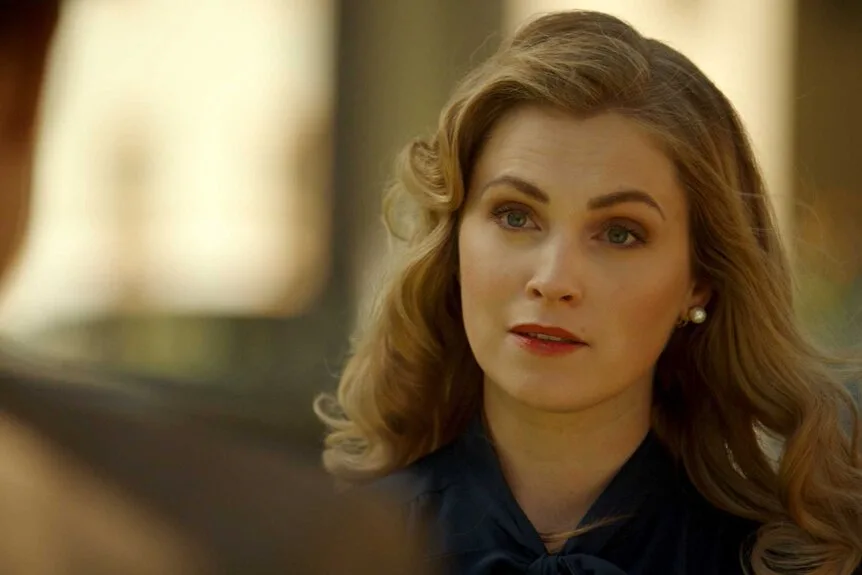
Except then he has to go all gooey-eyed over Hannah again, and it’s seriously tiresome (and I’m usually a romance fan!). Makes me want to put on my Regina George voice and say to the writers, “Stop trying to make Hannah happen! She’s not gonna happen!”
Meanwhile, Addison is wrestling with her own feelings, over seeing Ben fall in love with another woman while trying to figure out where she stands with Tom. And then there’s the mysterious clue that Tom dropped about a possible way to bring Ben back.
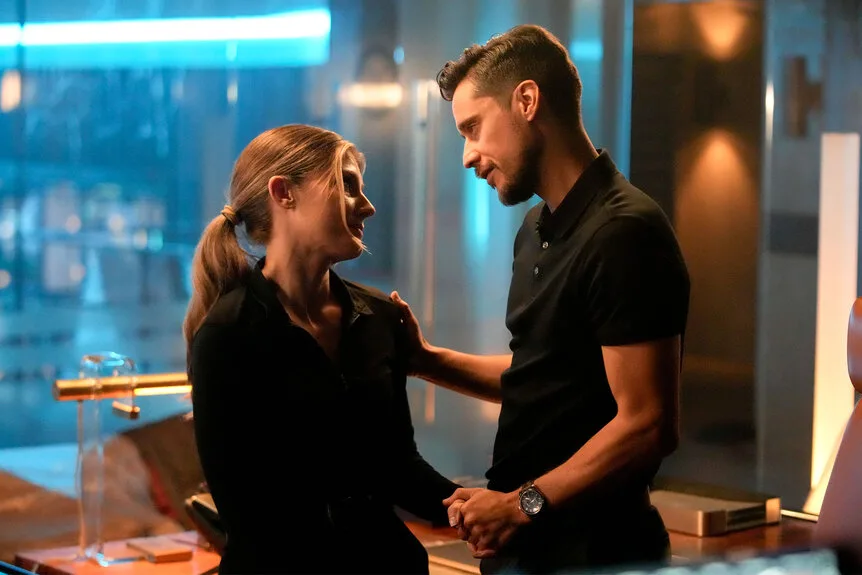
Look, I’m glad that the show is trying to give the characters emotional depth, but this week’s episode was a bridge too far in my opinion. All the romance stuff felt distracting (and, after weeks and weeks of non-stop moping from both Ben and Addison, downright whiny) from what was otherwise a pretty sharp action-adventure episode. I wonder if the show is suffering from its season length; maybe if it had 26 episodes to fill, instead of just 18, it could space out the romantic crap a bit more, with a few episodes where it doesn’t feature in between.
As it is, I groan each time Hannah shows up (no offense to the actress). Based on where the episode left off, we aren’t rid of her yet, and based on how the season trajectory seems to be going, we probably won’t be rid of her until the end. Which means I’ve got to slog through 8 more episodes of this nonsense… God I hope at least 2 or 3 of them have no Hannah at all. Because my patience for that character and the related storyline is gone, and I could use a week where we go back to worrying more about changing history for the better than Ben’s lonely heart.
3.5 / 5 stars – The action stuff was really quite good!
Tuesday’s La Brea episode did indeed take us back to 2021, though not for anything too interesting. Perhaps I’m expecting too much, but let’s break things down and see.
In 2021 Ty and Sam have explained shit to Gavin, who is not very receptive. To the point that he bails. Now it’s a hunt for Gavin.
Back in 10k B.C. Sam and Gavin head out on a recon mission that goes south quickly. First, it’s a woolly rhino, then a mine field, and finally just a good old-fashioned guy with a gun (congrats on making onto the IMDB, Aaron Cottrell!).
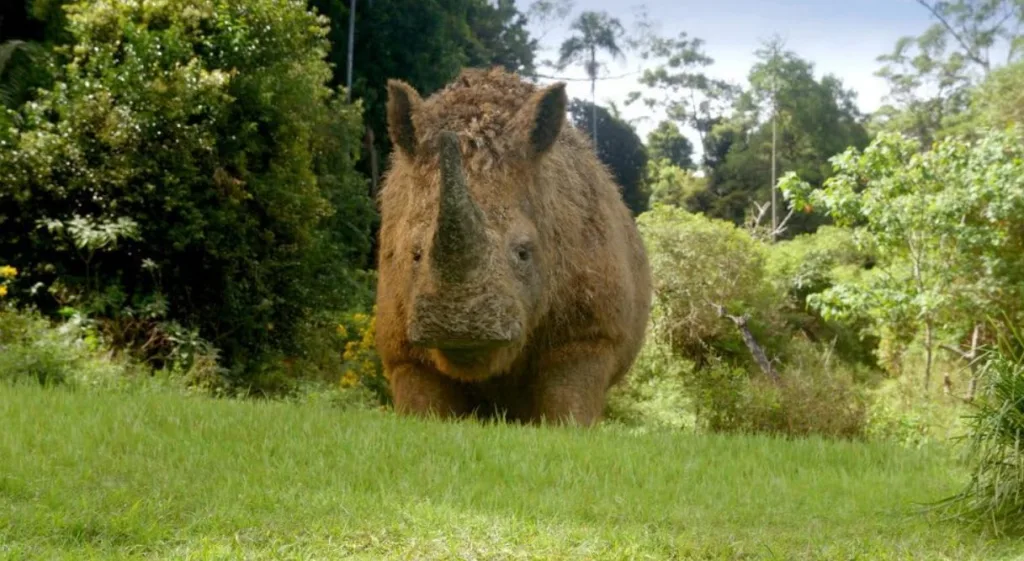
2021 reveals a second mission: Ty wants to help his estranged ex-wife (Sophie played by Annabelle Stephenson). She’s an alcoholic, like Gavin, and rebuffs his efforts, like Gavin.
Meanwhile, a lot is going down in 10k B.C. For one thing, Lucas has political ambitions – you know, for the good of the people. Unfortunately, Veronica’s efforts to help don’t work out as planned. Sam and Gavin get rescued by the very lady they’ve been looking for, Maya! She gives them some answers, explaining she, Gavin, and a bunch of other pilots were part of a government project to weaponize time travel. It’s why Gavin’s memories are missing. Maya’s job was to erase the pilots’ memories to keep the project hush hush. Maya was planning on whistle blowing but the government got wind and dropped her and Petra in 10k B.C. Lastly, we’ve got Izzy having a day out with Leyla. Although her mom introduced her as a warrior with a tone of pride, Leyla says her mom would rather she study council biz. She wants to bag a boar to prove she’s a good warrior but when her and Izzy come upon one, she winds up in a tar pit. As she gradually sinks and Izzy tries different methods to free her, Leyla opens up about her self-doubts and how her recently deceased twin brother was the only one who believed in her.
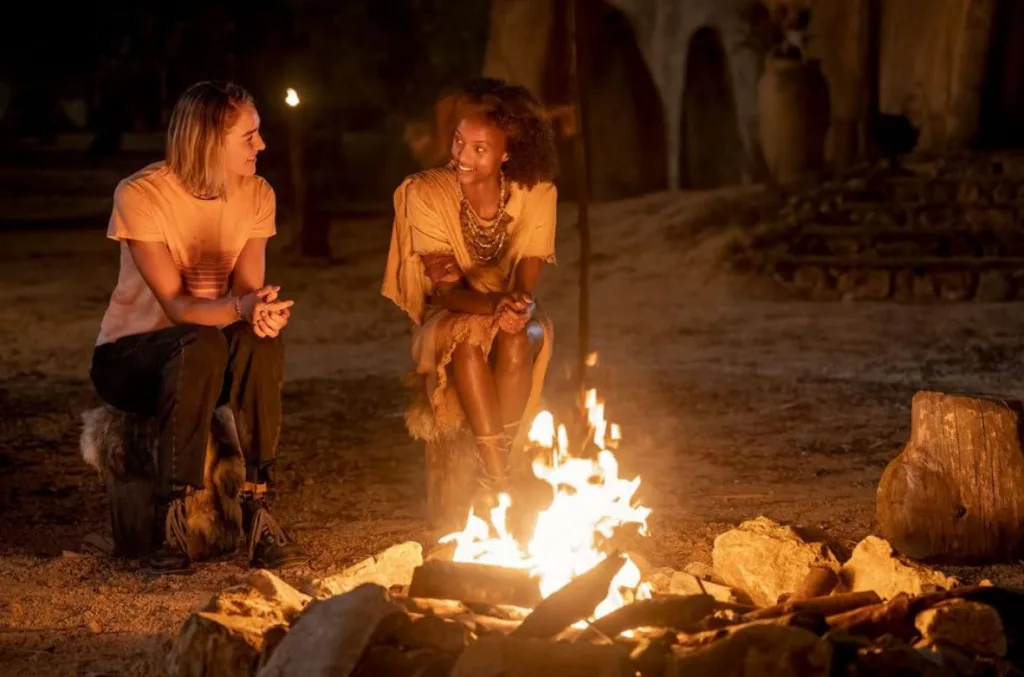
Far in the future of 2021, Ty meets with Sam who has found Gavin in a bar. Though Sam tried talking to their drunken friend without success, Ty lays down some tough love. He reveals the tragic soon to be fate of his ex-wife and how she won’t listen to him, then tells Gavin he’s a coward for not facing his problems.
Gavin’s 10k B.C. self isn’t having any easier of a time. Maya says she can use magic mushrooms to unlock his memories. Sam is skeptical but Gavin goes for it. Lucas has his ambitions crushed when Veronica reports that she got the council seat invite. It’s, uh, causing tension of course. On a happier note, Izzy’s rope idea to rescue Leyla succeeds, and just in time because a boar shows up and nearly spoils the win. In a reversal of fortunes, Leyla’s arrow is true and the boar itself becomes spoils.
2021 Gavin shows up at Sophie’s doomed AA meeting letting out his truths – one of which is to stop pushing away people who want to help you. It gives Sophie the guts to hear Ty out.
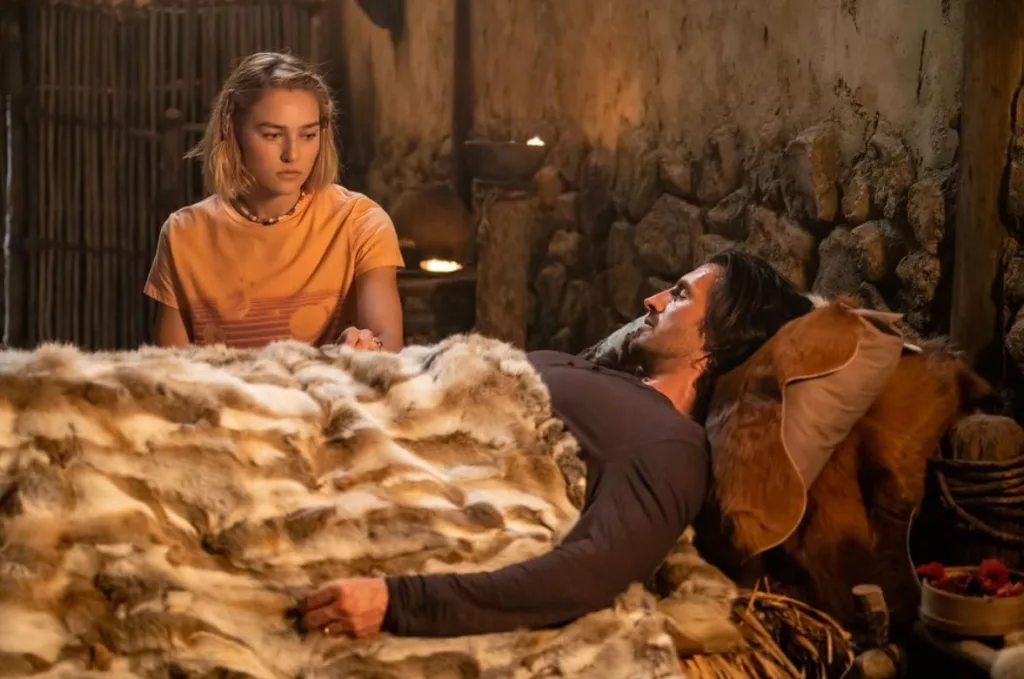
10k B.C. Gavin’s ill-advised mushroom trip guided by Maya technically bears fruit but also causes him to have a seizure. He gets some rest and when he’s awake him and Sam discuss what he remembered. He stole a microchip, and it’s possible the person who said they’d help find Eve is really just after his memories and that chip.
Finally, 2021 sees Ty and his ex-wife talk it out, and the three men pack into Sam’s car on the way to form a plan. But a mysterious woman follows them!
Overall, this is an OK episode. Not my favorite, but I didn’t hate it either. I was just “meh” about it. The 2021 storyline was necessary with regards to Gavin sure, but did we really need the stuff with Ty’s ex-wife? I suppose the answer is a reluctant yes, because it helps Ty break through to Gavin, but still… it didn’t need to be as many scenes. You could have just done the bar scene where Ty explains what’s going on, and the AA scene. Even that final scene with her could have simply been him tucking her into the car after they’d talked. It really didn’t add much in my opinion. It felt like forced filler.
On the 10k B.C. side you’ve got Sam and Gavin’s adventure, which at least gave us Maya and a huge piece of the puzzle in terms of Gavin’s buried memories.
Leyla, another new character we didn’t really need, does provide the show with a new LGBT couple, since the one from the first season died? It’s a question because I genuinely don’t know what happened to them. They just straight (pun!) disappeared. I will say the relationship also gives Izzy something else to do besides be petulant, and while it does feel forced, I think that’s a final season 6-episode issue more than anything. My guess would be the original idea was to have this build up to mid-season, an adorable side story of finding your person, but c’est la vie. As they say, you know when you know, so good on you girls!
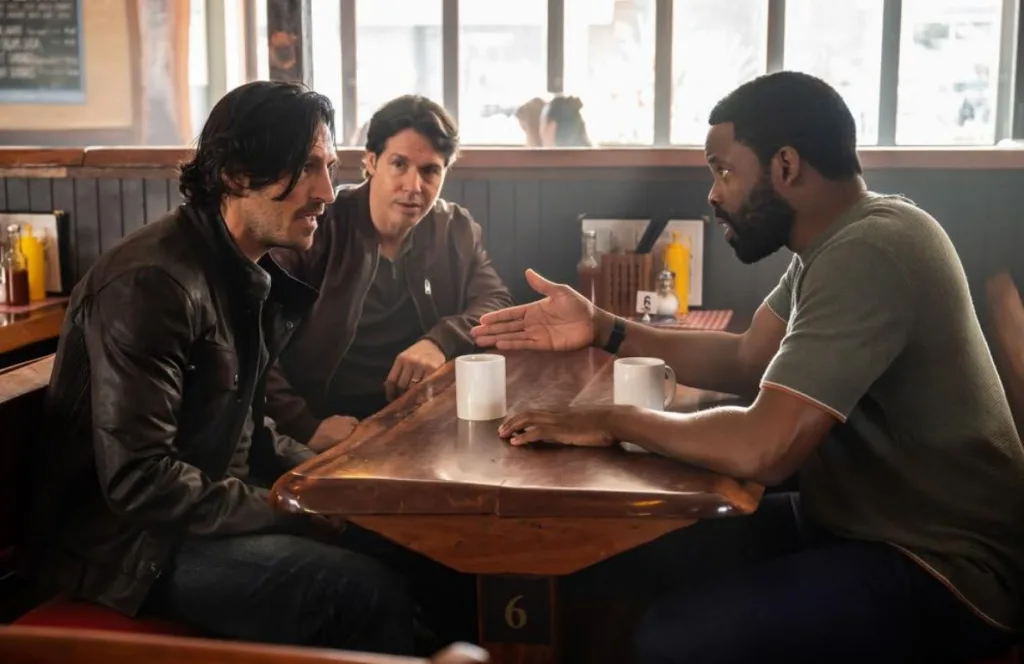
Finally, there’s Lucas and Veronica’s unintentional power feud. I get heavy Lady Macbeth vibes here, but that might not be fair as initially Veronica isn’t pro Lucas wanting to join the council. Nor does she push him to do so. Which means, society has trained me to be suspicious any time a woman finds herself in power. Bad society! Frankly, the entire plot has some good criticisms on society. The fact that Veronica gets picked over Lucas is shown as being about Ruth seeing Veronica’s ability to reform someone like Lucas, but is it also because Veronica is a woman? Don’t misunderstand, I’m not saying this as a negative, merely an observation that if the council member was a man, he’d probably have picked Lucas. Because it’s a woman, she’s more inclined to choose a woman. That’s a good thing, it’s literally why representation in hiring matters. Is that giving too much credit to this insane high concept network show? Maybe, but I’ll take my wins where I can. More likely it’s just a convenient way to create tension between a happy couple. The other part of this that tickles me is Lucas’s reaction. He’s genuinely shocked, not because he doesn’t think his girl can handle it, but because he’s the one who wanted it. Still, Veronica is the one who actually talked to Ruth. I honestly have to say her level of defensiveness to Lucas’s reaction is perfect. Even the passive aggressive way they leave things is on par. Gotta give it up for the acting here, especially since this show isn’t prone to subtle interactions often, so if you get your shot you better make it count and boy, do they!
Now that we know the time travel side of things is a government conspiracy it does leave some questions. Like, how did Gavin’s mom and dad factor in? Did they? We still haven’t heard anything from the sinister sister we were warned about. Also, where are Levi and Petra? This season has been cutting loose plot lines like a hot air balloon shedding sand bags so it can rise higher. Will they be able to pull off a satisfying conclusion in the next three episodes? Especially considering this episode felt like largely a waste. Not to say relationship goals don’t matter, but they tend to be a long game play, and frankly we ain’t got time for that!